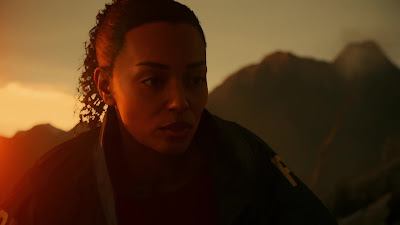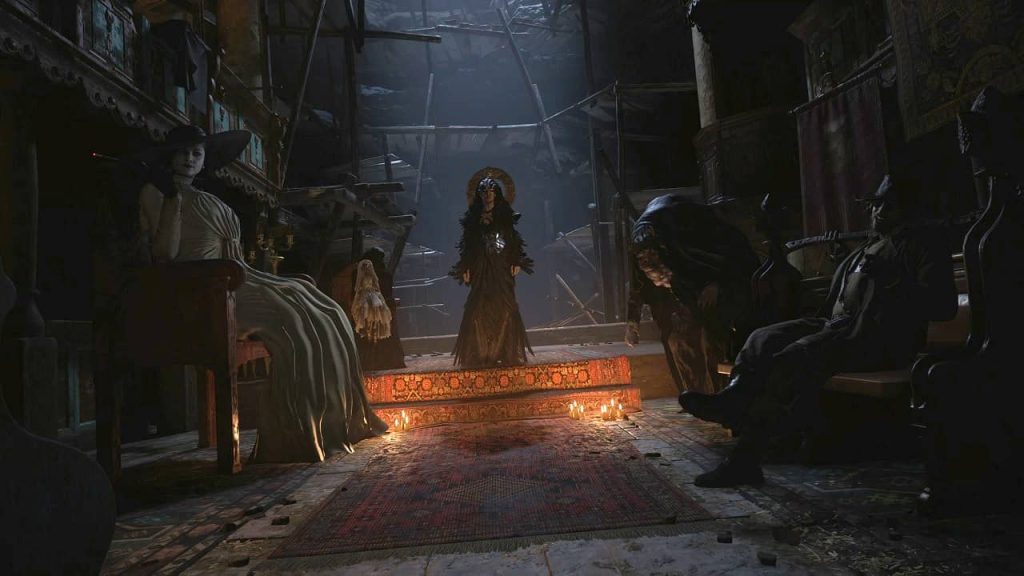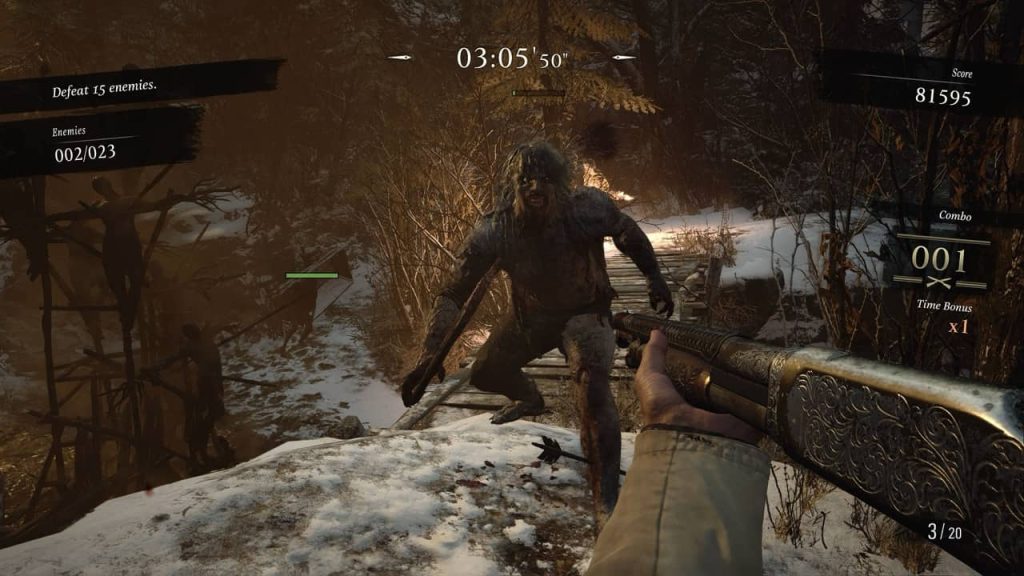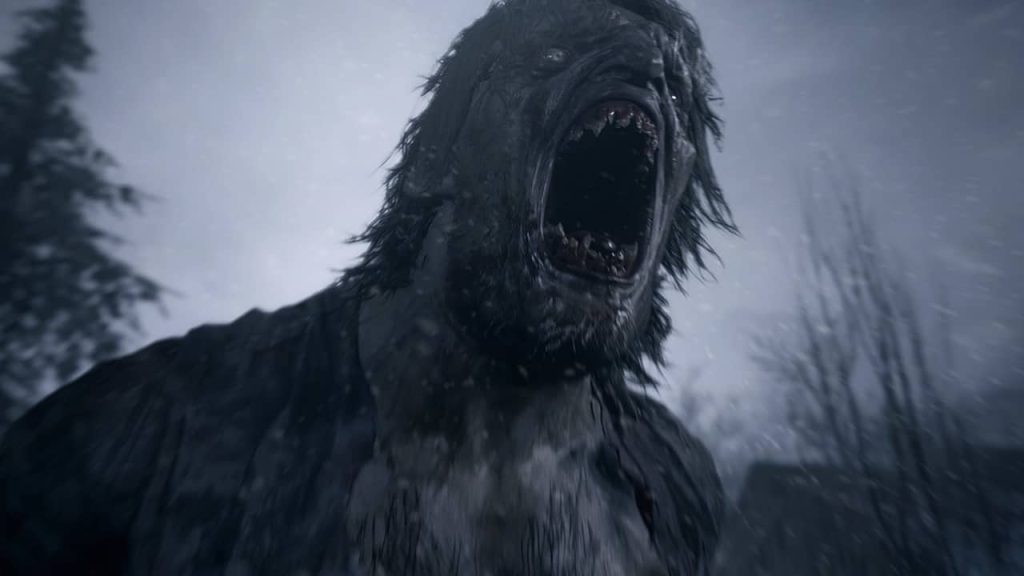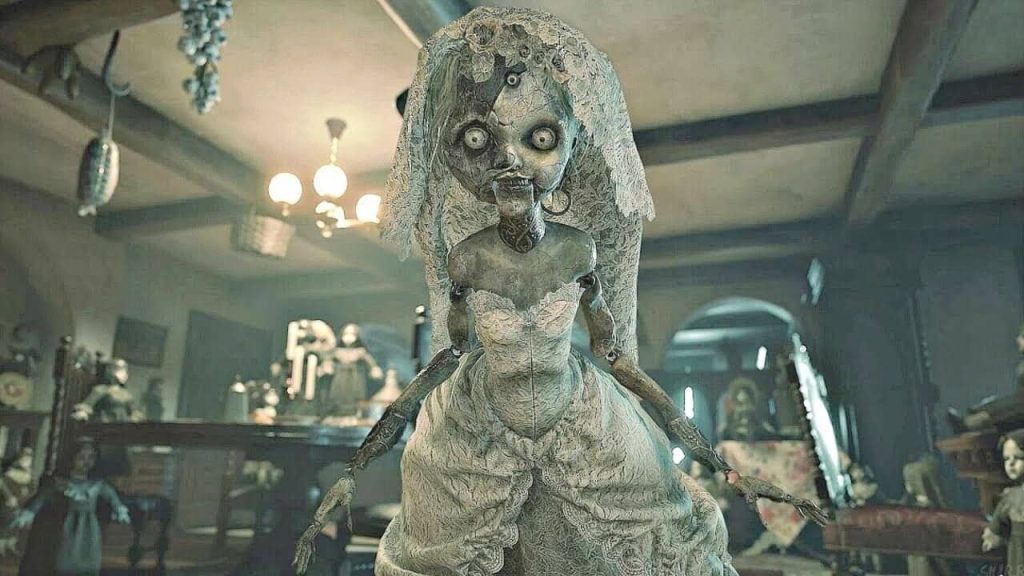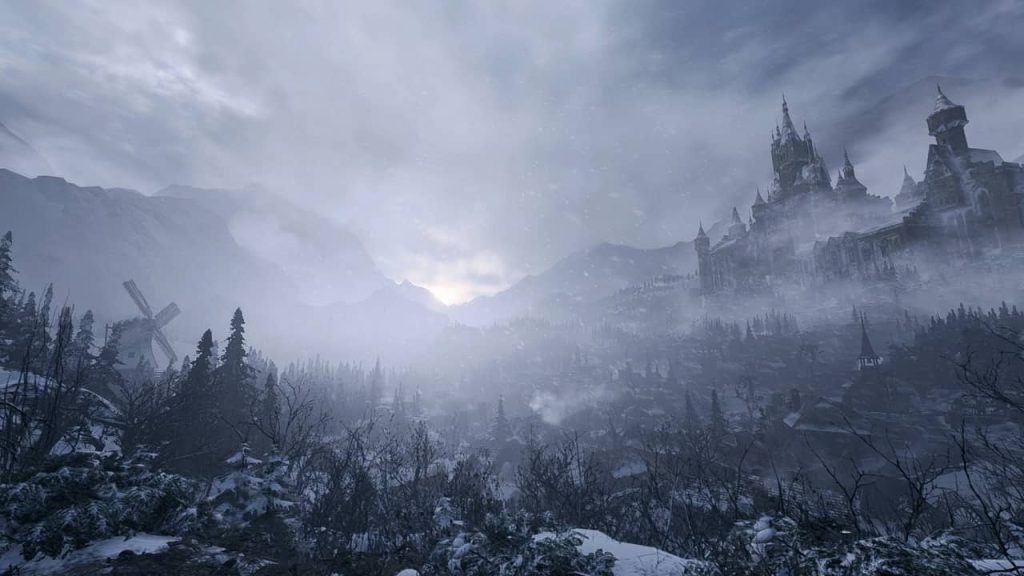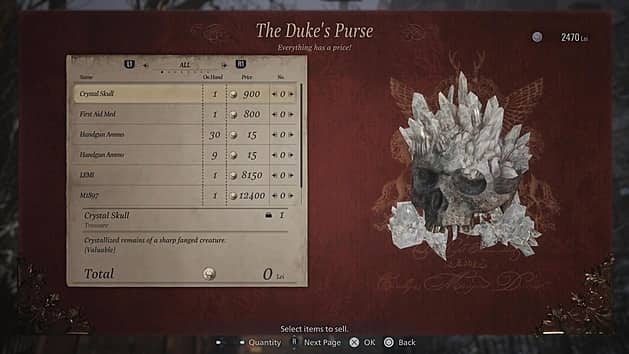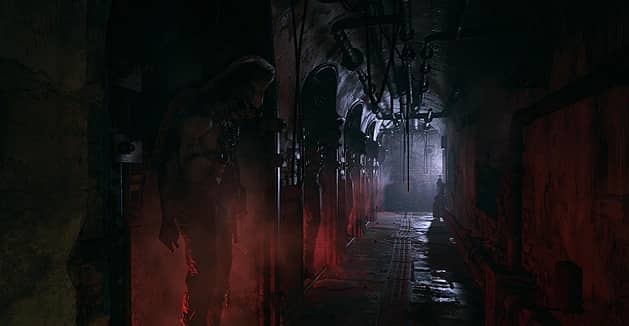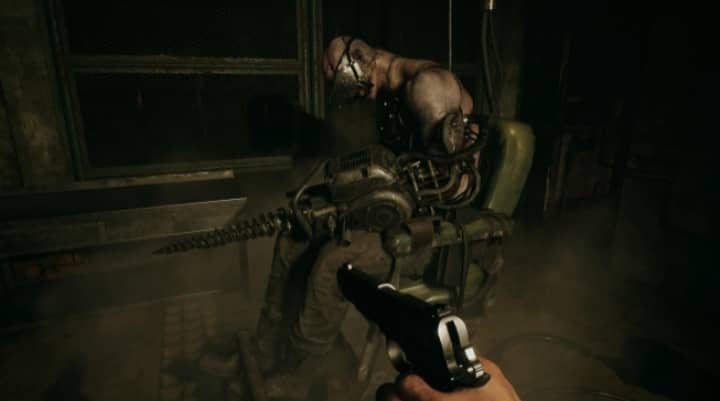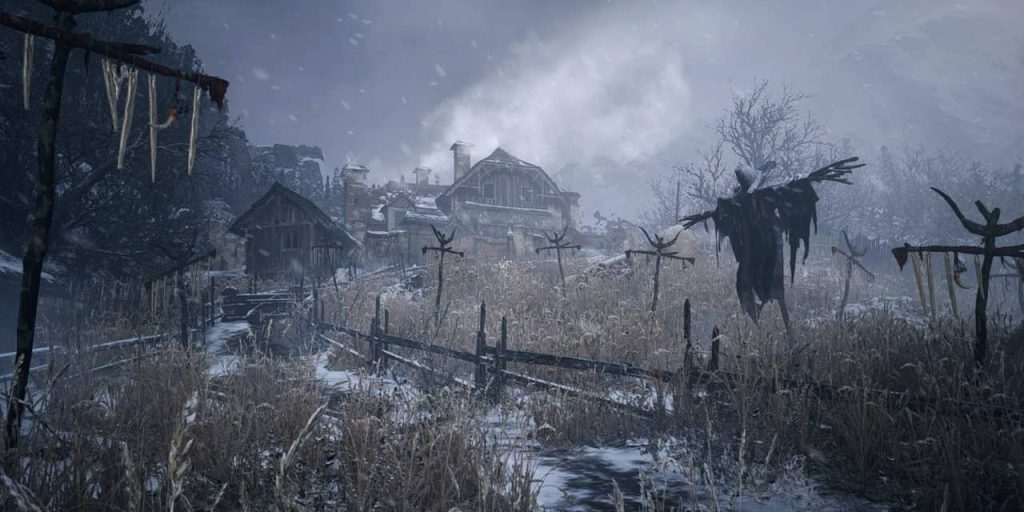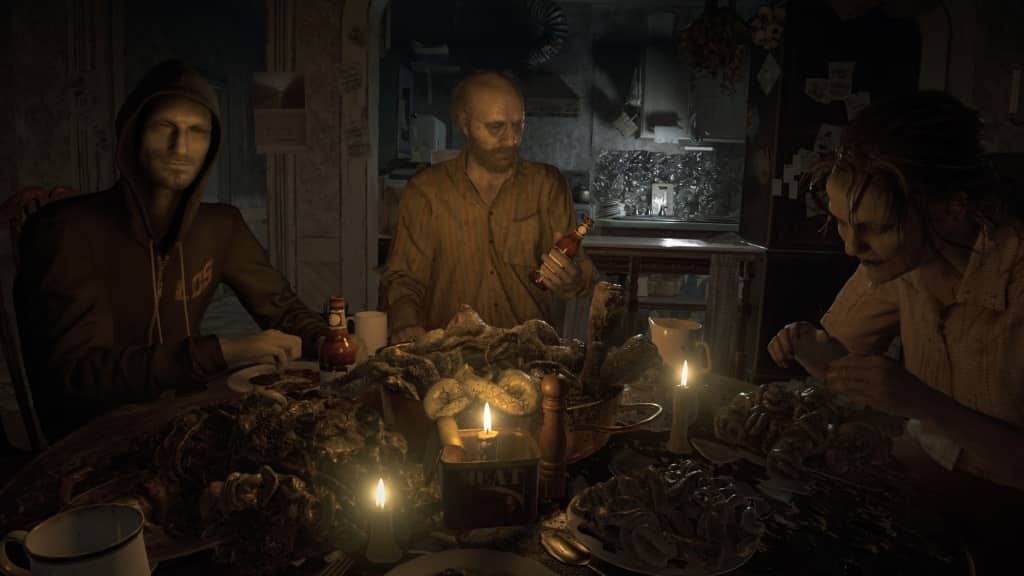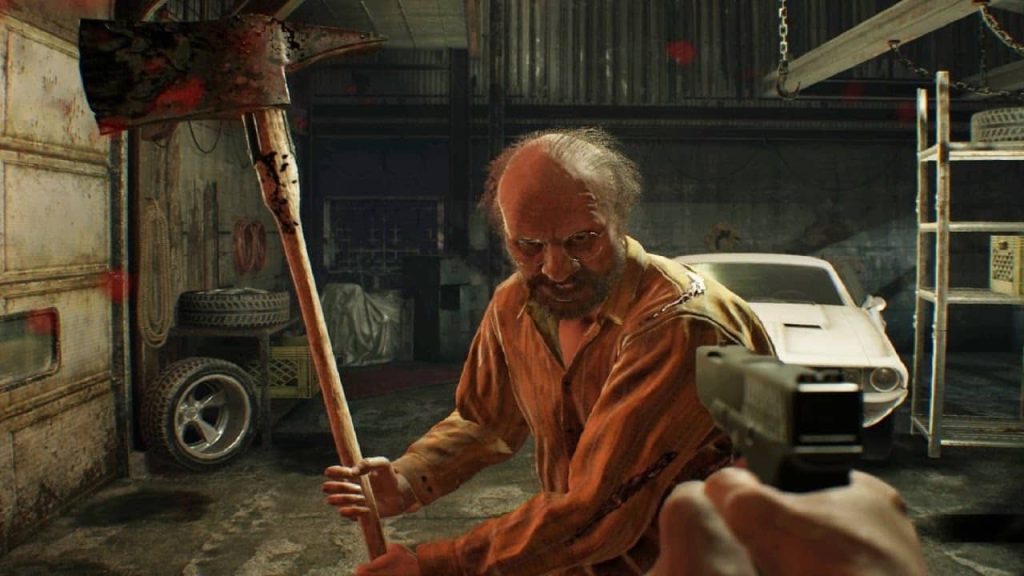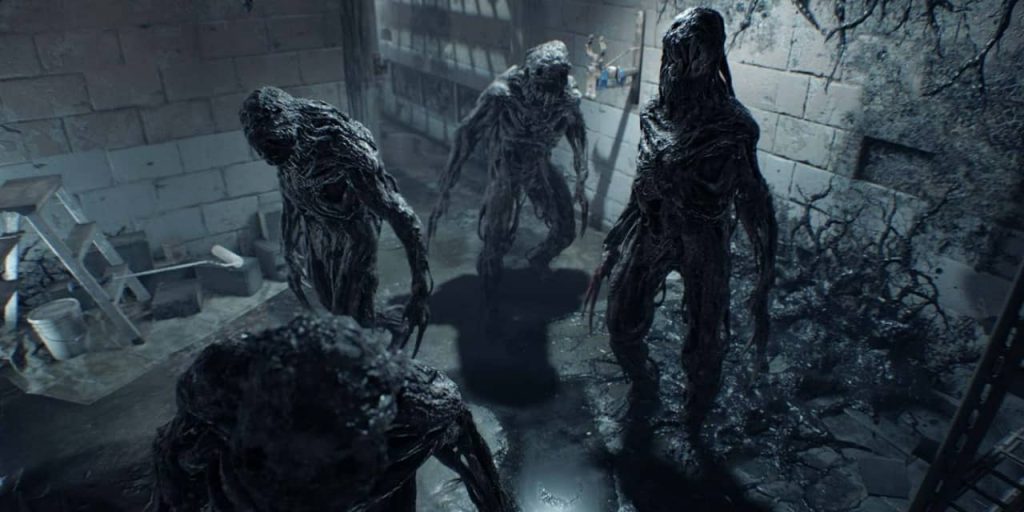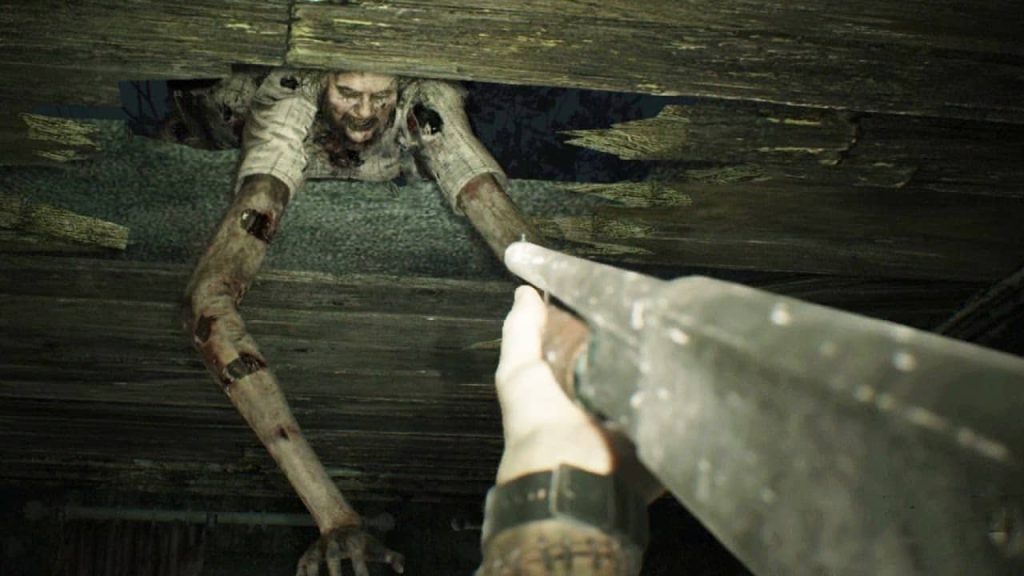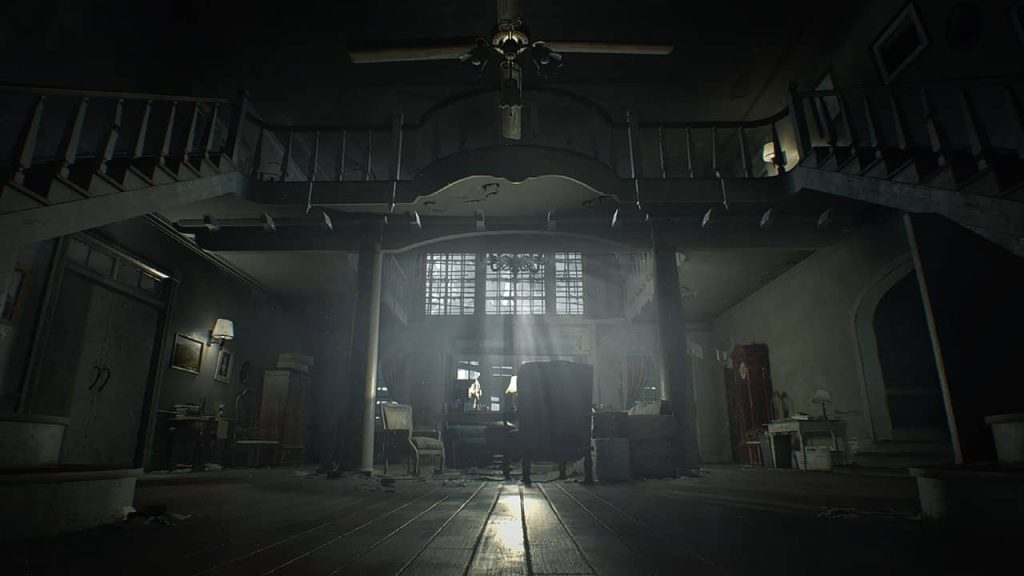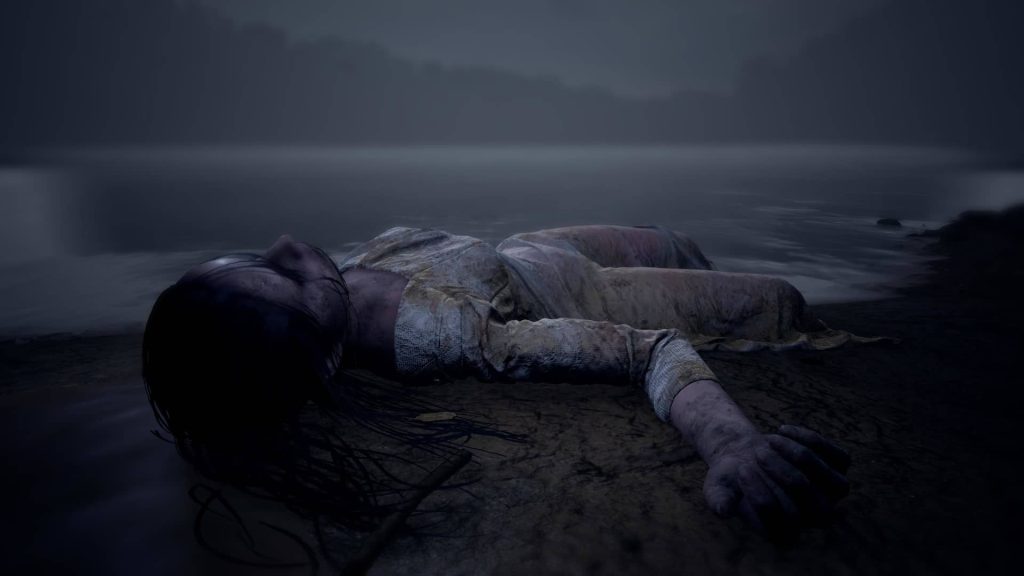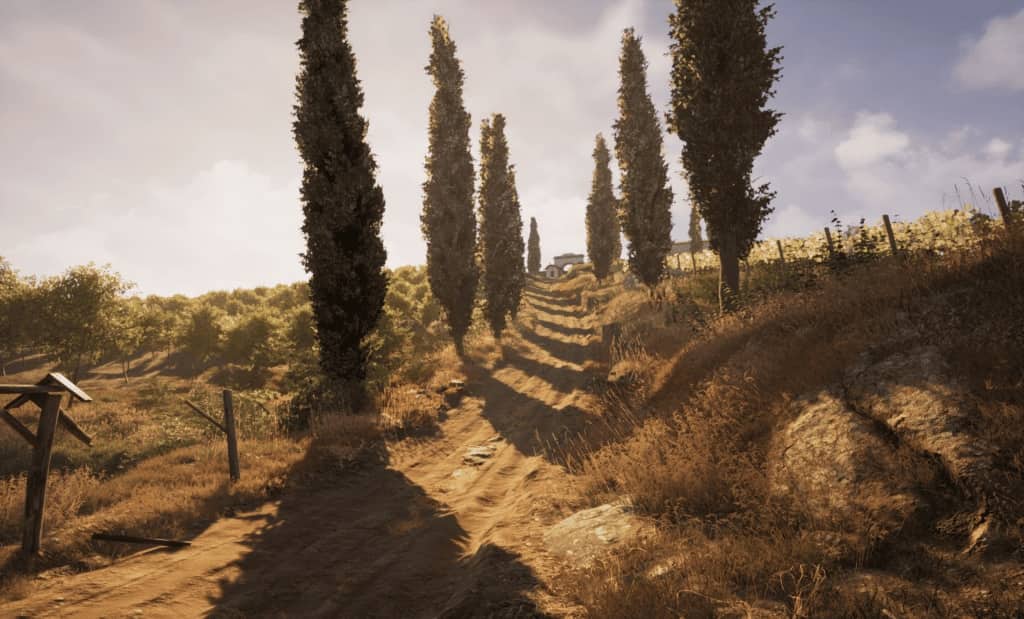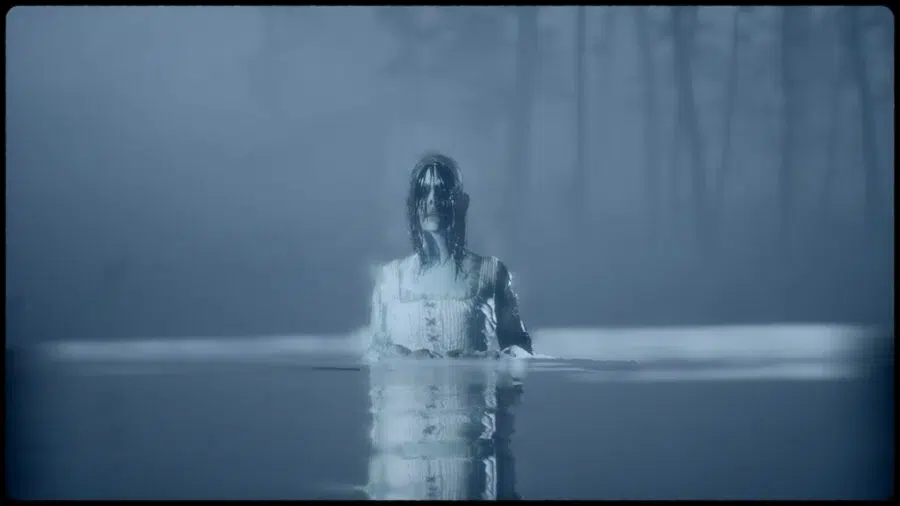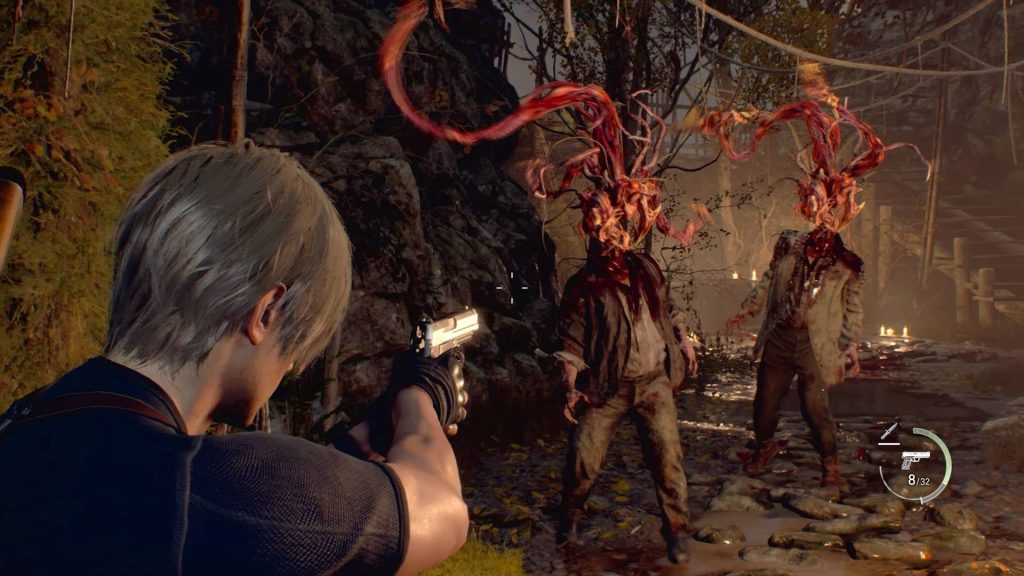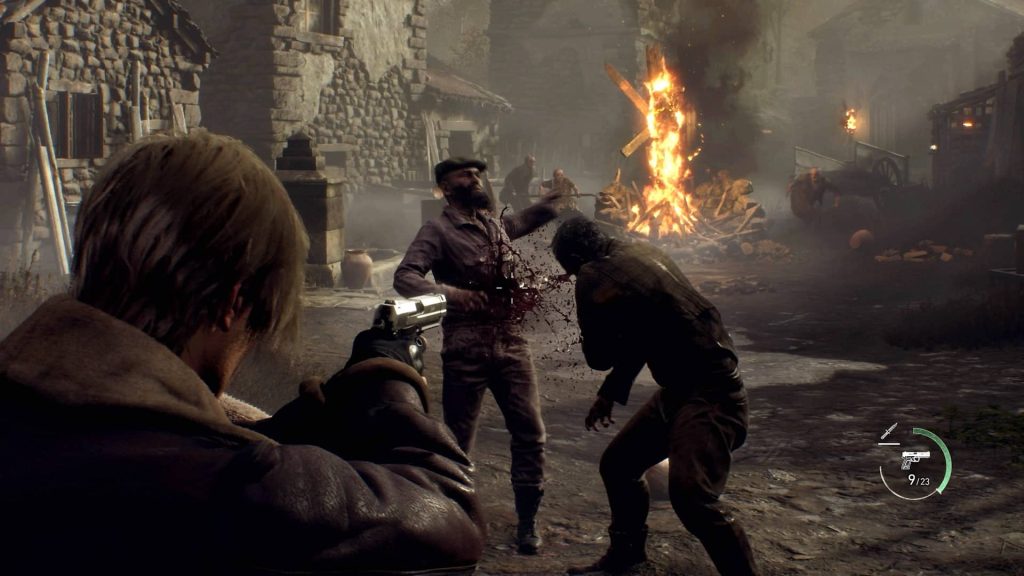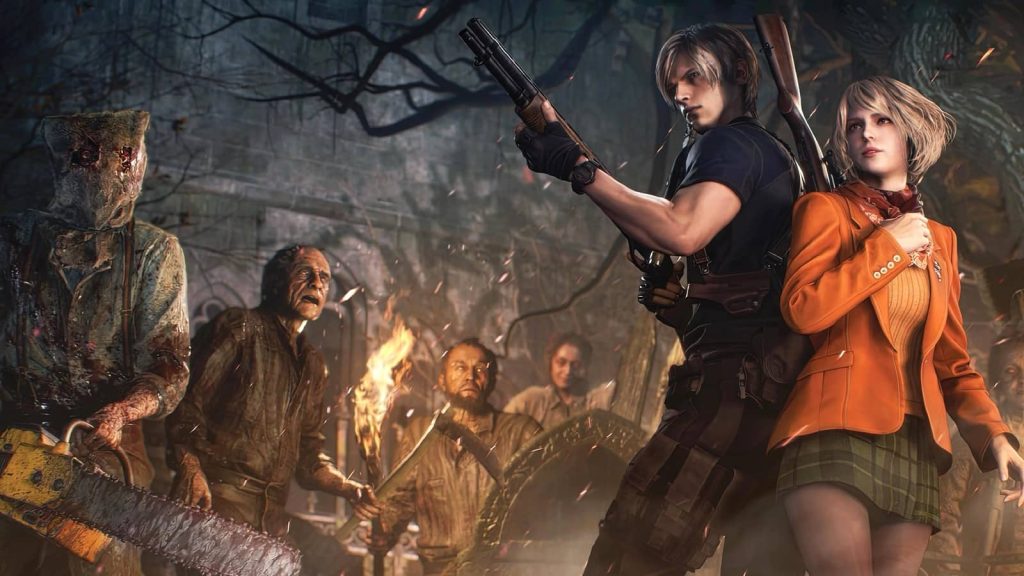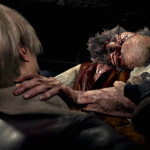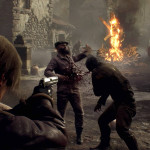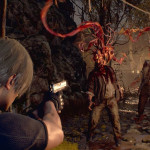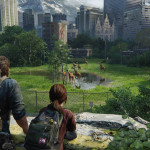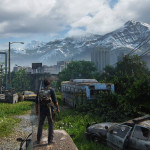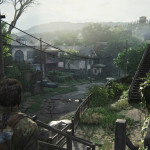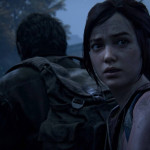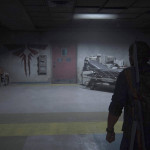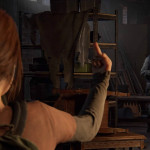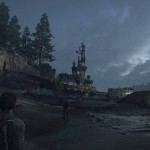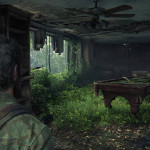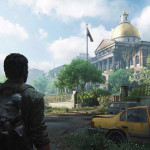Zobrazení pro čtení
Alan Wake 2: An Iconic Story-Driven Horror Video Game
Alan Wake 2 was my "Game of the Year" winner, and this is from a gal who enjoys horror games and movies. I've made my opinion after playing its predecessor and this one, and if you have an idea of both, meaning if you played them then you will probably have a better understanding of the evolution of this franchise. Everything about Alan Wake 2 made it fantastic and I could stay here praising it for a long. However, I have some favorite aspects: its graphics are some of the best I've seen, and its reference to Twin Peaks - in particular The Return - was truly exceptional (if you get it). Just play both games and don't be let down by the bad reviews before making your own idea: I guarantee it will be worth it! You won't be sorry you did purchase it.
10/10 for Story and Graphics
The story of Alan Wake 2 is impressive, after all, this is a cinematic experience packed as a video game, so we should expect a great story/script and excellent visuals. But nothing prepared me for what I found: expect unexpected plot turns that you won't anticipate and an immersive dark, mysterious atmosphere to keep you guessing and constantly on edge. It is easily one of the apex Xbox horror games and nobody can deny it. Graphics? Simply stunning. Like entering into an immersive nightmare. Seriously, lighting effects alone should receive recognition. Alan Wake 2 is an immersive experience in a mysterious and nightmarish first-hand experience that excels in its way.
Stop Complaining: It Is the Story that Makes the Game, not the Action!
Some fans of the original game are complaining about how different its combat is this time around; but here's the deal, sweeties: this time around the story takes center stage - think of it like an interactive thriller with just enough combat to keep things interesting - which was ultimately true of its counterpart's fights as well. Plus... you remember it wrong as in the first Alan Wake, it wasn't exactly spectacular either. I'll say that from the narrative and atmospheric points of view, Alan Wake 2 is hard to match, in any case, one of the two three games that are way above the others. At the same time, I can understand why action-driven players who were looking for a "Last of Us" kind of adventure are not fulfilled. It is not that kind of game.
A Solid Narrative Performance Worthy of GOTY
Alan Wake 2 is more like Resident Evil: Village but much stronger in visuals and even if the gameplay is not taking central stage in either one of them, I feel that Alan Wake 2 comes better in comparison. I know you want to be sure before you get it, and this is good practice anytime you buy Xbox games. But the bad reviews are so much off the point. About Alan Wake 2, some reviews have expressed displeasure with it for being too "woke" or racist, however, these complaints shouldn't be taken too seriously; these trolls are simply trying to stir things up; real gamers, those who appreciate an impressive narrative experience with stunning visuals love Alan Wake 2. Simply stated.
Conclusion: A Suspenseful Story for Fans of Story-Driven Horror Games
Once again, Alan Wake 2 has proven its mettle by keeping my pulse racing! I have already experienced more thrilling moments than I can count, making me jump more often than necessary and loving every scary minute! For fans of suspenseful stories with stunning graphics Alan Wake 2 should not be missed; don't let the critics dissuade you! Just remember this is a story-driven experience so buckle up for one helluva ride; easily one of my top games played this year (trust me: this blonde bombshell has seen many games!) I highly recommend it ;).

The Outlast Trials: An Incessant Descent into the Grotesque
The Outlast Trials isn't your usual horror game; rather it offers an extreme sensory deprivation chamber full of human darkness for players to endure. Three minutes in, and I felt as if I'd stepped straight into a nightmare: naked bodies sprawling everywhere were hidden by sheer horror... Sexual imagery? Check. Every form of abuse? Yep! These developers didn't hold back in throwing every insult at us to see which would stick - trust me; many do!
An Unpredictable Reality
It's a strange game. But here is the thing: it works. This barrage of depravity doesn't feel empty; rather it serves a greater purpose: creating an unpredictable reality where nothing makes any sense and paranoia reigns supreme. This is the way it goes and you should buy The Outlast Trials. Where no matter who we trust or what's real around the next corner it could lead to something truly horrific originating in twisted scientific experiments conducted by Murkoff Corporation during Cold War times - we were lab rats used as part of their experiments!
Nightmare Experiments
Paranoia runs deep; you never know who or what horror could spring forth next from the experiments by Murkoff Corporation during Cold War times with whom nobody trusted and never knowing who could trust or what could come out of scientific nightmare experiments in mind of Murkoff Corporation during that era Cold War times we saw some truly horrific things and monstrosities produced within, from scientific nightmare abound.
The First-Person Perspective
Its true charm lies in the first-person perspective: everything is seen through your character's terrified eyes as every creak of floorboards or flicker of fluorescent lighting could spell disaster for them. There's no Ramboing your way out here; survival relies upon cunning, resourcefulness, and remaining rational as soon as possible. It makes you feel the pain and scare... it feels personal. If you buy PS5 horror games, The Outlast Trials is there, at the top, with the best! Desperation can be palpable as other test subjects cling desperately to any hope Murkoff offers, even if that means participating in horrific "therapies". It's an unnerving commentary on human resilience - or lack thereof.
A Brutal Game for Horror Fants
The Outlast Trials may not be for everyone; its brutal, disturbing gameplay may leave you questioning both your own sanity and that of your character. But for horror enthusiasts looking for an immersive horror experience that forces them to confront humanity's darker forces head-on then this should definitely be played; just ensure your schedule allows enough playback time, or have someone on speed dial for assistance should something arise that may need therapy afterward.
A Haunting Atmosphere
Atmospheres of desperation reeks with fear, yet are haunted with longing. Acts so repugnant to our humanity make one part of ourselves recoil in horror while another part can't tear itself away, riveted to what's unfolding horrors around them. We stand witness to acts so revolting they bring tears of horror down on ourselves yet we still cannot look away; some things simply cannot be turned off our attention!
Conclusion
The Outlast Trials presents players with an unparalleled cinematic horror experience as they plunge headlong into their personal darkness, forcing them to explore every twisted corridor of human psychology and confront its shadowy depths head-on. There is no way fans of survival horror games will skip this game, even those who usually buy cheap PS5 games will have to consider playing it. A visceral encounter beyond mere entertainment; its unforgettable impact will remain with all brave enough to experience its dark depths.

Alan Wake II - A Dark Narrative
Alan Wake II emerges in the aftermath of some previous events, after a thirteen-year interlude, and its narrative tendrils reach from its predecessor's vague echoings into the present. Now inhabiting Bright Falls is Saga Anderson - an FBI agent caught between malevolent cult activity and macabre murderousness; herein resides an exploration of Alan Wake II's unique attributes where its menacing atmosphere merges seamlessly with next-gen gaming technology.
Unleashing Fear-Inducing Atmosphere
Alan Wake II stands among the best horror games as an atmospheric masterpiece ready to create yet another engaging adventure full of fear that is better than ever. In the traditional horror genre, Alan Wake 2 seems not content to simply focus on a few scare tactics alone as many competitors do. Alan Wake II explores all manner of disquieting emotions with each subsequent step through its labyrinthine depths - fear in various guises is presented one after the next - all the while treading carefully along an ever-shifting tightrope between horror and intrigue - something no other game dare attempt!
Enigmatic, Dark, and Visceral
Alan Wake II opens with an unsettling shockwave so you will know from the start how the game stands. Its opening scene serves as an abrupt awakening, it's meant to shock you, and is no surprise that hits like an electrical current to all five senses. This is not an ordinary introduction, clearly, but a visceral experience meant to intrigue and scare you, sending this way the right message for the rest of the game. The opening scene draws players directly into its world of mystery and action - a great narrative device that hits the right notes, and if you buy PS5 games, you will admire its accurate psychological gameplay designed to set players on an unforgettable adventure ahead.
Discovering Breakthrough Dark Visuals
Alan Wake II stands apart thanks to its visual delight and is an epiphany of next-gen potential that shows quickly that it's not a commonplace anticipation. Alan Wake II on PlayStation 5 not only boasts impressive graphical capabilities but manages to build a captivating bleak and mysterious world with each pixel adding another brushstroke on a canvas of desolate magnificence - providing us with not just another step forward in gaming but also taking us a quantum step towards aesthetic opulence, where virtual and real realities merge into an indistinguishable tapestry of aesthetic grandeur.
NPC Alchemy: Incredible Facial Expressions
Alan Wake II's narrative alchemy, maybe less observed, rests in good measure upon its Non-Playable Characters (NPCs). Their mesmerizing facial animations not only capture player attention; they offer subtleties of life that bring Bright Falls residents to life digitally. Their emotions play out like masks; each expression adds color and depth. These facial animations transcend the mundane; they represent how far storytelling technology can take us.
Nerve-Wracking Combat
Alan Wake II features an intricate combative design not easily translated to its counterpart in other games, even if combat is not the primary reason to get this game. It's an ever-shifting ballet of nervous tension that keeps players gripped and on edge from start to finish, so if usually buy PS horror games for their atmosphere and narrative, you will like it (less for everything else). Fights don't simply involve physical clashes but psychological duels where every encounter has an underlying sense of unease attached. Furthermore, its combat doesn't indulge in gratuitous violence but rather acts as a calculated strategic ballet with each move planned out as a calculated gambit; and nervous tension is not simply an aftereffect but instead deliberate choice that turns every skirmish into an immersive exploration of survival!

Alan Wake 2: A Terrifying Survival Horror
Alan Wake 2 pushes forward its predecessor's menacing atmosphere by venturing deep into survival horror's terrifying depths, offering players an exhilarating, yet terrifying, journey through its macabre landscapes. Alan Wake 2 is a survival horror game that ranks best at storytelling and atmospheric horror, taking players beyond mere creepiness into its depths of horror! By far, Alan Wake 2 is one of the scariest horror games available now!
FMV and In-Game Mastery in Concert: An Artful Symbiosis
Alan Wake 2 achieves an unprecedented balance by artfully merging Full Motion Video (FMV) and in-game content into an artful symbiosis. more than simply a random juxtaposition, this dance includes live-action sequences and interactive gameplay combined into an exquisite visual feast. Alan Wake 2 was designed to survive time, I'll say an iconic video game made for players who buy PS5 horror games more than anything. The symbiosis between the narrative power and FMV is complete, and the result is a realistic experience (I don't even know how to name it, but you get the gist - it feels alive).
FMV breathes life into characters by giving an uncanny realism that blurs virtual and tangible realities - this is why it feels alive/realistic (and I know, it sounds odd to use "realistic" in a game with supernatural beings). When you buy cheap PS5 games, you do not get the kind of FMV and storytelling Alan Wake 2 offers (nor gameplay, characters, or atmosphere for that matter). Alan Wake 2, more than anything, creates an unforgettable emotional experience (in the sense that it immerses you and convinces you) through haunting imagery combined with interactive elements coexisting in perfect harmony evoking emotions long after the controller has been put down!
Alan Wake 2 vs. Resident Evil 7: Biohazard: Crafting Horror from Different Dimensions
I would like to compare Alan Wake 2 with Resident Evil 7: Biohazard to detect their distinct approaches to horror because they seem similar but there are nuances. Resident Evil 7, with its immersive first-person horror and atmospheric tension, finds an unlikely partner in Alan Wake 2, which features third-person survival horror gameplay. This aspect elevates the horror experience to another level.
Resident Evil 7 immerses players in an oppressively-confined mansion while Alan Wake 2 offers expansive environments requiring careful navigation and strategic thought. If I had to choose, I would buy Alan Wake 2. Both games excel in inducing fear, but Alan Wake 2 stands apart with its distinctive take on survival horror coupled with its outstanding presentation - making an indelible mark on the horror gaming landscape.
Unconventional Mind Bender
Alan Wake 2, in a way, a detective sim video game, deviates from convention (of action survival horror games) with its puzzle-solving mechanics forging new paths in intellectual challenge. Some puzzles are not that good and many would not be into puzzle-kind of gaming, however, Alan Wake 2 finds a way to provoke players and keep them engaged. It seems a cerebral dance where puzzles become part of Alan Wake's dark ballet; these challenges require not just strategic thought, but force players to immersion into its unique universe! Puzzle-solving becomes art and serves a purpose in Alan Wake 2, offering players a tantalizing taste of something unconventional amidst horror!
Conclusion: Alan Wake 2 - A Haunting Experience
Alan Wake 2 turns survival horror into an art form: an alluring dance of shadows and narrative intricacies that captures players' attention with its dark embrace. Boasting an unparalleled blend of FMV/in-game mastery, spectacular environments, innovative puzzle-solving mechanics, and storytelling mish-mash, Alan Wake 2 stands as an outstanding title in today's ever-evolving landscape of horror gaming - it offers up something truly original while appealing to braver souls looking into its depths of darkness! It's more than a sequel; Alan Wake 2 offers up something truly unforgettable: it beckons players deeper into its darkness!

Daymare 1998: A Nostalgic Homage to PlayStation-Era Survival Horror
Recapturing the Essence of Classic Survival Horror
Daymare 1998 stands as a testament to the golden age of survival horror games, evoking the spirit of the original PlayStation era. The game pays homage to iconic titles that defined the genre, such as Resident Evil and Silent Hill. Its intention is clear: to transport players back to a time when eerie atmospheres, gripping narratives, and spine-chilling encounters were the hallmarks of gaming excellence.
Striking the Right Chords, Yet Missing the Melody
While Daymare 1998 successfully hits certain nostalgic notes, it falls short of fully capturing the essence of its predecessors. The game shows promise and potential, but its execution leaves much to be desired. With further fine-tuning and optimization, it had the opportunity to become a standout addition to the survival horror genre. However, as it stands, Daymare 1998 remains a bittersweet experience, simultaneously triggering nostalgia while eliciting frustration.
Unveiling the Flaws within the Game
Daymare 1998's shortcomings are evident, hindering its ability to reach its full potential. The game's mechanics, while reminiscent of the classics, lack the refinement necessary to deliver a truly immersive experience. The controls, at times, feel clunky and unresponsive, detracting from the overall gameplay. Stepping into the world of 'Daymare 1998' is like entering a dark abyss of fear and adrenaline, where every step you take sends shivers down your spine, reminding you why you love to buy PS5 horror games that push the boundaries of terror. Additionally, the pacing and level design could benefit from further attention, as certain sections tend to drag on, impeding the player's engagement.
A Glimpse into the Promising Future
Despite its flaws, Daymare 1998 does offer glimmers of hope. The attention to detail in capturing the aesthetics of the original PlayStation era is commendable, immersing players in a familiar and atmospheric world. If you crave an adrenaline rush that transcends reality, 'Daymare 1998' is the ticket to a heart-pounding experience, one of the best PS5 games available. The narrative, though not groundbreaking, manages to keep players engaged, thanks to its nods to the beloved survival horror tropes of the past. With the right adjustments, the developers have the potential to transform this homage into a compelling and unforgettable experience.
A Game of Nostalgic Frustration
Daymare 1998 serves as a mixed bag, teetering between nostalgia-inducing delight and irksome disappointment. While it successfully evokes memories of classic survival horror games, it fails to deliver a fully realized experience that matches its inspirations. As players journey through its haunting environments and face off against its menacing creatures, they may find themselves torn between moments of joy and frustration. Even if it's not one of the new PS5 games published, it is not old either - 2020. Ultimately, Daymare 1998 remains an intriguing testament to the power of nostalgia, leaving room for improvement and the potential for future success.
Conclusion
Daymare 1998, while paying tribute to the survival horror games of yesteryear, falls short of its lofty aspirations. Though it possesses glimpses of brilliance and captures the essence of the original PlayStation era, the game fails to deliver a fully satisfying experience. It may be one of the best PS5 games for some with a particular taste. With further refinement, optimization, and attention to detail, Daymare 1998 could become a true standout in the survival horror genre. Until then, it serves as a reminder of what could have been—a hauntingly nostalgic journey tinged with both delight and frustration.

The Making of Amnesia: The Bunker

There are some activities that should only be experienced in a bottomless pool of darkness (ideally after the witching hour unless prescribed by the author otherwise). Listening to Nick Cave; one night stands (if you're lucky and are not a suspender-snapping, fedora-wearing fan of Tom Waitts' music - he's okay as an actor, though); reading "House of Leaves", the pinnacle of creepypasta; drunkenly dancing in your kitchen, or watching every 'Disturbing Things from Around the Internet' video, to name just a few. Then, of course, there are horror games, the ultimate adrenaline rush simulator which leaves even the bravest of souls resting their finger on the "Esc" button as if it was some sort of virtual escape hatch.
Listen, I love horror. I might not be the bravest kid on the block nor am I young enough to be able to survive multiple jump scares without calling it a day (or an ambulance), but I watch Ari Aster's films religiously and have a tendency to scare off potential soulmates by telling them about Sad Satan (which was the basis for my dissertation, nonetheless). Like the nightmare-inducing stories by H.P. Lovecraft for the generation who kicked rocks for fun or "consulted" an Ouija board to pass the time, Amnesia games played a big role in fostering my love for screaming in a pitch dark room.
Those who are not familiar with the Amnesia series by now should, to begin with, know that it did as much to the survival horror genre as Dark Souls did for action RPGs or David Bowie for glam rock. That goes well beyond launching careers of numerous YouTubers who were first to realize how lucrative screaming at your monitor can be.
What the brilliant madcap minds at Frictional Games did with Amnesia: The Dark Descent back in 2010 was remove the only means of protection (i.e. weapons) from the standard equation, emphasizing "Capital-S" Survival Horror. This made horror gaming fans willingly and regularly change their pee-stained undies, and while that might not sound like a big deal today, back then it felt as revolutionary as putting Solid Snake in open-world Afghanistan or getting to fight a sadistic, overlord A.I. using only physics, science and Companion Cubes.
Fast forward 13 years, with a number of horror franchises spawned in the wake of the popularity of Amnesia: The Dark Descent - including my favourites, Outlast and Layers Of Fear - and nothing much changed. We still have our amnesiac protagonists, as dictated by the franchise's cursed title. We still hide under tables in the hope that the game's Lovecraftian monstrosities won't be able to smell our fear. You'll do all that while slowly losing your sanity - both in-game and IRL - a fantastic scare tactic that Frictional Games, like some Frankensteinian scientists, have been experimenting with ever since The Dark Descent.
The team at Red Barrels deserves a shoutout for introducing a steroid-fueled spin on this bad trip-of-a-feature in The Outlast Trials. Also, while not an Amnesia game, Still Wakes the Deep, developed by The Chinese Room, the studio that made Amnesia: A Machine for Pigs, is the latest specimen of this kind that you should go and play.
However, Amnesia: The Bunker, the newest installment in the franchise, does something different. Scratch that: The Bunker does a lot of things differently compared to its forebears. That's especially astonishing considering that, just like Assassin’s Creed Mirage or Fallout: New Vegas, this project was born as a DLC, originally intended for Amnesia: Rebirth.
To understand how The Bunker became its own thing, and how on Earth developers managed to raise the bar for interactive horror by including a gun (a series-first), I reached out to Fredrik Olsson, the Creative Lead behind The Bunker and co-owner of the studio, who was happy to indulge me in my quest for answers.
To my surprise, I wasn't met with some hooded, shadowy mastermind in a room lit only by candles and a single, dangling lightbulb, as I imagined most horror creatives to be. Instead, Olsson turned out to be a jolly, immersive sim enthusiast who, besides getting his kicks out of coming up with new and terrifying ways to give us heart attacks, also happens to be an avid streamer, which makes The Bunker even cooler somehow. That doesn't mean I'm stepping back into those monster-infested, maze-like bunkers that make Battlefield seem like a vacation spot anytime soon, though.
SUPERJUMP
Can you tell me what was the first horror game that you ever played?
Fredrik Olsson
Oh, it has to be Resident Evil. The first one, I think. I haven't been that much into horror games myself. It's not like I've been a big horror game or movie buff at all. But I played a few of them and that was the first one that really stuck.
I remember giving my friend the controller and having him walk down the corridor where the dogs jump through the window, and he just handed over the controller back to me... It's very terrifying! I remember playing it when I was little – it's just unnerving.
SUPERJUMP
Do you remember how old you were at the time?
Fredrik Olsson
I think it has to be when it was just released... I think I could have been 19 or 20 years old? I'm getting old... [laughs]
You know, I had Commodore 64, I even had a built-in TV console – that's really old stuff. So if you call Dungeon Master (1987) a horror game, that probably must have been my first one. I don't know if it counts as a horror game any more. But I remember us playing Dungeon Master a lot.
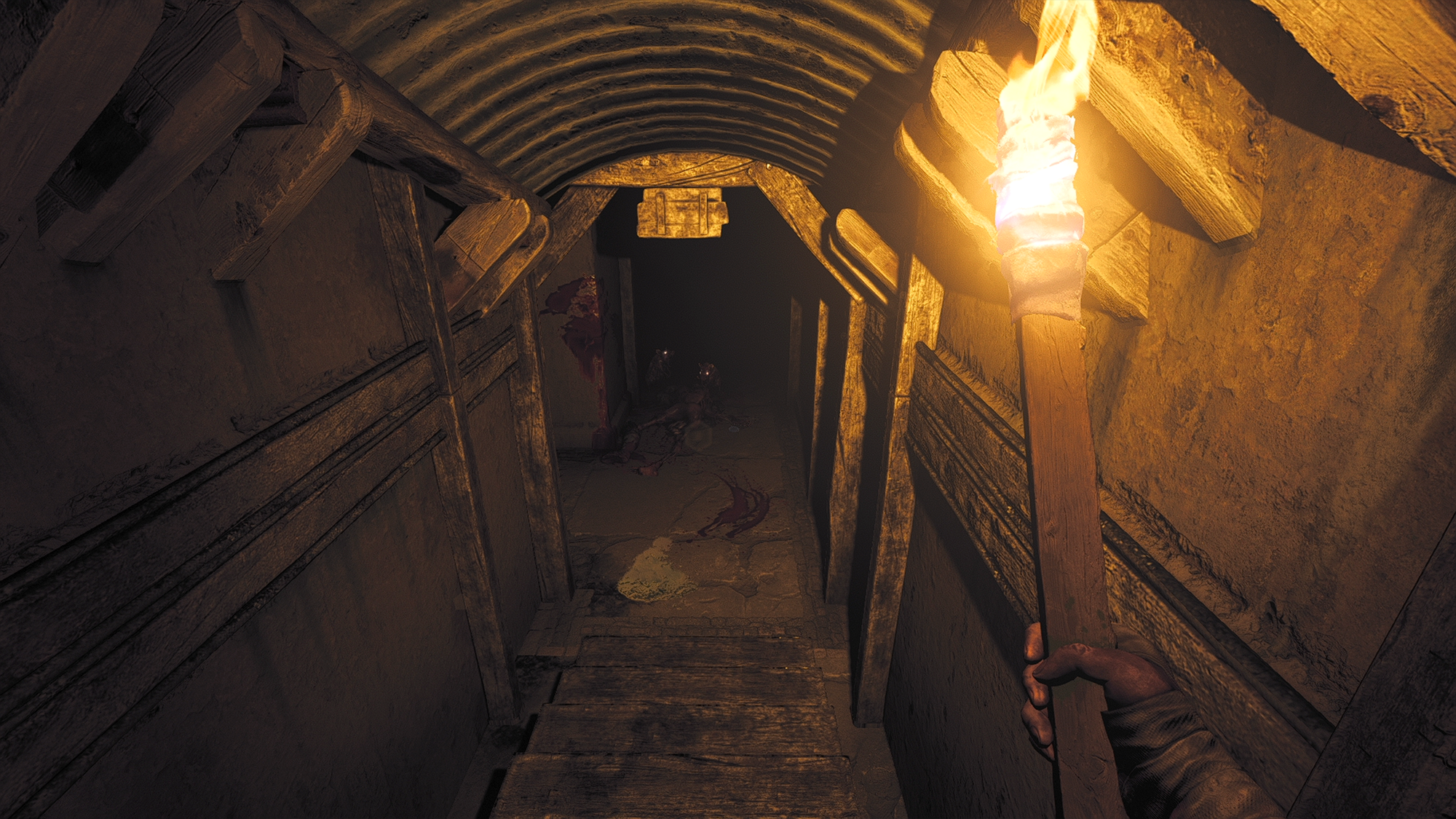
SUPERJUMP
You said that you didn't play horror games that much, nor did you watch a lot of horror films. Were there any other impactful horror experiences that you had like Stephen King or John Carpenter’s The Thing, then?
Fredrik Olsson
Yeah, I read a lot. I've read a lot over the past 10-15 years. I'm really bad at remembering names but there’s a lot of Stephen King books. I think one of the books that I really liked actually was "The Mist". I liked that a lot. It wasn't too long... When I started reading "It", it was such a long book that it kind of lost me halfway through. [laughs]
One of the books that really had an impact on me was "The Terror" [by Dan Simmons]. It's basically 1800s and [there's] a big ship that's supposed to try and get around the continent but then get stuck in the ice. There are tons of men on this boat and they start getting killed off by some kind of monster.
It had a bit of an impact on me because you never really see this monster. It’s more about the people living on this boat stuck in the most horrible situation. I like that type of horror where you have relationships but also have some kind of ominous being that always creates this kind of uncomfortable feeling throughout.
Actually, one of the recent movies with that guy from The Office - A Quiet Place – I really like that they based it around sound. There's one scene where they have zero audio which is very rare in movies...
It's kind of like the psychological aspect of what we did with The Bunker: when the generator is running, we have this kind of Shepard's tone that runs in the background. You can't really hear it, but if you listen knowing about it – you will hear it. It's an illusion basically of sound going downwards constantly. It creates this, 'Oh, the fuel is going out, the fuel is going out!' feeling. The second that the generator dies, the tone also disappears.
SUPERJUMP
So like some Christopher Nolan kind of mind-trickery?
Fredrik Olsson
Yes! And Christopher Nolan has that quite a lot in his movies. I think in Dunkirk there was a lot of focus on time. And so, that's where the idea came from.
SUPERJUMP
Is it true that The Bunker was supposed to be a DLC for Amnesia Rebirth? Also, how did you land on the idea to set it in a WWI setting?
Fredrik Olsson
Let's start with the second question. During the development of Rebirth, someone suggested it would be fun to have the WWI trenches. I think it might have been the writer on the previous game just mentioning [that] during a meeting. And we might have revisited it once or twice after that. The idea just stuck with us.
Then we came to a point where we came out from Amnesia Rebirth; I was supposed to start off the pre-production on a bigger project. But then I took over the creative lead role of Rebirth halfway through [the development], which meant that I came out of it having not been part of the initial design or story [development], feeling like I wasn't really done. I had more ideas. One thing I wanted to try was: 'Why don't we have a weapon?'
That kind of connected with the WWI setting, which was a setting that was not high-tech in any way. So I suggested that we make a DLC for Amnesia Rebirth. I pitched this idea because we had tried out stalking behaviour before; we tried it out on the ghouls in Rebirth, but it was such a linear story that stalking behaviour didn't make sense. (Actually, we had a version of this stalking behaviour where [ghouls] came out of holes. But we never used it in Rebirth.)
So that also tied into this idea of a bunker – now with a gun, one stalking enemy, and with WWI [setting], which was the previous idea. It all just came together that way. Everyone liked it, so we said, 'Let's try and do that!'
Very early we made a prototype and realized this is so different from Rebirth. Also, very fun. Honestly, not many weeks into the development of The Bunker as a DLC, we realized, 'No – this needs to be on its own thing.' Because we were having so much fun with it and seeing the potential, we kind of just allowed the scope to grow a bit.
SUPERJUMP
Should I ask about the gun(s) or about the randomization element first? Let's go with the randomization because that's a pretty unique feature that hasn’t been done in an Amnesia game before. Just to add, maybe you will agree, but Soma and previous Amnesia titles couldn't pull it off because they were more story-centric.
Fredrik Olsson
I think it's fair to say that if you replay Amnesia Rebirth or Soma, you replay it for the story. If you play The Bunker again – you play it for the challenge. That's why we have a Safe Mode for Soma. The narrative is that important.
So, yeah, randomization is there to make it more challenging. If you came in a second time and said, 'Okay, I need to get into that room because there’s a grenade in that drawer,' you wouldn't have to explore all of the environments anymore. Also, the codes are randomized [every time] – you can't look them up on internet and find out what's the code for that locker. You need to find a corpse with the right dog tag. Otherwise, you would have a very optimized path through the game and that would immediately kill replayability (for me, at least).
The core of The Bunker is to challenge the player. It's a fairly small environment, but we mix things up within that environment to make it fun. Especially with the dynamic monster as well. Which means that if the stalker had been scripted, that would also take away [from horror] because you’d know, 'Okay, when I step around this corner, he's gonna enter this room.' It's very rare that it pops up in the same place.
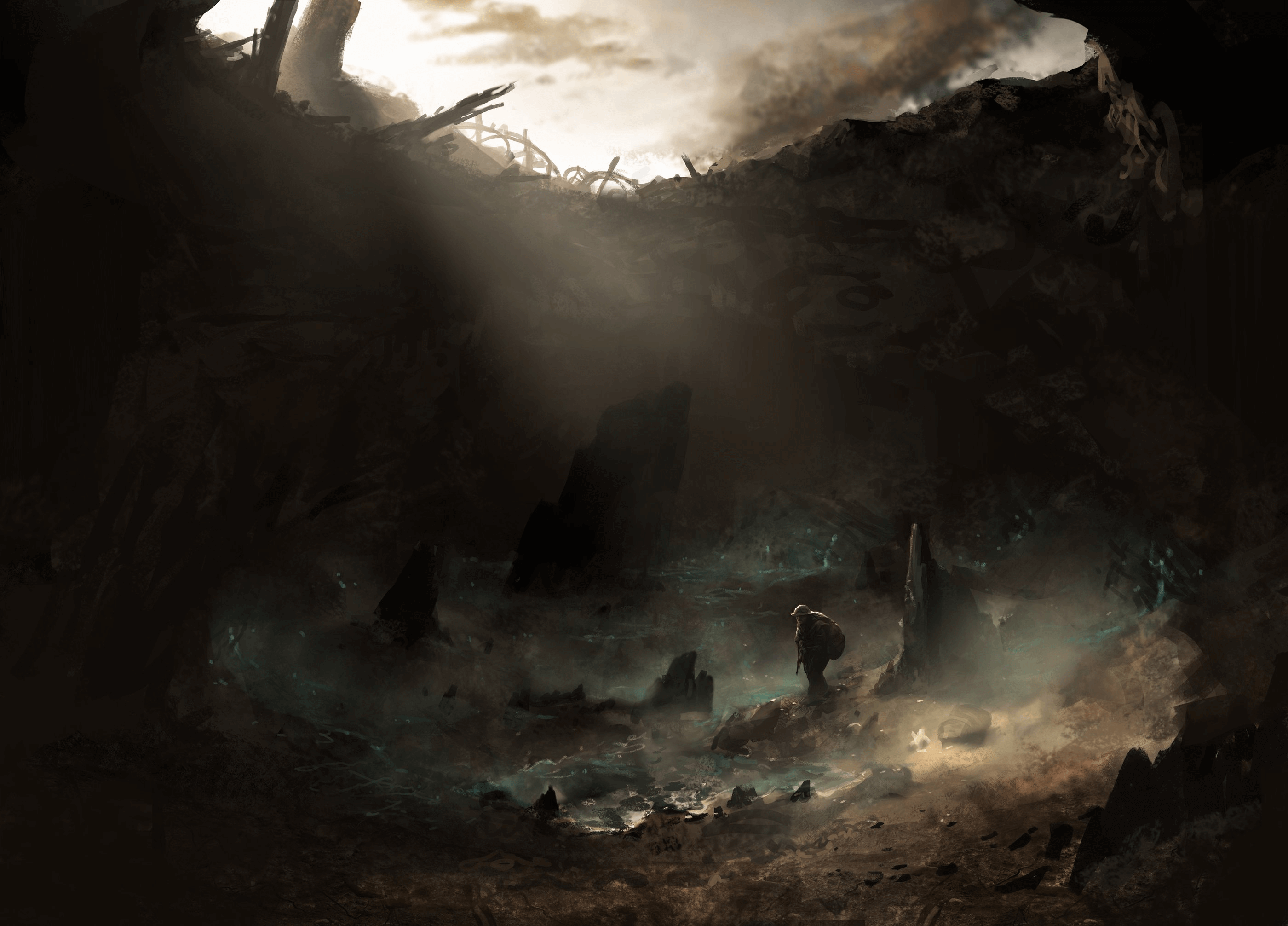
"Very early we made a prototype and realized this is so different from Rebirth. Also, very fun. Honestly, not many weeks into the development of The Bunker as a DLC, we realized, 'No – this needs to be on its own thing.' Because we were having so much fun with it and seeing the potential, we kind of just allowed the scope to grow a bit."
Fredrik Olsson
Executive Producer
SUPERJUMP
Now, I want to ask about the gun. In one of his early blogs, Thomas Grip, the creator of the Amnesia franchise, wrote that there’s a prototype version of Amnesia: The Dark Descent with guns, and apparently it was "too fun." Like it distracted the players from getting scared...Now you returned to this idea but managed to pull it off. Can you explain how you came up with this idea of 'It’s time to give players the gun again'?
Fredrik Olsson
I think the very first small prototype that we had, you were able to fire the gun at a padlock. It was very early that we said the bullets are not going to kill the monster – it's going to be a tool. Then, of course, it's going to be very few bullets, so they will be valuable. As soon as you put a value to that, you have a whole different scenario. Add that firing the gun at the Stalker once will [make him] come back and take two bullets next time... That's like you just sacrificed something just by firing the gun at him.
What it does is that it gives you a tool that is much more fun. I mean, it is fun to use the gun. But it's also very much anxiety-inducing. [laughs] There's one place in the maintenance, for example, where there's a hole in the back wall. You can shoot the padlock through it. '[But] should I use it here?’ Should I use this bullet here on this padlock??'
Look at horror movies: if you have few bullets left, it's not a fun situation. I'm kind of surprised it's not been used that way before, to be honest. This way, what we could do with the gun now is that it doesn't only become this game about hiding – especially with the generator, which is running on time.
I love the fact that during design, every single mechanic we came up with we started looking at the Stalker behaviour. 'Can you just hide under a table for a while? Is that still the solution?' No. Because when you sit there, you hear the Shephard tone running in the background and you go like, 'No, no, no, no! I can't sit there for too long. The monster is here walking around. Maybe I could just shoot him and run.' That gives you more opportunities, different ways to approach the problem.
I think early on it was like images in my head that became [the Central Bunker]. Some people were saying, 'The generator might become this kind of shore that you need to fill up over and over again.' And playing the first prototype, it was a very small environment. We couldn't backtrack. We couldn't be far away from the generator. But I had this moment in my head, like video playing in my head, of you walking there having done certain things, having this progress with the save room way back there. And [then] boom! It goes dark... You hear the monster coming out. And that moment was what we wanted to achieve.
There were multiple of those moments actually with how you can shoot it. For example, loading the gun: you're sitting behind the shelf, you hear the Stalker coming closer and you go, 'Did I load that bullet I found??' Then you have to take [the gun] out and check if you have a bullet in the gun, then back and then up. It creates these kinds of [moments] you've seen in horror movies. All of those moments, they are dynamic. They're created in that sense.
SUPERJUMP
Have you seen a movie called No Country for Old Men by any chance?
Fredrik Olsson
Yeah, I've seen it.
SUPERJUMP
Do you remember the scene where the guy's sitting on his hotel bed and he's slowly turning the light off and reloading his shotgun before the psycho guy comes to the door? He's doing it all silently. So this kind of brings to mind The Bunker because you are forced to take notice of how much sound the reloading [of your gun] does.
Fredrik Olsson
Yeah, that’s cool. But I don't remember that. I've actually thought I need to rewatch that movie because I don't remember too much about it... [laughs]
SUPERJUMP
Well, it's great! Great use of tension there. Anyway, you might have heard this critique that Amnesia: Rebirth feels more story-centric compared to The Bunker, which is more gameplay-oriented. How do you balance both of these qualities without losing the best aspects of one or another?
Fredrik Olsson
I think it's very difficult. To make a story like Soma, that’s very difficult to do with systems and mechanics – it has to come from one or the other as a core. Hopefully you can find ways where the narrative can blend in.
The Bunker is gameplay-centric – it comes from that seed. We've kind of added the narrative on top of that. The setting was already there to begin with and that helped the gameplay. The narrative – the friend, the Stalker, all those things – came afterward,. Whereas in Soma, the story came first.
And I agree with you. Unless you are super lucky that they just come together, I think it's super difficult to create something that has both. When you have gameplay that is an immersive sim, the player’s mindset is like, 'I need to save this resource for later. Maybe I need this to open a door later on.' If you want them to be concerned and think about a deeper theme, for example, a philosophical theme, like you do in Soma, then you don't want them to start thinking about, 'How can I use this grenade to blow up a door later on?' You want them to focus on the narrative.
I think it's super difficult to get that strong theme and an immersive approach to gameplay. I can't really see myself like even trying that out, to be honest... [laughs]
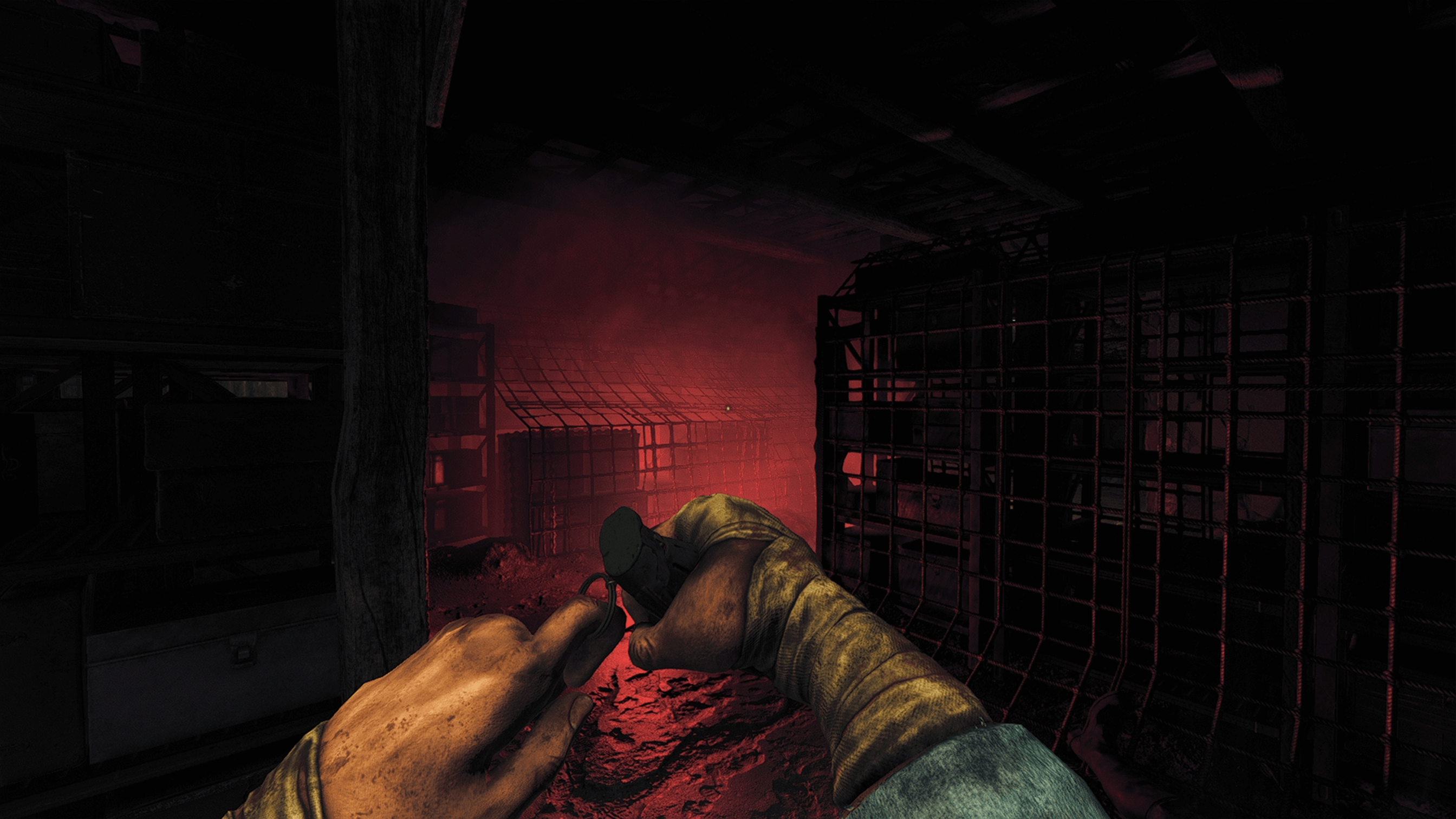
"I mean, it is fun to use the gun. But it's also very much anxiety-inducing. [laughs] There's one place in the maintenance, for example, where there's a hole in the back wall. You can shoot the padlock through it. '[But] should I use it here?’ Should I use this bullet here on this padlock??' "
Fredrik Olsson
Executive Producer
SUPERJUMP
In one recent interview, Thomas [Grip] said that for Frictional Games' next project, you are going to "cut back a bit" on horror games "in order to give greater focus on other emotional qualities." How do you personally feel about that? Aren't you afraid that you might alienate the player base that was so in love with The Bunker?
Fredrik Olsson
No. I mean, we have two projects in the pipeline. We always have that. The way we work as a studio is me and Thomas – we are co-owners. And also now we've become the creative leads on each project. So Thomas is working on his project now and that's going to be the next one that comes out.
We don't want to look at ourselves as genre-focused. I believe Thomas also mentioned in some [of his] blogs that there could have been fewer monster encounters in SOMA so that the narrative could've felt better. It would still be a horror game, of course, because of the setting and everything.
But for me, for the next project, I can't see going anywhere but more like The Bunker; More player freedom, player reward, and challenge. That's definitely what's going to happen. But that's further down the line. Even though it might not be a horror game, it's still going to have tension and all that.
SUPERJUMP
That's very interesting. And I do personally love SOMA. It’s one of those horror games that sticks with you.
Fredrik Olsson
And it's really popular, still! And it’s not an immersive sim – in fact, it's very far from that. So I guess you need to look at our games not as a studio releasing games, but as its own identity. Especially now that The Bunker took a step outside of what we regularly do.
You could have asked me the same question after Amnesia Rebirth and said, 'So are you making immersive sims now? How are people going to feel about that?' [laughs] We like to take things wherever we find the inspiration and where we want to do things because that's usually where the good stuff comes out.
SUPERJUMP
Can we talk about the blind shotgunner sequence? Because that's one of the more memorable sequences in the entire Amnesia franchise, at least for me. One aspect I really like about it – which was pointed out by the YouTuber called Purposeless Rabbitholes – is that if you put the gas mask on, you are going to have a completely different experience fighting the guy. Can you explain how you came up with that idea? Also, what inspired this sequence altogether?
Fredrik Olsson
We wanted to have something that did break up the gameplay with the Stalker, basically. Then we started thinking, 'Okay, if we can have a gunfight with a soldier, that would be absolutely fantastic. But we don't want to do it the regular way.'
That's where the narrative came in a way. By that point, we'd gone fairly far on in the narrative. We had written a lot of notes about people going crazy down there [in the Bunker]. So let's make a super crazy guy! I even suggested he cut out his eyes. I would say, 'We need more blood on the table. We need to see that he cut out his eyes.' So yeah, that created an interesting encounter with a blind enemy. Whereas the Stalker is not blind and can spot you.
Now, about the noise. If you go into that area, you can see there's tons of things you can throw. The idea of how that encounter could best be played is that you actually throw something at the other end of a room. He fires the gun, you see the flash and you know, 'Okay, that's the dude I need to take out.' But it became too easy...
We thought, 'We had already written about the fumes [in the Bunker]. We knew that the fumes were affecting the water that your friend drank and turned him into the Stalker. So let's do that type of gas.' We needed it seeping in through the walls to make it more interesting. It should affect the player as well. 'We can have silhouettes, too!' For easy purposes, I suggested that we add the Ghouls from Rebirth. And then we used just regular people as well. So you see those silhouettes because that makes it more difficult.
We took some creative freedom on the gas mask. In WWI, the gas mask wasn't actually covering the ears, but I said, 'We need to take that creative freedom because that changes the whole thing.' If you put that on, you get limited visibility and you get muffled hearing which made it more difficult to notice him. But you didn't see the silhouettes anymore. I mean, I don't think it ever starts as one finished idea. It's always a small idea that leads to something like this.
Also, one of the things I really wanted to do – since everything else is close combat – was an enemy that could actually fire at the distance. That also was an early part of the idea. That's where the soldier came in. Then we realized he should have a shotgun.
You can actually avoid him and not kill him. If you feel sorry for him and feel that he's better off just walking around, singing his song, or chanting his poem – then you can do that, too. But if you kill him, you get another tool. So yeah, everything fell into place nicely.
SUPERJUMP
Love that! How much research do you do before giving a green light to a setting for the game? Do you research a couple of different settings and see which one has more potential gameplay-wise?
Fredrik Olsson
I think for this one, no. We didn't do that with The Bunker because we kind of felt that it's going to be a smaller thing. As the scope grew, we already knew enough about the early-tech setting.
Then all of a sudden we realized that fuel could be poured on the floor. Someone on the team mentioned that if you can pour it [in the generator], you should be able to pour it on the floor. If you fire at the fuel puddle, it'll set the fire and if there’s an explosive barrel close by, it will turn into fire. So we worked within that framework. We just said World War I. It was very simple.
During the project, there were times when I thought going with early tech was both a blessing and a curse. It was difficult to find more gameplay mechanics. Fire, burning fuel, for example, opened up a whole new thing. At the same time, WWI was very refreshing because you didn't have to think about crazy ideas. It was very limited.
Early on we found this this idea for the flashlight. When we found out about the dynamo flashlight, we were like, 'That’s it! It’s World War I. We'll sort out the rest later.' [laughs] That was pretty much how it was. We fell in love with the idea and went with it.

SUPERJUMP
Will you continue on this path, taking an idea and going with it, then? Or you will research multiple possible settings for your next project?
Fredrik Olsson
It's probably the first [route]. Like, the idea is already set. I can't say much more. I hope it's going to be clear when you see it.
In a way, it's based on inspiration from literature and things like that. So you could say that there's been research done. But it's more like things that you picked up in your spare time – that becomes the research or the thing that indicates the kind of setting we will go for.
It's rather like, 'Oh, I like these types of aspects.' Then it starts to mould in your brain. You come to a conclusion where you can see the gameplay emerging and things like that.
SUPERJUMP
Do you think it's more difficult to scare players now than back in 2010 when the original Amnesia game came out?
Fredrik Olsson
This is going to be my very personal opinion, but I think it probably is. If you look back when games were newer, people didn't understand scripted events the same way. The fidelity is also higher, which means that if something looks off, it can ruin the experience.
With the Stalker, for example, very early on we came up with the idea to have the flickering light around him. First of all, that's a benefit for the player because if they have the generator on and running, it helps them to know that the Stalker is getting close – kind of like the scanner in Alien Isolation. The flickering light also disguises the Stalker. So you don't get a clear view [of him]. There's probably certain aspects of his animations that could make the Stalker look a bit silly. But you don't see those. It's also a camouflage to put him inside the holes. That was big and actually came about halfway through [development].
Previously we had the Stalker out in lit areas. Let's say you had the lamp turned on in the barracks, and while you were roaming around in the other barracks, you could hear the Stalker going around there. That just didn't work because players were saying, 'The generator's on [but] it doesn't have an effect on the Stalker.' They didn't know where he was [because] he was just contained in those dark areas. The moment we said, 'Let's try and put him in the holes more,' and not care so much about the lit areas – that just ramped up the horror.
I actually went to Thomas and said, 'Hey, I think we might have made this game too scary.' [laughs] And he was like, 'That’s good!' But I actually felt this might be too much for many players.
Now, if you really want to scare people – and I hope we managed to do that with The Bunker – then you need to tie it into the players' actions more instead of adding trigger points on the floor. For example, when you go there and something moves at the end of the corridor. Even moving a crate in the bunker could have a potentially disastrous effect on you. And that's playing with your head. I hope more games will do that instead of being almost like a movie.
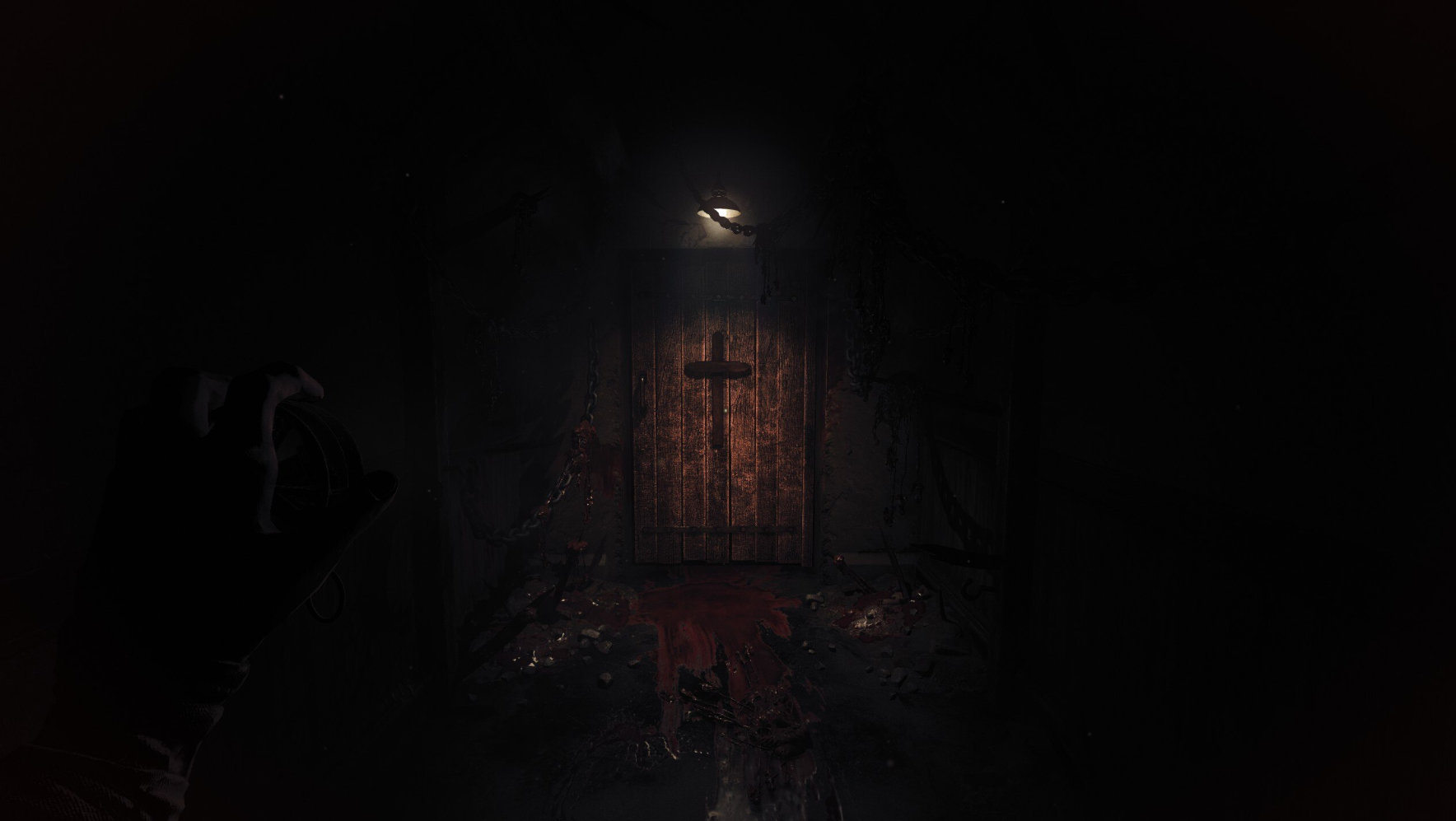
"We took some creative freedom on the gas mask. In WWI, the gas mask wasn't actually covering the ears, but I said, 'We need to take that creative freedom because that changes the whole thing.' If you put that on, you get limited visibility and you get muffled hearing which made it more difficult to notice him. But you didn't see the silhouettes anymore. I mean, I don't think it ever starts as one finished idea. It's always a small idea that leads to something like this."
Fredrik Olsson
Executive Producer
SUPERJUMP
To be honest, I haven't played such a scary game since the original Outlast... It’s so scary that I couldn't play it without my lights off. And that never happens!
Fredrik Olsson
That's nice. We like to scare people. [laughs] It's a strange line of work but someone has to do it.
SUPERJUMP
Okay, the final question: is there a feature/idea of yours you are most proud of?
Fredrik Olsson
The first thing I have to say is that every unique sequence that was created uniquely for the player – that's what I'm proud of the most. We managed to create a dynamic environment that creates war stories for the players. That was a big challenge for this project. I'm super happy with how it turned out.
If I had to pick a narrative point, I think it has to be the Pillbox. So many players go up there and say, 'Hey, I can climb out of this!' It's a very strong moment where people, looking down at the hole again, go, 'Oh, I need to get back there... This is not the way out. The sniper is ready to kill me.' It makes people think it's a safe area because the Stalker can't get there.
That shot is actually fun as well because the idea came from the audio guy who just put it in and said, 'I’d put an audio stinger here.' And everyone was like, 'Ooh, that's great!' Then we added on top [of it]: you can actually hold the helmet up, and if you do – it gets shot out of your hands. It's a very nice narrative moment where you get reminded of the setting.
I really like The Chapel in the maintenance area. I just love how people run back to the Safe Room, close the door, and then take a deep breath. You can hear it on so many playthroughs. [Laughs] That's the first time they take a breath.
We'd like to thank Fredrik for making time to sit down with us. If you'd like to read more in-depth developer interviews, check out our full interviews archive.
Resident Evil Village: Werewolves, Witches, and Winters’ Vengeance
Title: Resident Evil Village
Type of Game: Survival Horror, First-Person Shooter
Developer: Capcom
Publisher: Capcom
Released: May 7, 2021
Platforms Available: PC, PlayStation 4, PlayStation 5, Xbox One, Xbox Series X/S, Mac, iOS
Platform Reviewed: PlayStation 5
Maturity: Mature 17+
Reading Time: 13 minutes
A New Nightmare Unfolds
The latest Resident Evil 8 (from the main numbered series), subtitled Village, is pretty simple this time around. It’s a story-driven action-adventure that takes what worked best from its famous predecessors. Still, it simultaneously tries to wrap it all up with brand-new ideas that, at first glance, seem like they don’t really belong in the franchise at all. The Louisiana home of the Baker family from episode seven has been replaced by a half-empty village somewhere in Europe. In its immediate vicinity, you’ll also find the Dimitrescu family castle, which in more ways than one evokes, for example, the Spencer mansion from the first episode. However, there are also other places, including mines, a factory, or a small area with a water dam. It’s definitely a unique setting for the series, although its originality won’t wow you. Instead, what strikes you is the atmosphere that each location exudes and the overall high quality of the workmanship instead of originality.
The Haunting European Landscape
In the half-empty village, you are not chased by hordes of undead but by werewolves, witches, and other monsters. There are, at best, a few dozen of them, but moments of silence will occur frequently, and you will never know when the subsequent shootout and fight for life will begin. It makes you feel like you’re being watched the whole time, and you often feel the urge to look behind you. Add to that the fact that the main story revolves primarily around the protagonist’s family, so on paper, it’s something that previous installments never really tried to do, and you’re either in for a total bummer that will put off regular fans… Or something that will take Resident Evil as we know it one step further. The developers have taken an ambitious project on their shoulders that could be described as a considerable risk. But in this case, one thing is true – risk is profit.
Ethan’s Quest: More Than Just Family
I’ll mention at the outset that I won’t talk much about the story here. Not because it’s bad or not in the game, but on the contrary. There are a lot of cutscenes, as well as dialogue and story moments where you find out what’s going on, why the inhabitants are becoming werewolves, why your missing daughter is of such interest, and who Mother Miranda and her children are that the locals so blindly worship. But these are all things that are good to know as little about as possible. Likewise, the role played in the game by the fan-familiar Chris Redfield, one of the series’ consistently positive characters, is put in a villainous role from the start of the game. Or how the entire eighth installment actually fits into the more expansive Resident Evil universe. Because yes, it does fit, if only a little. Without proper context, there’s simply no point in explaining anything at all, so you’ll have to make do with the fact that the protagonist, Ethan Winters, is trying to find his daughter. It was the search for his daughter that I found the least interesting part of the story. While it was the main driver for Ethan, I was much more interested in figuring out what actually happened here, why everything is so disturbing, and why Chris Redfield went through yet another redesign.
One particular thing I’ll dwell on, though, is the aforementioned Ethan Winters. Personally, I found him to be a really uninteresting protagonist in the previous episode. Although he mostly appears to have some emotion in the case of the Village, it’s still a relatively weak aspect of the story, unfortunately. It often felt like the developers just didn’t know whether to make him a fully-fledged character or leave him empty enough for anyone to take to. At times, he simply baffles you with his planked reactions, while at other times, you feel that if the writers had gone a little further, he could have been a really interesting character. This way, though, you mostly hear an emotional monologue about his daughter, which is soon replaced with a bad and indifferently delivered line after some major personal injury.
Blending the Best of Resident Evil
What I can easily and mostly positively talk about, however, is the gameplay itself. After a couple of hours, it left me with one main thought, which I kept repeating to myself while playing… It’s as if the developers found the perfect way to combine the first episode and blend the fourth and fifth with the seventh. What does that mean in practice? You’ll spend one part of it in Dimitrescu Castle, which, as mentioned, is reminiscent of Spencer’s mansion from the first episode. From the fourth installment, the game again takes relatively fast-paced locations linked together by some uniform characteristics, with a greater emphasis on just the occult and unknown mutations. From the seventh volume, you will, of course, find the first-person view and somewhat of a story-telling style, while it is from the fifth volume that the overall pace and momentum is most apparent, where you often don’t feel like you can or rather want to, stop. The pacing, in particular, is really well done. You won’t spend so much time in the slower parts that you get bored, and at the same time, the action passages never suck all the energy out of you once you start to feel like one option or another is taking too long, the game comes back with something completely new.
This, including combining elements from the older installments, is something Capcom has managed to balance really well, and I think all fans of the series, no matter what their favorite installment, will be happy, just as I’m sure complete newcomers will be delighted.
Action-Packed Survival Horror
In any case, if we focus purely on the differences between this and the seventh episode, as they are directly related, there are several. Especially the fact that the eighth episode is much more action-packed. Rather than a survival game where you have to choose well when to attack and when not to, there are directly designed action sections where a pack of enemies or a stronger opponent can charge at you. Often, you’ll have the choice to simply run on through or fight them.
Given that you’ll have a slightly more expanded arsenal of weapons on hand than in the last installment and just enough ammo, you’ll feel like the choice to deal with each opponent isn’t a bad one either. Ammo-making materials are mostly plentiful but not overly so, and if you happen to “manage” to be out of ammo, there are other options. For example, Duke the Merchant will gladly sell you some ammo for some cash. You can also find first aid kits, manufacturing recipes, weapon accessories, or the possibility to directly upgrade a weapon for more power, faster shooting, or magazine capacity. You can also sell him a number of rare items that can be found hidden in the world, be it gems or special skulls, as well as cook a meal with him later in the game using specific ingredients to permanently upgrade some of your character’s stats. Yes, there’s even some form of animal hunting. So it’s worth exploring the various locations you get to thoroughly. But if you don’t want to, you don’t really have to. The most important treasures, such as new weapons or costly rare items, are marked on the map after a while, and even then, you don’t have to take them into account to finish the game.
Resident Evil Village really tries hard to make sure that just about any gameplay style you choose is a good one. You can use brute force, aim for the enemy’s head with your skills, or try to think a bit. Maybe you can use a good shot to expose a weak spot or shoot the enemy’s weapon out of their hand. You can try to cleverly herd them into one place and throw a grenade at them, shoot them down from a distance, or guide them to where you’ve laid a landmine. All of these options are at your fingertips, and it’s really up to you what you reach for at any given moment.
The Art of Exploration and Puzzles
But, of course, this game isn’t just about shooting. The exploration of the environment that I mentioned and also the puzzles are another vital part. In the case of exploration, there are very few things to complain about. The whole map will surprise you with its size and openness, and you’ll often find yourself returning to places you’ve visited as you unlock another path or search for another abandoned house. Sometimes, you may find a completely off-the-beaten-track area that may hold some interesting treasure, but it may be just as dangerous that you may prefer to walk away from again. And sometimes, as you progress through the main story and explore the site content, you’ll encounter just the puzzles. Like the rest of the game, I’d describe these as a bit of a mix of the previous few episodes. Sure, they’re there, varied, unique, and often so utterly nonsensical that you wonder why someone thought up and built it in the first place, but at the same time, they’re not difficult or significantly profound. In other words, you’re unlikely to get stuck on any of them. Still, I appreciate their variety. There are even some environmental ones.
Audiovisual Mastery in Terror
So Resident Evil Village does a lot very well, and I believe veterans of the series will recognize most of these elements very well. However, the audiovisual design also plays a big part in their enjoyment. The sounds, in particular, are something I’d like to single out. I’m not entirely sure if it’s just me. Still, throughout the entire playthrough, I felt like the developers weren’t at all afraid to “attack” us with deafening sounds out of nowhere. Which only added to the atmosphere and instant adrenaline rush. Still, there were several moments when just dull background noises, some screeching behind you, or a noise in the distance were enough to draw you into the game nonstop. It’s hard to describe, but the fact that I was able to perceive and enjoy the sounds like that is quite a feat.
Graphically, the game has nothing to be ashamed of. Yes, there are some things that bring it down a bit. The occasional places where you’ll run into edges a lot, the occasional worse textures, or the odd vegetation here and there are probably the most obvious, but it’s still hard not to enjoy watching this title. The lightwork is excellent, and the color palette is pretty much perfect. More than once, I was downright amazed by the sight of new environments.
Balancing Nostalgia and Innovation
It’s tough to find fault with Resident Evil Village. It’s a sequel that has combined the best of the previous installments with new ideas that simply work. Some may be bothered by the fact that the game isn’t all that scary or horror-y in the finale, primarily relying on the adrenaline sections, the parts where you don’t know what to expect, and the visuals rather than how well you can navigate the space and manage your inventory. But you’ll often be on your guard anyway. I personally didn’t mind this at all, though, and happily played through the average eight-hour campaign in one go.
Beyond the Campaign: Mercenaries Mode
And if eight hours doesn’t seem like enough, you can certainly take advantage of unlocking the harder difficulty, the special arcade mode Mercenaries, after you’ve finished the game, in which you try to shoot waves of enemies or complete a series of challenging trophies. Can you finish the game in under three hours or using just four or fewer healing items? You can find out for yourself…
Leaving Excellent RE Village
For the verdict, it’s enough to say that this one was really good. The game earns a high rating and recommendation thanks to a lot of good decisions, even for players who have no experience with the series. They may miss some of the smaller connections, but otherwise, this is a title that can easily be enjoyed on its own. And you don’t have to worry about this volume straying too far from the series’ themes as a whole. There’s more to the werewolves and witches than meets the eye.
Where to Buy Resident Evil Village
Steam (PC): Available for $59.99. You can purchase it directly from Steam.
Xbox Store (Xbox One, Xbox Series X/S): Available for $59.99. Check it out on the Xbox Store.
PlayStation Store (PS4, PS5): Available for $39.99 (currently on discount for $15.99). You can find it on the PlayStation Store.
Nintendo Shop (Cloud Version): Available for $39.99. Purchase it from the Nintendo Shop.
App Store (iOS): Available for free with in-app purchases. Download it from the App Store.
Official Page: Visit the official Resident Evil Village page for more information.
Subreddit: Join the discussion on the Resident Evil Subreddit.
The post Resident Evil Village: Werewolves, Witches, and Winters’ Vengeance appeared first on WePlayGames.net: Home for Top Gamers.
Resident Evil 7: Biohazard – A Terrifying Return to Survival Horror Roots
Title: Resident Evil 7: Biohazard
Type of Game: Survival Horror, First-Person Shooter
Developer: Capcom
Publisher: Capcom
Released: January 24, 2017
Platforms Available: PC, PlayStation 4, Xbox One, Nintendo Switch (Cloud Version), PlayStation 5, Xbox Series X/S, iOS
Platform Reviewed: PlayStation 4
Maturity: Mature 17+
Reading Time: 11 minutes
The Rebirth of Fear
All gamers are very familiar with Resident Evil, so there’s no need to bring up the fact that the seventh installment is the first in the main series to use a first-person camera view. Some fans may not buy it, but I think most will come to their senses once they get a taste of the game. We’ve complained for years that Resident Evil 5 and 6, as well as both installments of Revelations, are no horror. Now we have one right out of the textbook
Despite the change in perspective, Resident Evil 7: Biohazard is a true return to the series’ roots. Rotten roots that have been hit by an infection in the ground and turned into something terrifying.
The name of the game was not chosen by accident. Resident Evil refers to evil taking up residence in a remote mansion, as it did in the first installment. Biohazard, as the series is called in Japan, refers to mutations linked to the leakage of a dangerous substance. Both of these are encountered in abundance in the seventh installment.
Welcome to the Baker Family
The story is set in the American South in Louisiana. The protagonist, Ethan Winters, arrives in the fictional town of Dulvey, where he hopes to find his wife, Mia. She disappeared three years ago and has been declared dead. But now Ethan has heard from her. So the desperate husband sets out on a journey to find answers about what happened to his wife and whether she is really still alive.
In the opening scene, the player finds themselves on their way to a remote mansion that, while it doesn’t look or feel like the one from the first Resident Evil, houses the same level of fear. Except that the dilapidated house, from whose surroundings strange disappearances have been reported, is not uninhabited. It’s inhabited by the oddball Baker family, who are no match for the cannibalistic Sawyer family from the Texas Chainsaw Massacre film series. The game clearly takes inspiration from the latter. Know that the Bakers are true perverts who will give you the creeps. Jack is the head of the family, in charge of everything. He doesn’t like it when someone makes a circus out of his home, and he can take care of the order in his house. He’s not worried about losing his head. His wife Marguerite doesn’t have all five together either. Plus, she’s been infected with insects, so she harbors a nest full of annoying little friends. Their son Lucas is the family’s black sheep, which is saying something by her standards. He uses his wits to kill. He likes to play, so he sets his victims up with traps, pitfalls and puzzles that, if solved incorrectly, can end in death.
Monsters and Mayhem
As enemies go, the Bakers are great. Plus, they’re shrouded in mystery. It’s clear they’ve been infected with a virus, but why and how, you don’t know. And you want to find out at any cost. Know that you’ll have a lot of fun with the Bakers, who, for reasons as yet unknown, care so much about strong family values. I mean, horror… But it wouldn’t be Resident Evil if it didn’t have rank monsters grinding their teeth, claws or tentacles at you. Here, the Bakers act as adversaries that you must first avoid in sneaky passages before confronting them as bosses. Dale’s monsters, which will charge at you for execution, are called Molded here. In the Resident Evil series, we first had zombies, then ungodly creatures called Ganado controlled by Plague parasites, and other variations on bio-threats. Now we’ve got an infected family of madmen that aren’t so much to be scared of, but you’ll definitely still have your fun with them. You’ll face a basic version that will want to tear you apart and eat you at the same time. You’ll also have Molded at your throat with a giant spike on his hand, kind of like a baby Tyrant.
The slimy monsters moving on all fours are nimble, fast, dangerous, but they’ll quickly go back to hell after two bullets to the head. The heaviest of the heavies are the fatties, who are very slow, but again, damn tough and attack by vomiting. Not to mention the basement, where such atrocities will be lurking around every corner…
Survival Horror Reborn
The main character doesn’t have much room to express himself compared to the other characters. But he’s a civilian like everyone else. He is not a member of a special combat team or a police officer, as in the earlier episodes. He’s a scared guy in the middle of a nightmare. But he’s not defenseless.
He’s given an axe, a chainsaw, a pistol, a shotgun, a machine gun and a homemade flamethrower. But this is not doom. The Seventh Resident seriously returns to horror, and while it offers combat, the battles play more of a secondary role. The game is survival-based, a true survival horror with all the trimmings. You’ll collect old familiar green herbs and mix them with chemicals to get the cures. You’ll take pills that will grant you enhanced vision, allowing you to see hidden objects for a limited amount of time. There are traditional crates where you store unneeded items, only to find that you just need them and have to return. Storage is also stylish. Now you don’t need a typewriter, now you just need an old MC player. Resident Evil 7: Biohazard does an excellent job of showing off what we know from the earliest installments.
A New Perspective on Terror
This year, by the way, it’s slowly but surely 30 years since the first installment of the Resident Evil horror saga came out on PlayStation. The world of video games has changed because of it, and the franchise itself has changed over the years. The most obvious change with this installment is, as previously mentioned, the first-person camera view, which has undoubtedly had its consequences. The game is even more terrifying from the point of view of your own eyes. One looks around and waits for something to jump out at them again. And when you least expect it, it happens, and that’s when the shocks happen. The game is incredibly scary in its own right. It has an atmosphere thicker than the smog over Asian cities, and the jumpscares are absolutely heart-pounding. Playing the game at night is about health. Unfortunately for you, the atmosphere will get even thicker as you progress through the game, the tension and fear will take on extra dimensions by the end of the game. That’s where the seventh Resident Evil is going a little overboard. While the action in the mansion and adjacent houses is terrifying, once the game moves to the wrecked ship the game turns into your living nightmare, but I won’t reveal more.
Puzzles and VHS Tapes
The game takes a lot from the original episodes, thankfully it’s also about puzzles. You’ll actually be puzzling over those the entire time you’re playing. They are absolutely typical of the series. You’ll be piecing together relics, collecting keys, looking at them from all sides. Puzzles are an integral part of the entire game and you’ll come across them at every turn. And while they’re not too challenging and we didn’t encounter any hitches, they’ll still give you a hard time. That’s something everyone should appreciate. The change of perspective is not the only new gameplay element, by the way. The seventh Resident Evil brings a very original element in the form of videotapes. You can play the found VHS in any cassette player to unravel the mystery of the past. In an instant, you’ll find yourself in the shoes of another character who has encountered the Bakers or another horror. You’ll discover how to solve puzzles. In fact, you will eventually be confronted with the pitfalls of other undead yourself. So you’ll know how to deal with them. At the same time, you will witness what triggers which mechanism, so you can avoid traps or outright death. The VHS playback is a very original and imaginative element that draws you into the plot. Resident Evil 7: Biohazard, by the way, stays caught up in terms of storytelling, revealing everything gradually until the very end and the big surprise. The game’s lifespan is not very long, but at the same time it doesn’t offend. I finished it in 8 to 9 hours on my first attempt, which is a decent time for the series.
Visual and Audio Experience
Now a little bit shorter on the visuals of the game, which in my opinion are a bit contradictory. The fact that the game looks relatively bad on PS VR which the game also came out on I understand. But why the textures are exaggerated and many objects are extremely jagged when played on a classic TV in a dark environment, I really don’t understand. The character models are good, but the environments don’t have much going for them. The graphics don’t offend, but they’re not very good either. We have to admit that, although I really like Resident Evil 7: Biohazard as a game.
The sounds, on the other hand, are properly dark and immersive. It’s a real return to the horror and the roots of the saga. I really appreciate Capcom for not standing still within the main series and bringing new and fresh ideas. At the same time, they’re not afraid to take risks, even though they know that a lot of fans will complain about the change in gameplay style. 7 years ago, he succeeded again. Resident Evil changed its face again and is as scary as it has been in a long time for the franchise which later took Resident Evil one step further: Village which you can also look forward to a review from us soon.
The Mobile Gaming Dilemma
Regarding the mobile gaming landscape, Resident Evil 7 presents an interesting case. While the franchise has had success with mobile ports and spin-offs in the past, bringing a full-fledged mainline entry to smartphones is a challenging endeavor. The game’s intense graphics, immersive atmosphere, and complex controls don’t naturally lend themselves to mobile play. Despite this, Capcom attempted to bring Resident Evil 7 to iOS devices. However, recent reports on RE7 suggest that this venture has not been successful, with sales figures reportedly falling well below expectations – fewer than 2,000 units sold. This underwhelming performance raises questions about the viability of porting such graphically intensive and mechanically complex games to mobile platforms, even for established franchises like Resident Evil. While mobile gaming continues to grow, it seems that some experiences are still best suited for consoles and PCs, where they can be enjoyed as originally intended.
Last Words on RE7
Resident Evil 7: Biohazard may seem at first glance to have little in common with the original installments, but the opposite is true. It’s all about the conceptual approach to horror and gameplay in general. However, you’ll also come across moments created specifically for fans. For example, you’ll discover an image referencing a well-known location, nostalgic sounds will be heard when entering the code to a door, and you’ll even be faced with an identical puzzle to the one you solved in the first Resident Evil. And maybe even a familiar character will appear. This is, in short, a game for fans of the franchise as it should be, though not for all of them. After the sixth installment of the main series and a pair of games with the subtitle Revelations, the seventh installment is a clear shot in the dark.
Where to Buy Resident Evil 7: Biohazard
Steam (PC): Available for $19.99. You can purchase it directly from Steam.
Xbox Store (Xbox One, Xbox Series X/S): Available for $19.99 (now on discount for $7.99). Check it out on the Xbox Store.
PlayStation Store (PS4, PS5): Available for $19.99(now on discount for $7.99). You can find it on the PlayStation Store.
Nintendo Shop (Switch Cloud Version): Available for $39.99.purchase it from the Nintendo Shop.
App Store (iOS, Mac): Available for free with in-app purchases. Download it from the App Store.
Subreddit: Join the discussion on the Resident Evil Subreddit.
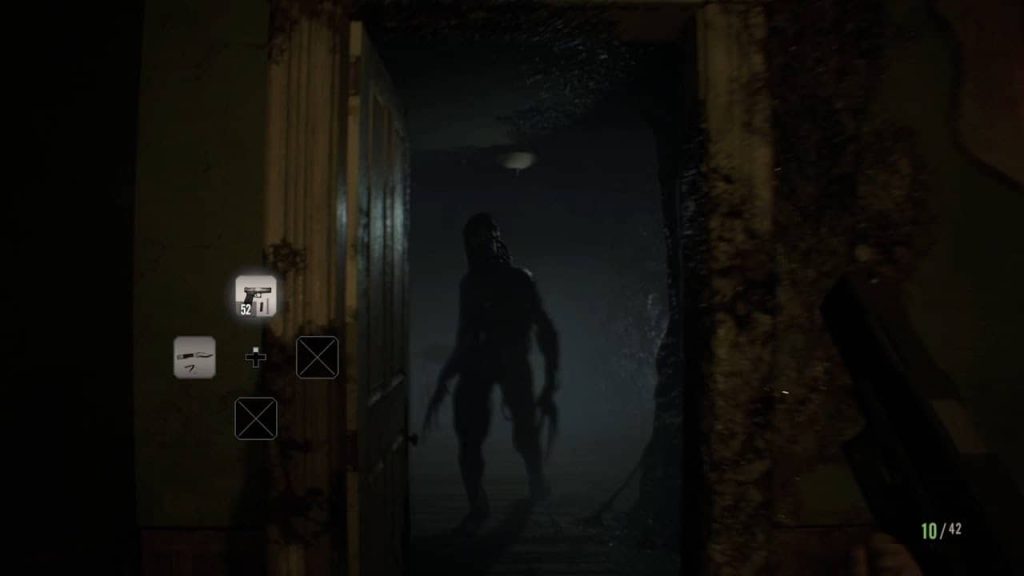
The post Resident Evil 7: Biohazard – A Terrifying Return to Survival Horror Roots appeared first on WePlayGames.net: Home for Top Gamers.
Martha is Dead: A Haunting Tale of Loss and Mystery Amid War
Title: Martha Is Dead
Developer: LKA
Publisher: Wired Productions
Released: February 24, 2022
Platforms Available: PlayStation 4, PlayStation 5, Xbox One, Xbox Series X/S, PC, Nintendo Switch
Platform Reviewed: PlayStation 5
Article Reading Time: 9 minutes
Fog Over Tuscany: A Quiet Life Amid War and Tragic Discovery at Dawn
The year is 1944. In addition to the threats of the Second World War, a thick morning fog falls on an otherwise sunny fictional Tuscan town. Apart from the occasional shell explosions heard from afar, the family of army general Erich lives a relatively quiet life in this locality. His wife Irene is a local seamstress, and his daughters – identical twins Giulia and Martha – have everything they can think of. The first mentioned (Giulia, whom you play as) is a keen photographer. So early in the morning, she rounds the photo traps at the nearby pond, hoping to take pictures of the animals that come to the pond to drink overnight. But what she discovers changes everything. The body of her sister Martha floats on the surface, which means only one thing. Martha is dead. Or is she?
A Different Breed of Horror
Although the game belongs to the genre of first-person survival horror, don’t expect bloody carnage like in Resident Evil or the kind of scares of which Outlast is the imaginary king of recent years. Italian studio LKA tries to go about it a little differently. This is seen in their first game 2016, The Town Of Light. In Martha, most of the story is presented as text. Your approximately six-hour gameplay experience will thus be mostly about constantly going somewhere and explaining specific events. Sometimes, you will have to call a funeral home, sometimes, you will have to bring flowers to your mother, and sometimes, you will have to find the grave of an unknown man in a rather large plot of land.
None of this is difficult. The task’s location on the map is always shown with a red cross. What is worse, however, is the path to the task. I want to keep the story private because that’s what I enjoyed most about the game. As an example, though, I cite the path to the lake, which you go to several times during the game. In daylight, the journey is incredibly tedious; mostly, nothing happens, so you just keep going and going as the birds sing. However, it gets pretty intense if you have to visit the lake at night. Of course, the journey is no shorter, and I have already mentioned that nothing scares you in the game. However, the atmosphere was really dark, and I felt like I was constantly being watched. There were several paths to choose from, and even though your direction doesn’t change the plot, you suddenly start wondering whether it would be better to take the shorter path to the left, past the strange cabin, or the longer but illuminated path to the right. So, the author’s efforts to make us feel really uncomfortable in the game were excellent, and I empathized with Giulia’s feelings. Or was it Martha?
The Lens of the Past: Photography as Storytelling
But it’s more than a tiresome journey from point A to point B. The main element of the whole game here is the period camera. Taking pictures of objects moves the story along, and the authors have done quite well with this mechanic. Accessories such as a tripod, flash, and notable films for taking pictures in the rain and dark are available.
And, of course, since there were no digital cameras during World War II like there are today, you have to develop your images in a dark room. The name “dark” doesn’t just mean it’s dark. In fact, you won’t feel very comfortable in the basement of the house where it’s located. But back to developing the photos themselves. It works here on the principle of a mini-game. You need to set everything up correctly and wait a certain amount of time for the process to be completed. However, the whole thing only takes a few seconds, so don’t worry about being stuck in the basement for tens of minutes. You can also liven up your passage through the game by wandering around and taking pictures of anything that comes to mind. Like a dead Martha. But is it Martha?
Aside from the shooting above and developing, the game offers plenty of little mechanics to liven it up. You’ll be divining from tarot cards, which, while an essential part of the story, don’t change the order in which you draw them. And in one of the side quests, for example, you help the guerrillas. You communicate with them via telegram using Morse code, and for someone who didn’t go to the camps, like me, that was the scariest thing about the whole game. The more remote locations of the plot can then be visited by bike. I strongly advise against this, though. I never thought I’d review a riding model in a horror game, but I just can’t do it here. I could get going, but the problem came with the first turn. Every attempt to turn was accompanied by camera jerks, and the driving itself was reminiscent of going downstairs. Moreover, the bike can only be used around the house and to visit the cemetery, about a minute’s walk away. However, remember me during your first tantrum if you decide to use the bike.
There are several side quests in Martha is Dead (such as the communication above with the partisans). Their fulfillment or non-fulfillment, however, does not change the plot. You’ll lose a few dozen minutes of gameplay and get different answers in conversations.
Technical Difficulties and Triumphs
Although I enjoyed the story, the technical state brings the whole game to its knees. Because this is an indie game that ten people worked on, the occasional sound dropping out or getting stuck on an obstacle could be forgiven. However, the developers have promised to make the game for the new generation of consoles, compared to the PC version, which some players needed more time to finish due to poor technical conditions, except not at all. Several times, I got stuck in a location where I had completed all the required tasks and couldn’t get any further. Sometimes, I got stuck in a texture that I fell through. Sometimes, the game froze, and only restarting from the last saved position helped. The crown of it all was the beginning of the game, which I had to repeat four times. After a few minutes, an error popped up, and I couldn’t continue. At first, I blamed it on my PlayStation, but nowadays, you can find hundreds of comments on the internet from players with similar problems. That applies to both new and old-generation consoles.
DualSense Delight and Visual Finesse
But not to just blame the developers. They’ve done an excellent job of using the DualSense controller. Adaptive triggers are now commonplace for most PS5 games. They add a great vibe to the gloomy atmosphere and gaming experience. The controller constantly alternates the vibration of its left and right sides, which is meant to simulate footsteps. It’s a little thing, but a nice touch. The graphics of the game, however, are good. Unreal Engine 4 adds to the so-called realism of the game. The shadows, the sunlight shining through the treetops, and the animation are all perfect for an indie game. The period music playing from the radio and the effects will sometimes give you goosebumps. Plus, if you choose the dubbing in the original Italian, you’ll immediately want to go to an Italian vineyard.
The Ethical Dilemma of Censorship
Although there were rumors the day before release that Martha would be censored for PlayStation consoles, there is an option to set up an uncensored version at the start of the game. If that doesn’t make you sick at the sight of skinning, flesh-eating worms, or partial nudity, I recommend turning this mode on.
Final word on Dead Martha
I’ll admit that Martha is Dead is pretty hard for me to rate. On the one hand, we have a roughly six-hour story full of madness, fear, and uncertainty. It’s a story that will leave you reeling from start to finish. On the other hand, we have a game that – while not explicitly broken – is riddled with technical issues that ultimately sink the overall experience. So, for us at Weplaygames, the dark atmosphere of an Italian village during the Second World War, backed by great audio, will not let you tear yourself away from the screen. But the great story is literally killed by the technical state of the game. Freezing, crashing, and many other problems will frustrate your gaming experience. That’s why the final verdict of this minor game is rather average.
Where to Buy Martha Is Dead
- Steam (PC): Available for $29.99. You can purchase the game directly from Martha Is Dead on Steam.
- GOG (PC): The game is also available for $29.99 and is DRM-free. Purchase it from Martha Is Dead on GOG.com .
- Epic Games Store (PC): Priced at $29.99. Find more details and purchase the game here on Epic Games Store.
- PlayStation Store (PS4/PS5): The game is available for $29.99, with discounts often available. You can buy it from the PlayStation Store , Martha Is Dead PS4
 & PS5
& PS5 .
. - Xbox Store: Martha Is Dead is available for $29.99 on the Xbox platform. Check it out on the Buy Martha Is Dead | Xbox.
The post Martha is Dead: A Haunting Tale of Loss and Mystery Amid War appeared first on WePlayGames.net: Home for Top Gamers.
Here’s Your First Look At Return To Silent Hill’s Iconic Monster
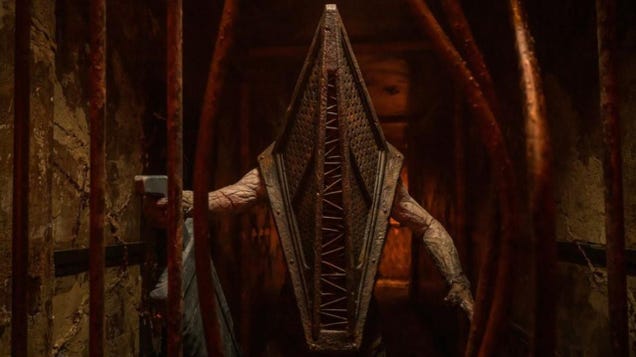
On top of a slew of new Silent Hill games in the works, the franchise is also looking to make a comeback on the big screen. Return to Silent Hill, ( the first movie in the series since 2012’s Silent Hill: Revelation), is currently in the works and looking to debut during this year’s Cannes Film Festival. To give fans…
9 Demos You Need To Play During Steam’s LudoNarraCon 2024
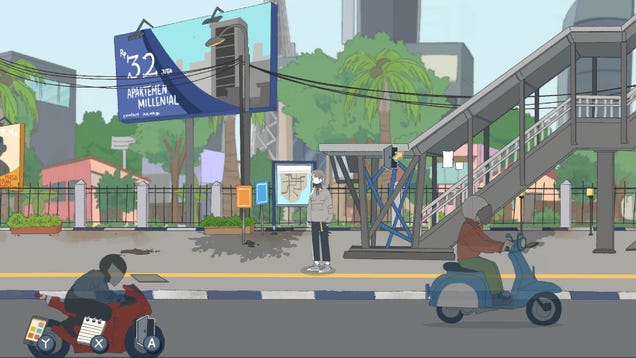
It’s that time of year again, LudoNarraCon! The annual Steam festival organized by indie publisher Fellow Traveller (known for games like Citizen Sleeper) is back as of May 9 and will run until May 13. Like previous years, the festival brings with it sales, panels with interesting developers, and exciting demos for…
Resident Evil 4 Remake: Another Great Revival of a Horror Icon
Title: Resident Evil 4 Remake
Developer: Capcom
Publisher: Capcom
Released: March 24, 2023 on PlayStation 5, PlayStation 4, Xbox Series X/S, and PC
Platform Reviewed: PlayStation 5
Article Reading Time: 10 minutes
Introduction: The Legacy of Resident Evil 4
Resident Evil 4 has long been one of the most popular installments in the franchise, alongside the second game. When the original game came out in 2005, there was a lot to praise. This action-horror adventure impressed with its approach to storytelling, revolutionary third-person view with over-the-shoulder aiming, the evolution of the game’s universe with a significant change of setting, boss fights, and overall styling and atmosphere.
But what was once revolutionary is now, at best, a complete staple or, at worst, an outdated element. This was a hugely important and, more importantly, ambitious project for the developers at Capcom. With something so beloved, all it takes is one misstep, and it can all come crashing down like a house of cards. Most importantly, though, that script version only happens here.
Reimagining a Classic: Balancing Old and New
Now that I’ve said the word script, it’s appropriate to start with it because you can already see the direction the remake takes. As we may have become accustomed to from the remakes of the second and third installments, Capcom doesn’t try to copy every event or dialogue. And the same is true this time around. Half and half. The central story points, with some exceptions, happen in the same order; you’ll be walking around the same, albeit often modified, locations and fighting the same enemies. Therefore, the original game’s core has been retained in this respect. However, it has also been improved, even expanded in some cases, or the order of events has been changed. But the core remains the same – you and Leon are sent to find the president’s missing daughter, Ashley, somewhere in a Spanish village. Of course, it will take a lot of work… But I don’t need to say more. The new player will see for himself.
A More Serious Tone: Enhancing Character Depth and Relationships
The original’s unique yet slightly far-fetched style is now more in the background and has been replaced by a more severe presentation. On the one hand, this may be a mistake for some, but the reality is that this is something established and, more importantly, consistent with the previous remakes and new installments. And something that fits the modern form of the franchise perfectly. Leon jokes a little less, performs fewer athletic feats, and takes everything more seriously. At the same time, Ashley finally comes across as at least somewhat of an intelligent person and not a hell-raiser like in the original…
Most importantly, a lot of moments are set in more believable situations. You can see that beautifully in chapter eight, for example. The reason Leon and Ashley are separated this time is not because she suddenly runs away from him in a panic attack and, like a complete fool, walks into an obvious trap that, moreover, seems random and somewhat artificial. The reason for the split now has a lot more depth, which results in the expansion of both Ashley and Leon’s characters and their relationship for the rest of the play. And it doesn’t just apply to them. Even though some cutscenes have been shortened, all of the characters are given more space, depth, and meaning. Story-wise, the remake of Resident Evil 4 is thus a surprising experience, which has matured much more in relation to the original, and its original frequent ailments have been removed. I also have a favorable view of the gameplay. As with the original release of the individual episodes, it goes more and more towards an action shooter. The enclosed corridors of the police station or the action-packed streets of Raccoon City are replaced by the setting of a Spanish village and its immediate surroundings, including a giant castle. Stupid zombies are replaced by villagers with interest in the occult. Here, the core of the original remains, and more importantly, it proves, among other things, how timeless the original game was.
Gameplay Evolution: Adapting to Modern Standards
Still, some changes had to be made as the original game was, after all, 18 years old at the time of the release of its remakes. The main one is the whole movement and combat system. Leon is a bit more experienced in the remake, so he can now shoot and walk simultaneously, which was impossible in the second remake. The developers were fearless in experimenting with new things that stuck to the idea of the original setup and, at the same time, things they only worked with in the latest installments. There are even some mechanics that are entirely new to the series. Overall, it makes for something that veterans will recognize and fall in love with anew, but also something that will offer them the chance to look at the game in a new way.
Stealth and Resource Management: New Mechanics, New Challenges
To be more specific, there is now stealth. With Leon, you can duck and sneak at any time. Larger locations full of villagers can only partially silently traversed. Still, it allows you to get a feel for the area and, more importantly, quietly take out a few before it comes to open combat. There’s also a new weapon that allows you to fire arrows with the ability to take out enemies silently at a slightly greater distance. Yes, combined with stealth, even this may seem like a form of simplification. But some buts balance it out again. Your knife, which can be destroyed this time. Any use of it, whether it’s just silently killing enemies, finishing them off on the ground, or simply using it usually, will slowly start to destroy it, and you can only repair it at the merchant. The ability to parry goes hand in hand with this as well. You can block axe throws from enemies or melee attacks with your knife. Since they are more aggressive and at least in feel, this is an ability I recommend you get as soon as possible. It will save your progress in the game from the last typewriter. But it is something you have to be able to use with the right timing and paying attention to what your opponents are doing. Which, of course can be challenging. So, even in combination with this novelty, the knife works more like a resource that you can waste in a certain way. Therefore, you have to use it with care and discretion, just like in the original, because here, too, every attack and every weapon has its specific use. Combining them and using them correctly in the game still allows a specific form of slow and tactical play to be maintained. This is despite the generally faster and more aggressive gameplay. It’s a fascinating combination that is hard to describe but works.
Minor Additions, Major Impact: Requests, Cases, and Pendants
There are more novelties, but mostly, it’s more of the minor things you’ll come across on your own over time. Whether we’re talking about requests, which are little “side quests” for the merchant, different types of cases and pendants that aren’t just cosmetic as they may seem at first glance.
Room for Improvement: Companion AI, Evasion, and Stealth
The remake of Resident Evil 4 does an excellent job of being fearless to take away where it doesn’t matter and add where it adds more depth and context. Both in terms of story and gameplay. Still, of course, there are a few things I’d still like to see done a little better. Ashley may be a bit more sensible, but accompanying her in dangerous parts still causes pain at times because she can’t defend herself. Thankfully, you don’t have to address her health directly anymore. The lack of a better evasive maneuver can be frustrating at times when enemies pile up on you from all sides. And the stealth, while it works, could have been more interesting after all, especially when you never know if the enemy can see you or not. Sometimes, he looks at you and pretends nothing; other times, someone starts shouting at you from afar, and most of the time, you don’t even know why. Similarly, the developers could have done with aggressive and nonsensical scripting, where you clear a location, pick up a story item, and suddenly the area is a whole of enemies again. Or someone runs at you from a building you’ve entirely cleared before.
Audiovisual Overhaul: Reimagining Iconic Designs
Also, of course, the most significant change was the audiovisual aspect of the game. From the original release, the developers tried to leave mainly the design of characters, enemies, and some key and iconic locations or places. The rest, however, has undergone a more or less complete change. You’ll know which way you’re walking most of the time if you’re a player of the original, but at the same time, you will need more time to take the blueprint completely and point to the exact same places. But everything is more settled, more realistic. Combined with the lifelike graphics and another shift in the RE Engine, this creates a unique atmosphere. The excellent presentation is also complemented by great dubbing. Compared to the original, the overall quality and direction are good. Perhaps the only thing that bothered it was Ashley gasping for breath. I don’t know if it was some fault, but the fact that she was constantly huffing behind my neck and acting like she had asthma even when we were standing still was sometimes quite a sacrifice.
Otherwise, the sounds also work great, especially in the larger locations where you can distinguish beautifully where someone is coming from and the music, which is more in the background and only plays at appropriate times. Admittedly, this means that the game lacks any outright soundtrack that will remain in your memory after you’ve finished playing.
The Final Act: An Over-the-Top Spectacle
The biggest issue with Remake Four is the final section. It feels like the developers went overboard with the action, resulting in excessive violence and chaos. At times, it reminded me of the over-the-top nature of Resident Evil 6. You’ll understand what I mean when you experience it for yourself.


Last Rites: A Respectable Homage to a Legendary Game
Capcom has taken their legendary game, removed the flaws where they were, and given the game the gorgeous audiovisual treatment that such a game properly deserves. The gameplay has remained the same at the core but has been reskinned and enhanced with several minor elements, making this game a slightly different but somewhat more fresh experience. The music may not be prominent, but it plays when it really needs to. What, however, was the most damaging aspect of the remake compared to the prequel, which I only mentioned in passing and saved more for the very end, is the sometimes absurd and unnecessary slide into a very action-packed concept, especially in the final third of the game, which was often overdone even by the standards of the third remake. By the end, while I was excited about the story’s climax, I was not so enthusiastic about the gameplay. Still, this is an overall respectable work that pays homage to its predecessor. For fans of the series and the previous remakes, it’s a must-play!
..And VR lovers as well as CAPCOM prepared this extenstion for PSVR2 free for owners and is terrific as we hear , but we did not yet try ourselves.
Purchase Resident Evil 4 Remake is available on multiple platforms:
- Buy RE4 Remake via Official Capcom’s Website
- Resident Evil 4 Remake on Steam – Experience the survival horror classic reborn for a new generation.
- Resident Evil 4 Remake for PS4/PS5 on PlayStation Store – Revisit Leon’s harrowing mission with stunning visuals and enhanced gameplay.
- Resident Evil 4 Remake for Xbox Series X/S on Microsoft Store – Survive the horrors of the Spanish village in this reimagined masterpiece.
The post Resident Evil 4 Remake: Another Great Revival of a Horror Icon appeared first on WePlayGames.net: Home for Top Gamers.
Alien: Isolation – Excellent Survival Horror and Xenomorph Terror
Title: Alien: Isolation
Developer: Creative Assembly
Publisher: Sega
Released: October 7, 2014
Platforms Available: PlayStation 4, PlayStation 3, Xbox One, Xbox 360, PC, Linux, macOS, Nintendo Switch
Platform Reviewed: PlayStation 4
Article Reading Time: 10 minutes
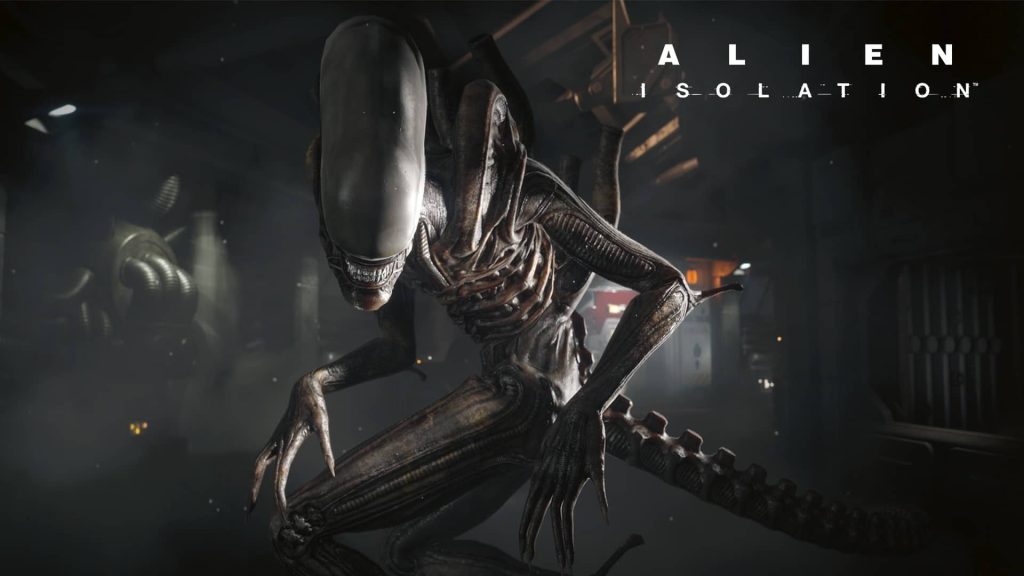
Alien: Isolation
After a disappointing attempt with Aliens: Colonial Marines, newer great tactics Alien: Dark Descent, This older take – Alien: Isolation pleasantly surprised me, so here’s my review!
As a fan of the Alien franchise, I was thrilled to feel my blood rushing as I tried to survive against a ruthless Xenomorph. I must also credit the developers at Creative Assembly, who, despite their lack of experience with this type of game, managed to create the best video game based on Ridley Scott’s renowned film.
The story of Alien: Isolation focuses on Amanda Ripley, the daughter of Ellen Ripley from the original movie Aliens. Based on some information about the missing ship, Nostromo, Amanda decides to join an expedition to investigate the events surrounding the ship’s disappearance. As part of this, Amanda attempts to discover what happened to her mother. But as you can guess, nothing goes according to plan, and the expedition turns into a fight for her life.
The thing is that after arriving at the Sevastopol, which is identical in type to the Nostromo, which stopped at the last coordinates of the missing ship and trying to get on board, an explosion occurs, and you find yourself on board. However, you immediately realize that something is wrong on board. Not only are there barely any lights shining, there are rivers of blood all over the walls and floor and crazy noises echoing around the ship, and the last survivors are defending their lives tooth and nail. Soon, you will also see why the fear of life is sown in the eyes of the entire crew. Of course, you’ll also realize that the company wants nothing more than a living xenomorph organism, and they don’t really care about you.
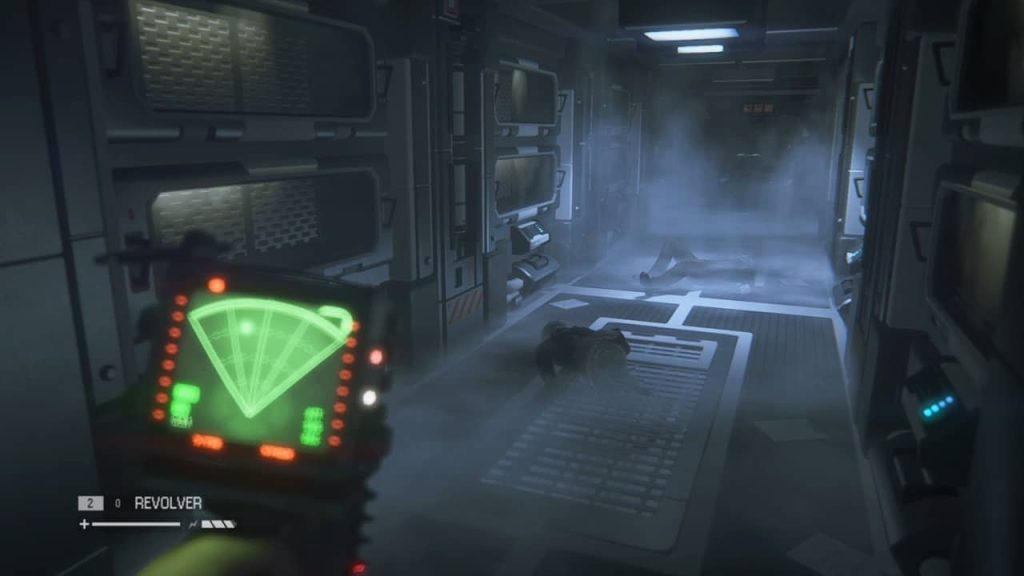
Fear, Anguish, and the Fight for Life
Right off the bat, I must admit that the atmosphere in this adaptation of Alien is really choppy, and you’ll soon find out why. Alien: Isolation is a survival horror in every sense. Much of the credit for this goes to the superbly executed graphic design in which the play of lights and shadows plays a significant role… primarily the shadows. Moving around the corridors of the Sevastopol evokes a sense of anxiety. If you decide to play the game ideally at night, you should prepare your spare underwear and defibrillator. The game even evokes such an atmosphere that after a while, you feel that you are really there and that your life is at stake. But this was only achieved because this game was given more care, and besides the graphics, the game was not brought to such a level by the perfect soundtrack, which takes the atmosphere even further.
I must not forget another important element in the game: the NPC characters, who are also at a reasonable level and fulfill their roles as they should. Even when it comes to the androids of the company, they don’t want anything about the existence of this creature to get out. If you break any company’s orders and visit forbidden areas, these “joes” will destroy you without mercy. And, of course, we have the central character of the game – the Xenomorph. He is finally in this game what he was always meant to be, a ruthless killing machine with high intelligence that is not easy to kill.
Quiet and Careful – The Only Way to Survive
I could basically divide the game into two parts. The first part is before the first contact when you don’t really have to concentrate on not being heard anyway, but believe me, you’ll resort to that anyway with the atmosphere, and then after the first contact with the intruder, when the game takes on a whole different vibe. You must be careful with everything you do because even if the intruder is unknown, you’ll still hear something moving behind you through the vents. Even after you get the motion sensor, you’ll constantly face the fear of where that “black pig” is going to jump out at you.
Thus, in the game, it is crucial to plan your movements, be very careful, and, if possible, not draw too much attention to yourself, as the intruder reacts to noise. What’s also great about the game is that if you lock the room with the intruder with the emergency button by the door, forget about resting. The Alien doesn’t need a door to get into the room, and more than once, I found myself trying to save the game, and more than once, the Alien’s tail ran through my body. Saving here is an entirely different thing from most games. You have to save the game on the so-called phone, where there is also an input to the card, which you insert here and hold for three seconds; during this process, you are highly vulnerable; you can not defend yourself, and you even have a limited view around you.
Enemies – Stupid and Smart at the Same Time
The artificial intelligence in the game works flawlessly most of the time. The human opponents in the game are primarily scared and concerned with their survival; it’s a good idea to avoid direct confrontation if possible, even if you have a revolver or flamethrower later in the game. The intruder isn’t just after you; the crew can be used as bait to escape. However, if you shoot someone, count on the fact that you will not only get the attention of other people but also of the bloodthirsty monster.
Other enemies you may encounter are androids. Right away, it must be said that dragging them with a wrench on the head from behind once is not enough, and from the front, you wound cover. The android stops for a moment, but even after a few moments, it is on the move again. So you’d better avoid confrontation again or use a firearm or flamethrower, but it’s best to save that for the worst bitch present – whoever that is…
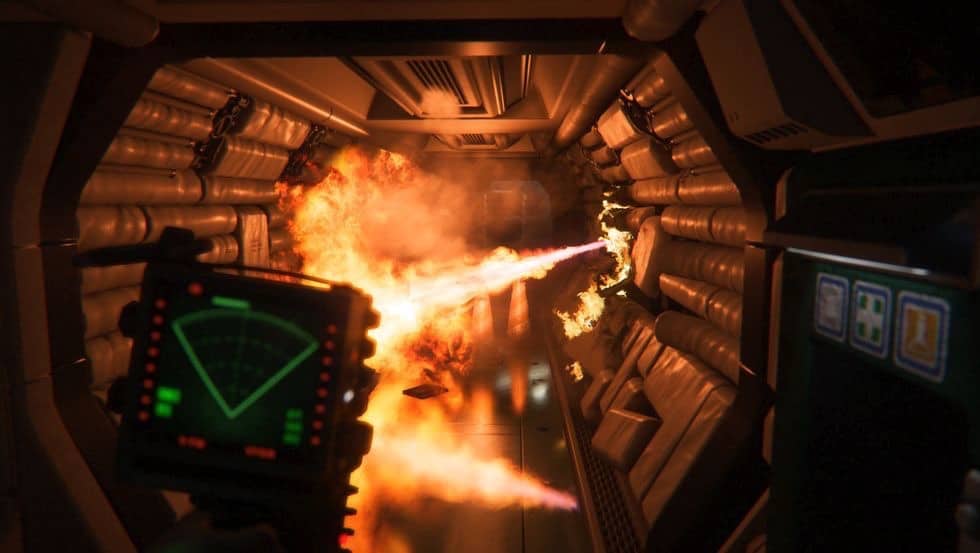
Environment: Manhole to Hide not Enough
Now for the worst part… The Alien here is truly a beast, and directly confronting it means guaranteed death without a flamethrower. If you encounter it, take cover immediately and avoid the noise. Overall, the Alien can react to many things and will find you even in manholes or if you hide in closets, so don’t use the motion sensor as it reacts to his beeps. You can still get around the intruder and hide from it; even if you hide around a corner and the intruder doesn’t look, you can let it go and sneak away.
The developers should also be commended for the fact that the game doesn’t just have you running through corridors and trying to survive by zigzagging between enemies but that you can use the environment to overcome various traps. So, enemies can be bypassed by venting. Hiding under desks, in closets, and various other places. It’s also possible to turn off room lights to let smoke out of the ventilation or unlock and lock particular doors or shafts. Panels on the walls are used for this purpose. In the game, it is also possible to get through locked doors in other ways, such as picking external locks, hacking an electronic lock, or cutting the lock with a plasma torch.
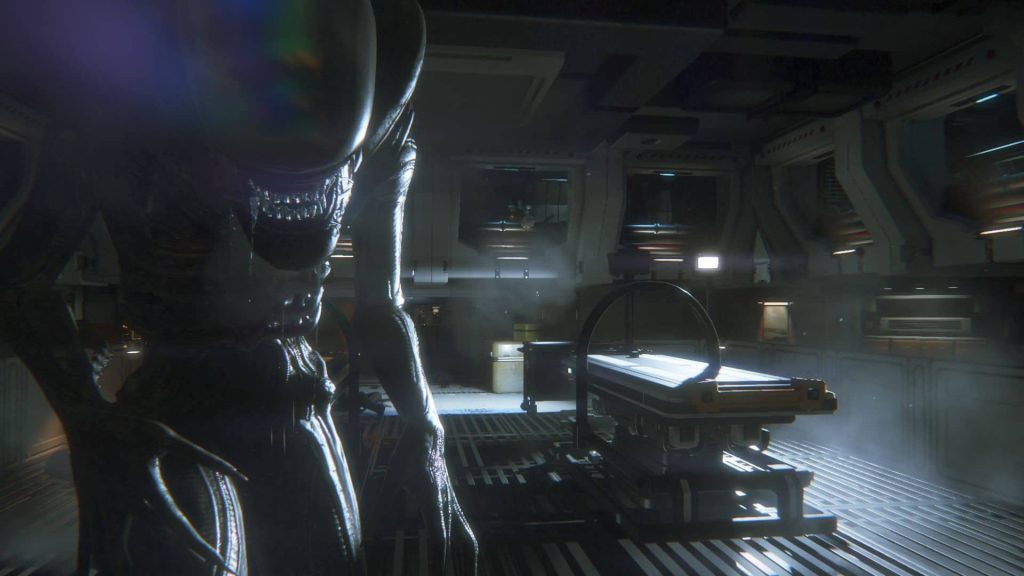
Tools of Alien Encounter and Avoidance
As you navigate through the treacherous landscape, it is imperative that you not only arm yourself with weapons but also learn to craft various toys that can help you survive. These toys include medipacks to heal yourself, smoke bombs to obscure your enemies’ vision, flashbangs to disorient them, electro-mines to shock them, and sound traps to lure them away from your location. To create these items, you must scour your surroundings for materials and conduct diligent research to acquire the schematics or blueprints necessary to build or upgrade them. So, be sure to keep an eye out for useful components and note any valuable information that can aid you in your journey to safety.
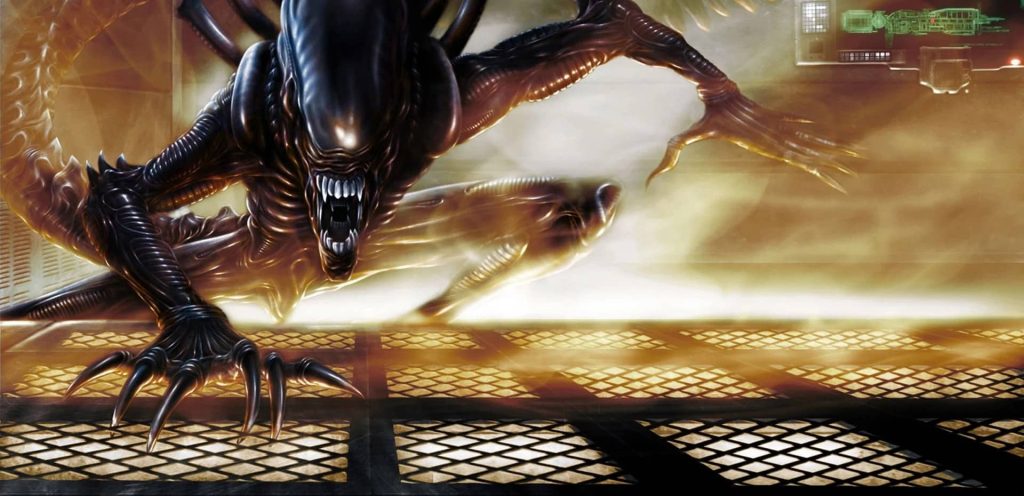
End of Xenomorph’s Pleasure
Alien: Isolation is undoubtedly the best game created based on the legendary movie prequel. It boasts an immersive atmosphere that draws players into the game’s world. The story is well-crafted and keeps players on the edge of their seats as they progress through the game. The game’s terrifying moments are so well-executed that players will feel genuinely stalked by the deadly Xenomorph. The sound design is perfect, with every creak and hiss adding to the game’s suspenseful atmosphere. The stunning visuals, with attention to detail, immerses players in the game’s world. Finally, the Alien is perfected visually and behaviorally, making it a true masterpiece. In short, Alien: Isolation is a dream come true for fans of this alien beast and a must-play for any gamer looking for a thrilling horror and immersive experience.
Where to buy Alien: Isolation
Creative Assembly Website: Alien: Isolation Official Website
Game info page PlayStation Store: Alien: Isolation on Playstation Store (PS4)
Xbox: Buy Alien: Isolation on Xbox
Steam: Alien: Isolation on Steam (PC)
Epic Games Store: Alien: Isolation on Epic Games Store (PC)
GOG Store: Alien: Isolation on GOG (PC)
Nintendo Store: Buy Alien Isolation for Nintendo Switch
The post Alien: Isolation – Excellent Survival Horror and Xenomorph Terror appeared first on WePlayGames.net: Home for Top Gamers.
Returning to Last Of Us Part 1 Remake Review
Title: The Last of Us Part I Remake
Developer: Naughty Dog
Publisher: Sony Interactive Entertainment
Released: September 2, 2022
Platform Reviewed: PlayStation 5
Platforms Available: PlayStation 5, PC
Article Reading Time: 10 minutes
#1 Characters Boost: Deeper Look
Hi, we are here with The Last of Us Part 1 Remake again (with a little break after Review Part 1). First to say what might have slipped under the radar: the subtle yet impactful transformation of character designs. The advanced textures or the fluid animations that seize my interest are the more profound connection to the actors behind these familiar faces, infusing a new layer of authenticity into my journey. Focusing on Tess and Bill, their redesigned appearances echo the real-life actors more precisely. It’s as if they’ve shifted from digital constructs to beings with a tangible presence. This change goes beyond visual enhancement—it breathes depth into their personas, making their trials and victories resonate more profoundly.
Even less prominent characters like Sarah have undergone nuanced changes. Her updated features, though slight, carry her story with an enriched sense of realism. These detailed touches deepen the storytelling, layering each character with a complexity that might have been only suggested in the original game. What makes this Remake stand out is the intricate effort to create visually striking characters that feel remarkably lifelike. Their expressions and interactions with the world have been crafted to narrow the distance between the game and me, the player, drawing me deeper into their stories.
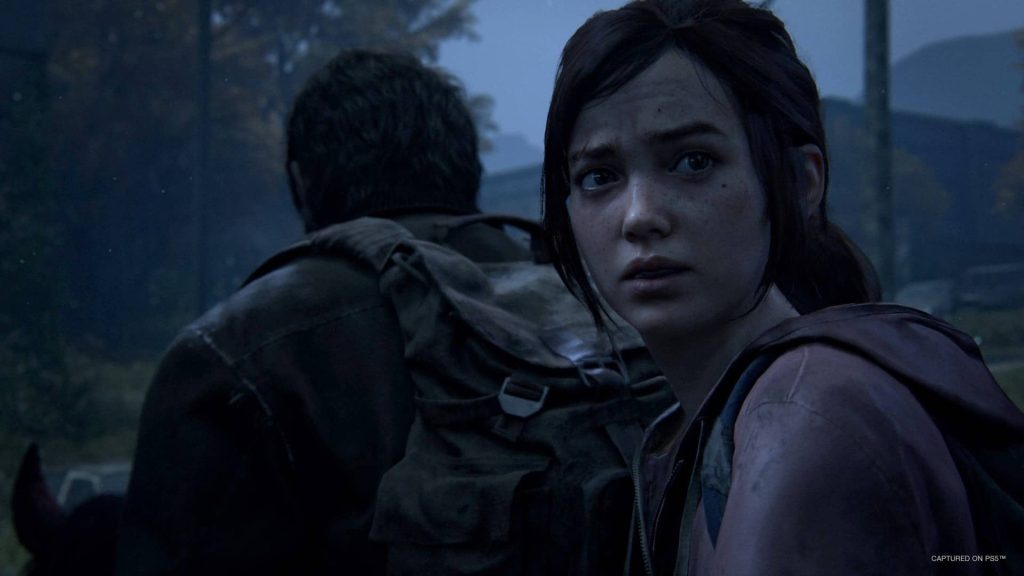
#2 Environment: The Water and The World
Exploring deeper into “The Last of Us Part 1” Remake, the environmental interaction, particularly with water, stands out in its complexity and realism. When I first interacted with water in the game, the experience was remarkable. The splash and ripple effects catch my eye—so detailed and realistic that they momentarily blur the line between play, reality, and how the environment responds dynamically to my presence. Water behaves like it would in the real world. The ripples, the reflections, and how light plays upon the surface create an absorbing atmosphere that fully immerses me in the game’s world.
But the meticulousness goes beyond aquatic effects. The way shadows drape across various textures, the lifelike rust on metal, the movement of foliage in the breeze – these are more than just visual treats. They contribute to a world that’s believably abandoned, overtaken by nature’s reclaiming hand. Walking through this recreated world, I notice these elements merging seamlessly. Each rusted car, each shattered window, and each swath of overgrowth tells a story, adding depth to the game. The environment in “The Last of Us Part 1” Remake is an active storyteller.
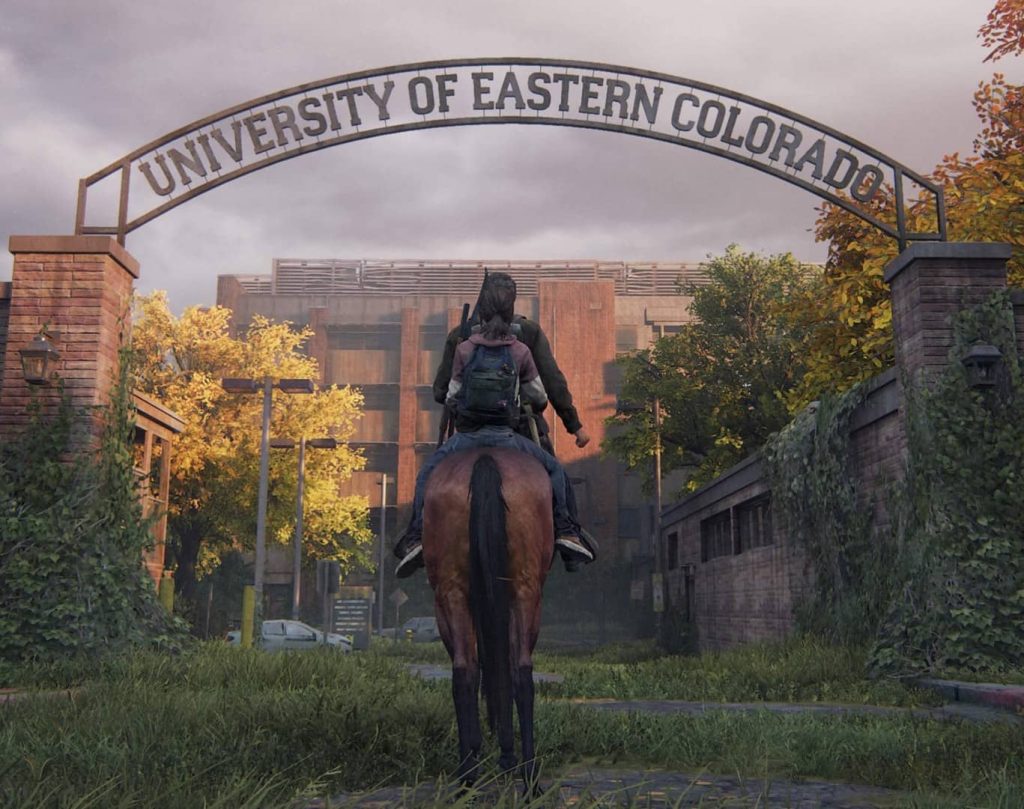
#3 An Unexpected Funny Nostalgia: The Jumping
You know what’s funny? In a game where you can shoot lasers and fight monsters, the way characters jump catches my attention. The developers were so focused on making everything else super fancy that they forgot to upgrade our little pixelated friends. But honestly, I love it. There’s something charmingly old-school about how they jump that takes me back to the days of Mario and Sonic. The game says, “Hey, we know we’re fancy, but we’re not too cool for our retro roots.”
This quirk in movement adds an unexpected layer to the gameplay; it’s hilarious but you love it or hate it. It becomes a humorous nod to the game’s origins, a subtle reminder of where it all began. As I navigate the intricately designed world, the somewhat rigid jumping mechanic is a unique feature, oddly charming in its lack of modern refinement. What intrigues me about this is the balance it strikes in the game’s overall feel. Amidst the lush visuals and deeply immersive tale, the jumping is a slice of gaming history, an element untouched by time. It’s a part of the game that never fails to make me chuckle – a playful peculiarity in an otherwise intensely realistic experience.
#4 Interface and HUD: A Seamless Integration
Progressing further into “The Last of Us Part 1” Remake, I’m drawn to the interface and HUD elements, which have undergone significant transformation. This redesign is more than just an aesthetic change; it’s a functional enhancement that melds seamlessly with the game’s overall experience.The new interface’s elegance and subtlety first struck me. Menus, inventory screens, and HUD elements have been redesigned to be more intuitive and less intrusive. This streamlined approach allows me to immerse myself deeper into the game, with crucial information displayed in a way that feels organic and part of the game world.
What impresses me most is the balance achieved between accessibility and minimalism. Essential information is conveyed clearly without cluttering the screen, keeping me engaged in the game’s story and environment. This careful design ensures that the HUD enhances rather than distracts from the gaming experience.
In addition, the incorporation of accessibility features into the interface is notable. The options provided cater to a broad range of players, ensuring that more gamers can experience the story without barriers. It’s a commendable step towards inclusivity in gaming, allowing for customization based on individual needs and preferences.The inventory management system, too, is sleek and efficient. Navigating through items and gear is smooth, contributing to a gameplay experience that feels polished and refined. These elements work together to keep the game’s flow uninterrupted, maintaining the tension and pacing essential to the story-building.
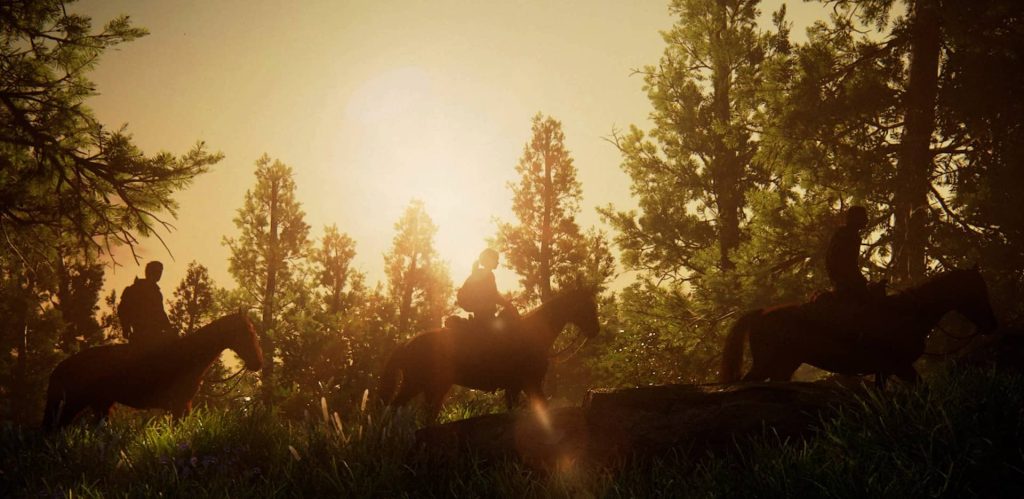
#5 Clickers: A New Challenge
The most notable change is the Clickers’ enhanced use of echolocation. They now employ it more frequently and effectively, covering a wider range in their detection. This adjustment compels me to rethink my stealth approach. I no longer can rely solely on past strategies; I must adapt to their heightened awareness and agility.In my exploration of “The Last of Us Part 1” Remake, the Clickers present a renewed challenge that significantly alters how I approach these iconic enemies. This evolution in their AI is not just a technical improvement; it’s a strategic shift that revitalizes the gameplay experience.
What strikes me is the increased pace and intensity when encountering Clickers. They are faster and more aggressive, demanding a more dynamic response. Stealth still plays a crucial role, but now, there’s a greater emphasis on timing and spatial awareness. Each encounter becomes a tense, calculated game of cat and mouse, where a single misstep can lead to a swift and brutal end.This shift in the Clickers’ behavior enriches the gameplay, adding a layer of urgency and unpredictability. Navigating through areas infested with them requires a more tactical mindset. It’s a refreshing change that tests my skills and thrills the experience.
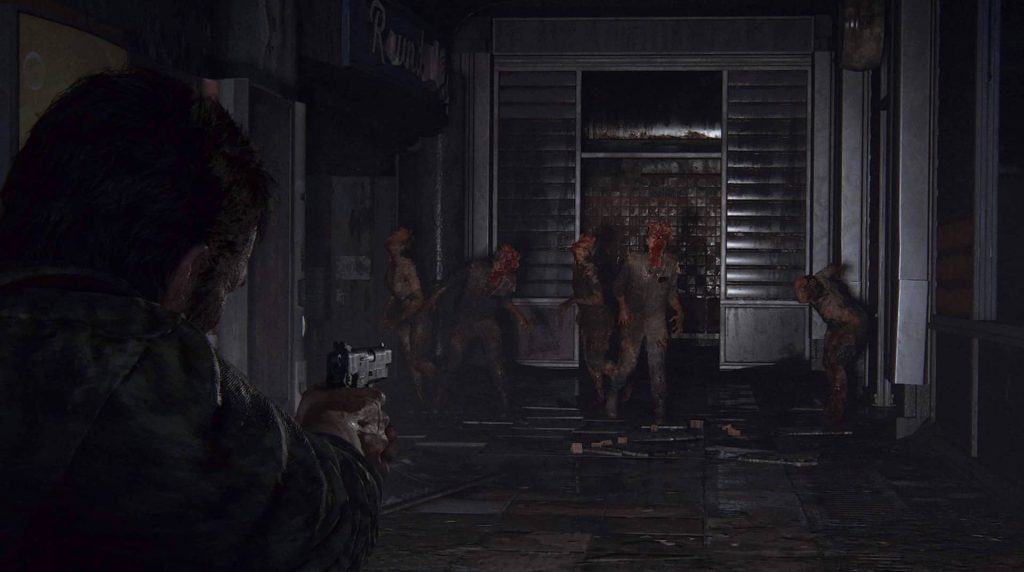
#6 Lurking Cordyceps: The Stalkers’ Tactics
One of the most noticeable alterations in Stalkers is their behavior pattern. They now exhibit a more observant and calculating approach, lurking in the shadows and attacking only when I get too close or provoke them. This change forces me to be more cautious and strategic in my movements, as recklessness can quickly lead to being overwhelmed. Nuanced behavioral changes in Stalkers add a new dimension of tension to the game. No longer are they straightforwardly aggressive; they now add an element of unpredictability and suspense to each encounter. They are playing a waiting game, turning each stealth segment into a high-stakes tactical challenge.
This evolution in Stalkers’ behavior amplifies the stealth aspects of the game. It encourages me to take a more thoughtful and deliberate approach, carefully planning each move and staying alert to my surroundings. The suspense is palpable, making for an exhilarating and nerve-wracking experience. The changes in Stalkers’ AI highlight the developers’ efforts to create an engaging and diverse combat experience. By introducing these subtle yet impactful tweaks in enemy behavior, the game successfully maintains the thrilling and unpredictable nature of encounters, ensuring that even seasoned players of the original game find new challenges to overcome.
#7 Audiovisual Enhancements
The sound design, in particular, has received a remarkable boost. The use of 3D audio technologies provides a truly impressive level of auditory immersion. Every footstep, distant echo, and environmental sound is rendered with such precision that it feels like I’m navigating through the post-apocalyptic world. This auditory richness adds a new layer of realism and presence, enhancing tension.
Visually, the game is a marvel. The leap in graphical quality is immediately noticeable. The textures are more detailed, the lighting is more natural, and the game’s atmosphere is more evocative and lifelike. This visual enhancement is crucial in telling the game’s story through cinematic sequences and every gameplay frame. Ruined cities and overgrown nature are depicted with a fidelity that makes the environment a character in its own right.
What’s truly remarkable is how these audiovisual elements combine to create a haunting and beautiful atmosphere. They enhance critical moments in the story, amplifying the emotional impact of each scene. The careful orchestration of sound and visuals deepens the connection between the player and the game, making every encounter, every exploration, and every story twist more impactful.
#8 Constraints and Opportunities
The core gameplay mechanics retain much of their original form, notably the combat and exploration elements. This consistency offers a comforting familiarity, especially for those who have played the original game. However, it also becomes apparent that there were opportunities for further innovation that remained unexplored.
One particular area that stands out is the combat system. While it maintains the original’s tension and strategy, incorporating more dynamic and fluid mechanics could have enhanced the combat encounters, offering a fresh challenge to both new players and veterans of the series. Moreover, the environmental interaction within the game, although visually stunning, occasionally shows limitations in dynamism. While beautifully rendered, the world sometimes feels like a series of breathtaking backdrops rather than interactive spaces where more dynamic events could unfold.
#9 Synthesizing Perspectives: Closing The Review
As my review “The Last of Us Part 1” Remake comes to a close, I reflect on the multitude of enhancements and the faithful preservation of the original game’s essence. This Remake has been an intricate blend of old and new, a familiar and true but refreshingly new journey.
The meticulous attention to detail, the profound enhancements in audiovisual quality, and the subtle yet impactful changes in character design and enemy behavior have all contributed to a renewed experience of a beloved classic. These elements have made my next take through the post-apocalyptic world of “The Last of Us” fully enjoyable.
Yet, in this rediscovery, the untapped potential is acknowledged. While the Remake excels in many areas, it also reveals further innovation and development opportunities. The unchanged aspects, such as specific gameplay mechanics and the linearity of environments, ground the game in its roots and suggest possibilities for future exploration and improvement in the series after Last of Us 2: Remastered – which was recently released.
Purchase Last of Us Part 1 Remake at:
- Naugthy Dogs Website: Landing Page
- PlayStation Store: Last of Us Part 1 Remake (PS5) on PlaystationStore
- Steam : Last of Us Remake (PC) on Steam
- Epic Game Store: Last of Us Remake (PC) on Epic Games Store
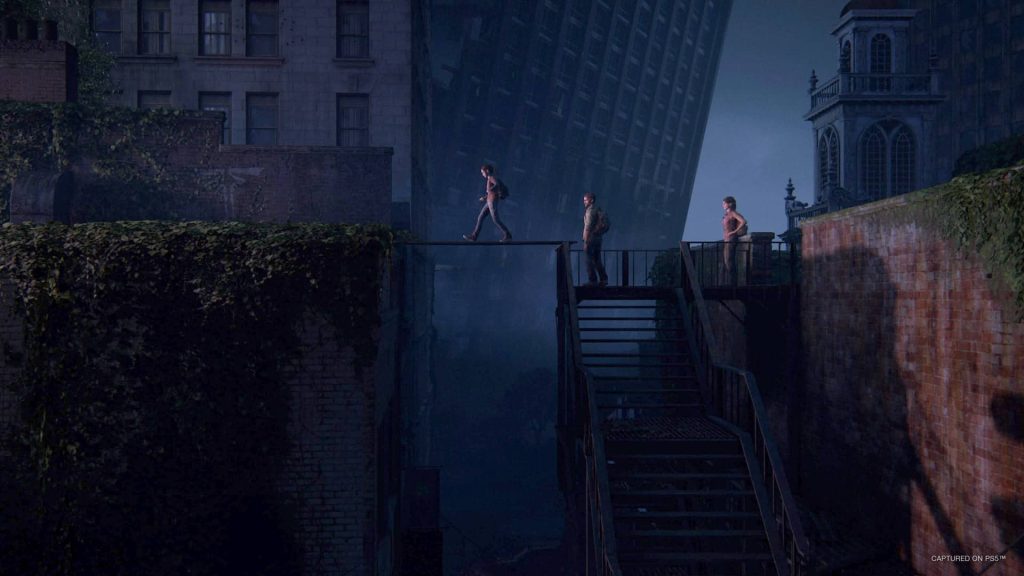
The post Returning to Last Of Us Part 1 Remake Review appeared first on WePlayGames.net: Home for Top Gamers.
The Callisto Protocol: Brave Leap Beyond Dead Space
Title: The Callisto Protocol
Developer: Striking Distance Studios
Publisher: Krafton
Released: December 2, 2022
Platform Reviewed: PlayStation 5
Platforms Available: PlayStation 5, PlayStation 4, Xbox Series X/S, Xbox One, PC
Article Reading Time: 9 minutes
Dead Space Reminiscence
The author of the legendary hardcore action Dead Space, Glen Scofield, has returned to where he feels at home, in the Callisto universe. The plot here, as in his previous masterpiece, is bravura and is more cinematic than Dead Space, which the game shows you right at the very beginning when you are blown away by perhaps the most beautiful graphics I have ever seen in games up to that point. .. the main character played by Josh Duhamel looks just like him, unreal, the sound here also went further than it ever has been, this sound is just precise and it absolutely mesmerized me, the soundtrack and ambient music was also absolutely incredible… As I said, and I have to say again, audiovisually, it totally blows you away to the universe, except for Callisto… The story is Dead Space-like again… you suspect nothing, things happen to you, and you find yourself in a prison where more and more and more things happen to you, but it all gets beautifully rendered, and it all makes sense by the end.
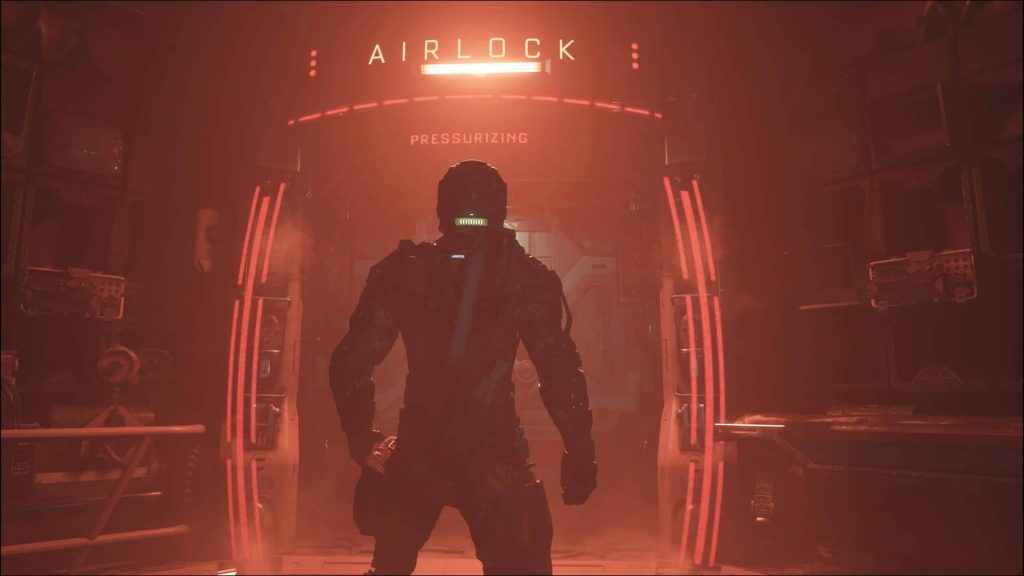
Into the Story
The game takes place in the year 2320, when the main character, Jacob, and his partner, Max, work for the UJC (United Jupiter Company) and deliver their last shipment. Then, with this job, they want to jump ship and enjoy their retirement. Only a woman named Dani gets on their boat with a so-called Terrorist Unit and damages the ship. Jacob has to make an emergency landing and asks for permission to land, which is denied, but the ship is so damaged that a landing/crash is inevitable. Leon Ferris – the prison’s chief security officer – gets him out of the boat and makes sure everything goes as it should… only Jacob has broken landing protocol and has the Terrorists with him – so he gets his prison number and goes behind bars. The player then discovers what the prison and Jacob actually are. The other characters have a place here; none are random NPCs.
The game has no HUD, and everything is on the main character. It’s explained perfectly, which I liked more than on the DS, where it “just is.” Since the game is in prison, it doesn’t have firearms like the DS but close combat, which is absent in the DS.
Monsters in Environment
The monsters are also explained; their origins are revealed as you play, and everything falls into place. Since there are really few bullets and weapons, most of the monsters are literally smashed to pieces.. no really, that’s not a typo, but really totally smashed to pieces, arms, legs, heads, guts, blood all flying all around you and Jacob is covered in blood throughout the game, the only part where he’s clean is in the sewers. Thanks to the excellent haptics, You can feel the weight of every punch in the controller. It’s a shame to shoot someone here because you’re just setting yourself up for a bloodbath. The firearms here are classics, from pistols to shotguns and submachine guns. What’s missing here is some BFG, but I understand we’re in a prison.
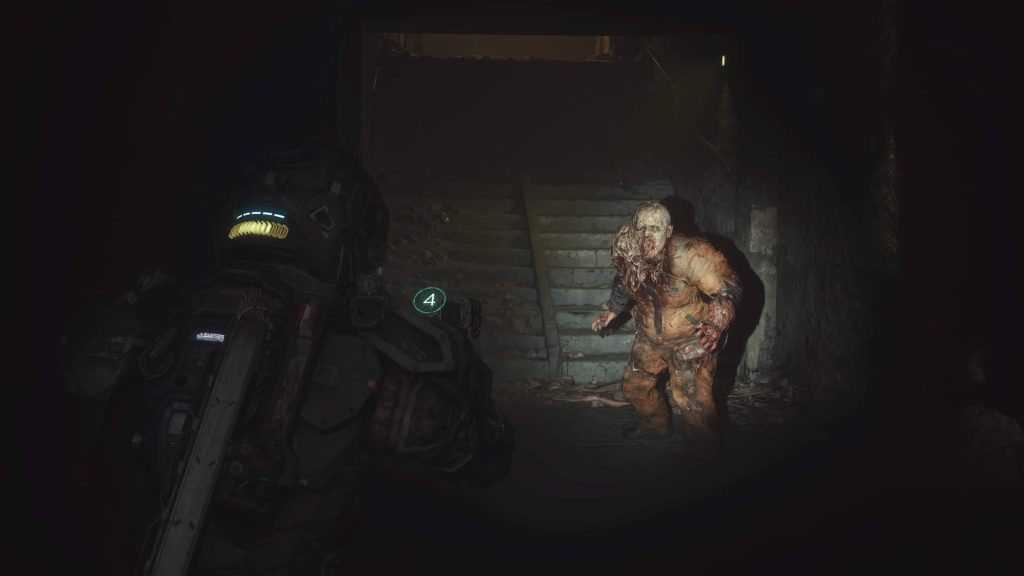
The environment is a dark prison, which is very well-designed and well-interwoven. There are paths outside the story, but this is where I see the first negative of the game – the orientation around the environment. I understand that Glen wanted to make this as hardcore as possible and that you are in prison in the unknown. Still, the lack of a map or signposts to where the main story goes and where it doesn’t is just a wrong move. It probably doesn’t matter, but with my illness, collecting everything the game has to offer is quite a problem as you can’t go back; there’s no chapter or chapter selection; you just miss something and have to go there in ng+, and hope you remember where to go. This, for me, is not a problem anymore, I’ve played the game a few times, and it’s exactly the type of game like DS or RE where the first playthrough takes around 10-15 hours, and you can do the game in 4-5-6 hours. Another negative is the absolutely unfeeling level splitting. There are actually 8 chapters in the game, but it still needs to be done like the DS. Here, you just play you open a door or go in somewhere, and the screen goes black, and it writes the chapter name and throws you behind the door. I don’t understand why it can’t be done with the feel of the DS that you go through the door, and the chapter is written on the screen, and you move on; here, it’s just like that… Recycling puzzles, mostly finding something, putting it somewhere to unlock the next part, and so on, where it feels like a missed opportunity for a more elegant solution.
Heat Goes Up
But high praise goes to the second part of the game, where you look outside the prison and even discover the original colony, reminiscent of the legendary Last of Us passage – the dungeon with the elevator. Here, you’re in awe, and how it’s done and explained is just a huge thumbs up. This is precisely why one plays horror games. The game gives you a solid feeling of unease and discomfort that you will carry for a long time…
In an environment with a worse design and a heartless chapter ending, we should now look at another weakness: monsters, unfortunately…
There are so few of them in the game, not that there isn’t something to bash. Still, I mean, the variation could be counted on one hand… the monsters are disgusting and pretty simultaneously, but they are desperately few. Later in the game, there is the so-called mutation mode, where each monster mutates into something that is always supposed to be original, but the reality is that the mutations are all the same. Saying that the game is epic and spectacular compared to the DS is a fact. There are epic scenes, but mostly some escape scenes or exploding things. As for the monsters, there are maybe two or so, and then the game introduces you to its biggest bastard, which is awe-inspiring. The combat is really luxurious, but again, the illogical recycling of the monster, where the game puts it in the arenas over and over again and ruins the feel of the beast completely, and it can be seen as laziness or lack of time to do quality work with the game. Another laziness and annoying element is the constant recycling of jump scars using a single monster; I’m telling you, you’ll hate that damn pop-up head and curse the developers for years after you’ve finished playing; this is true laziness and recycling, perhaps Ubisoft does with Assassin’s Creed and Far Cry.
The game recycles monsters, jump scares, and even the shafts are annoying because when you see it, you know what’s coming next. Launching through the sewer and riding the “slide” was fun for the first minute, but when that scene lasts literally 5minutes you tap your forehead and don’t understand why… for the first playthrough it doesn’t even matter. You don’t notice it as much, but when you play the game multiple times, you just can’t help but notice it.
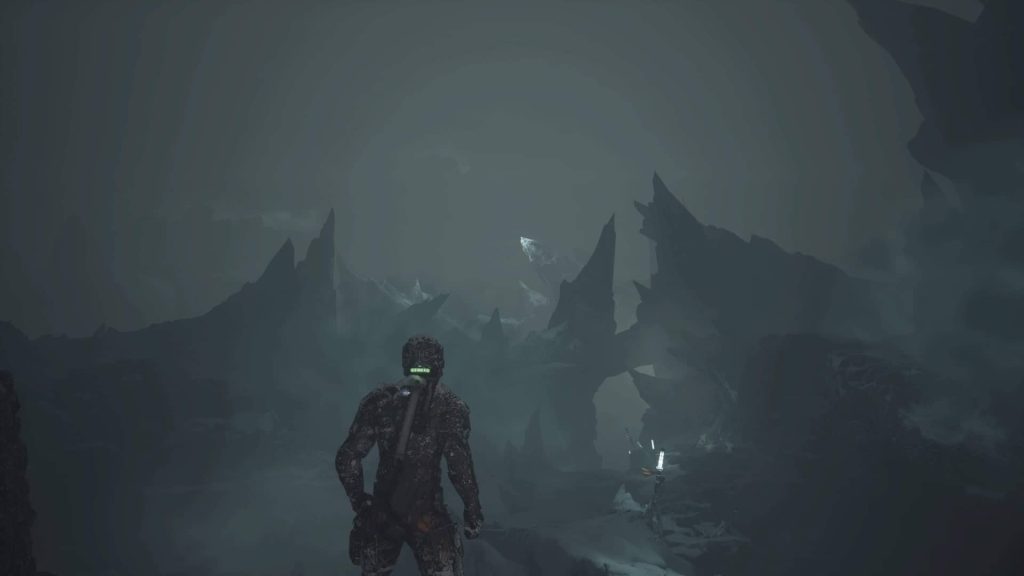
Err..the Difficulty
The other problem is the difficulty. The game has a choice of 3 difficulties – so you could grade the combat into 3 options for your suffering and Jacob’s suffering.
– on the easiest difficulty you will survive three mistakes. On medium difficulty, two errors and the most challenging difficulty will punish you after more than one slightest mistake, you will get a second hit, and you are dead… personally, I don’t mind this. I like more challenging games, and this is precisely what I want. Moreover, the get-good rule applies precisely to this game; you will learn the moves of the enemies and the combat system and go through the game like a terminator, destroying everyone without the slightest problem. You learn it’s not until you become a “master.” The combat works by locking yourself into a combo with a monster and using the move lever to do dodges. It works great. Some criticism when there were more monsters was that it didn’t work very well, but the opposite of what others may say is true… it works great. It works exactly the same as with one monster, only there are two, and you have to concentrate more and give combos after 2-3 shots, wait, block, dodge 1-3 shots, help myself with the shotgun, and voila… I walk away without a single wound. Weapons are created here using the prison printer, upgrades, and inventory, like DS; again, there is no HUD. Everything is integrated into your character. You still have a glove to help you grip, and you can throw the monsters around the room as you please, and the best way to do that is to stow them away in a fan or “meat grinder.”
Have a good taste!!!
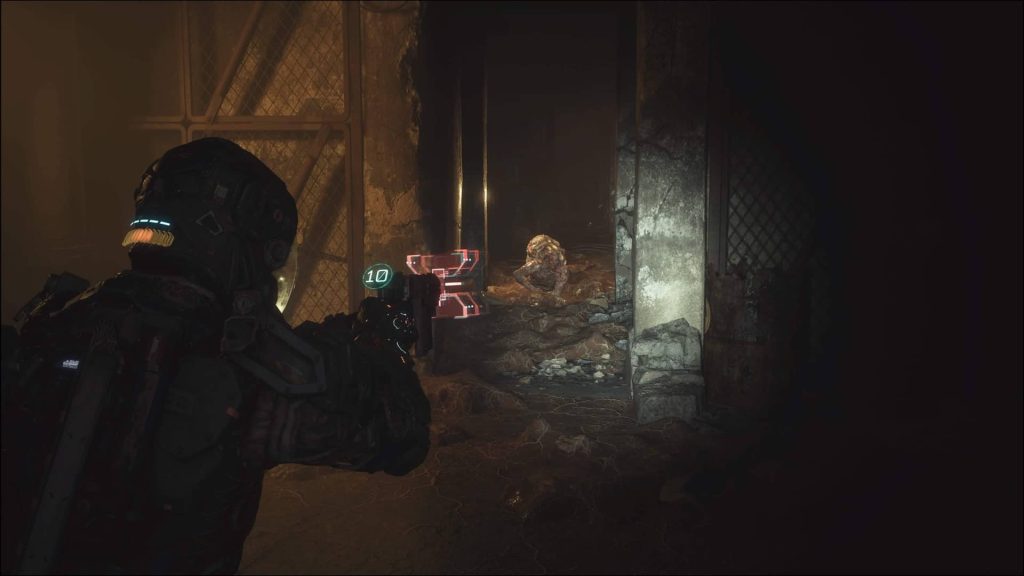
Jacob
I would also like to praise the main character, Jacob; I find him well-acted; his emotions and expressions underline precisely what is happening; his voice is your guide, his anger your engine. Then, the Divine Dani is one of the best pairings in the gaming world since Joel and Ellie. And if there was a poll for the most sweaty and astonishing game, Jacob… I mean, Callisto would win it on all fronts… The best part is Jacob’s reactions to everything that happens to him and his expressions, plus how he’s covered in various mud, blood, and other crap all the time… I FUCKING HATE THIS PLANET! As Jacob would say…
I believe that Callisto did well, but the expectations were unrealistic. The fact that Glen Scofield came back and created a new world that is pretty similar to the one in Dead Space and the overall feel of the game is like playing a close combat dead space for which Glen took quite a bit of heat, but if you are a die-hard fan of horror and quality horror with a good story, Callisto is the game for you, it’s not a revolution or anything more than Dead Space. However, it’s still a quality title in the genre that goes its own way while taking a lot from its predecessor and even surpassing it in some places, and I don’t mean the audiovisual treatment.
Last Rites
I am sorry to hear that the game did not fulfill the sales, and probably the sequel will not be made… but I will pray that it will be announced at some point because there are very, very few games like this…
When you do not have enough good reads on survival horror games, follow with review on Last Of Us Remake for PlayStation 5.
Purchase The Callisto Protocol at:
- Striking Distance Studios Website: The Callisto Protocol – Official Page and Blog
- PlayStation Store: The Callisto Protocol – PlayStation Store
- Xbox Store: Buy The Callisto Protocol | Xbox
- Steam: The Callisto Protocol on Steam
- Epic Games Store: Search for “The Callisto Protocol” on the Epic Games Store
The post The Callisto Protocol: Brave Leap Beyond Dead Space appeared first on WePlayGames.net: Home of Top Gamers.
The Last of Us Remake for PlayStation 5: Review Part 1
Title: The Last of Us Part I Remake
Developer: Naughty Dog
Publisher: Sony Interactive Entertainment
Released: September 2, 2022
Platform Reviewed: PlayStation 5
Platforms Available: PlayStation 5, PC
Article Reading Time: 17 minutes
#1: Long-Awaited Revival of Last Of Us Part 1 (2022)
Stepping into the remastered world of “The Last of Us Part 1” for the PlayStation 5 in our 2-part review, I’m immediately struck by the sheer leap in visual and auditory fidelity. It’s a transformation that breathes new life into this post-apocalyptic saga’s familiar yet hauntingly desolate landscapes. The integration of raytracing, 4K upscaling, and 3D sound doesn’t just enhance – it revolutionizes the player’s experience, immersing them in a world where every detail, from the subtlest ray of light to the distant echo of a crumbling city, contributes to an enveloping sense of realism.
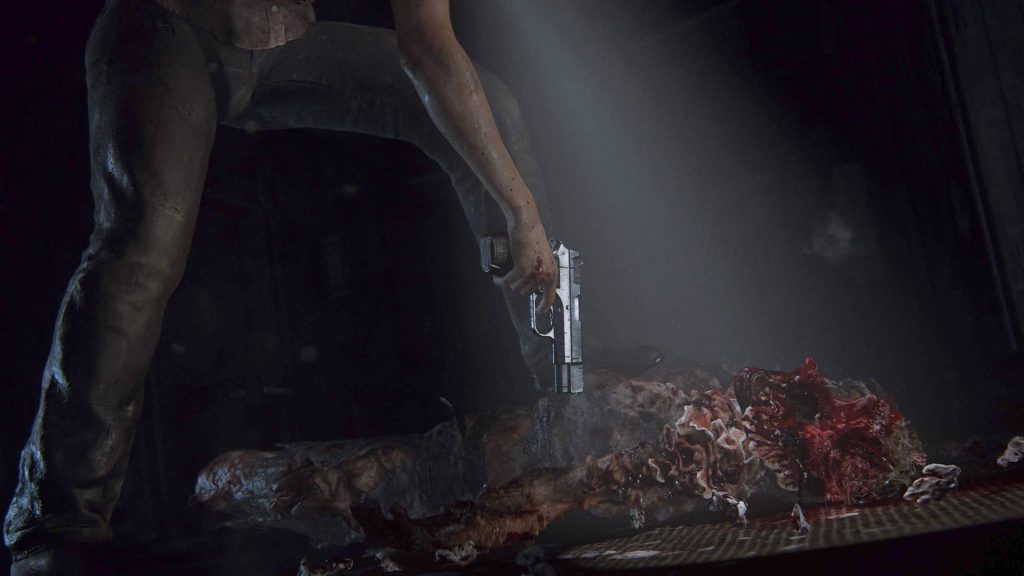
The characters, the beating heart of this epic tale, have undergone a profound transformation. The redesigned faces of Tess and Bill, aligning more closely with their voice actors, infuse a deeper level of authenticity into their personas. This attention to detail in character design transcends cosmetic enhancement; it’s a step towards bridging the gap between digital and natural, making their struggles, emotions, and journey feel more tangible and heartfelt.
However, amidst these advancements, the gameplay mechanics, although polished, bear the weight of the original’s legacy. The unchanged framework, particularly evident in the jumping mechanics, feels at odds with the game’s visual progressiveness. These moments, though few, are stark reminders of the game’s origins and highlight areas where innovation could have propelled the experience further.
Despite these lingering shadows of the past, the Remake stands tall as a beacon of technological prowess in the gaming industry. The union of groundbreaking visual and audio enhancements with the profoundly engaging story of “The Last of Us” is challenging the potential of modern gaming.
#2: Our Beloved Characters
The true essence of a character in a game lies in their actions or dialogue in the subtleties of their expressions and the depth of their emotions conveyed through each facial movement. This is where “The Last of Us Part 1” remake on PS5 truly shines a lot.
The faces of Tess and Bill, now closely mirroring their voice actors, bring a newfound authenticity to the stage of the story. It’s as if the characters have stepped out of the digital realm and into reality. Sarah’s redesigned features and the nuanced alterations in Joel and Ellie’s appearances go beyond cosmetic changes. They reflect the evolution of their stories, the emotional weight of their journey, and the passage of time.
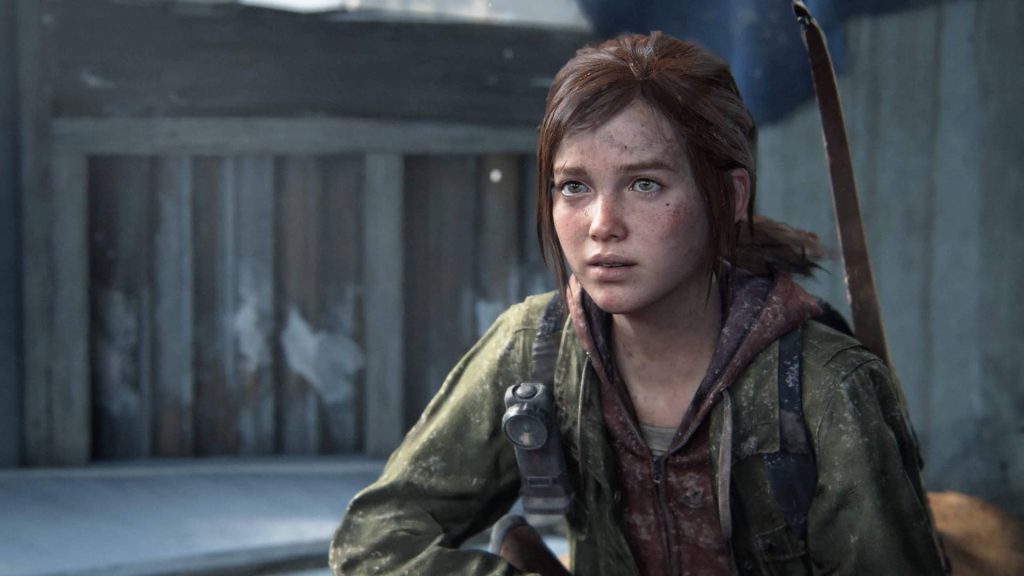
This reinvention of characters extends to the smallest of details. Subtle changes in expressions during critical moments add layers of emotional depth. The furrow of a brow, a faint smile, a glance filled with fear or determination – these are the details that transform the characters from mere digital constructs into believable, relatable individuals.
Such meticulous attention to character design elevates the tension and enhances the player’s emotional investment in the story, making every decision, every loss, and every triumph feel intensely personal. This chapter is a tribute to the artistry and technology that have merged to bring these characters to life in an unprecedented way in the series.
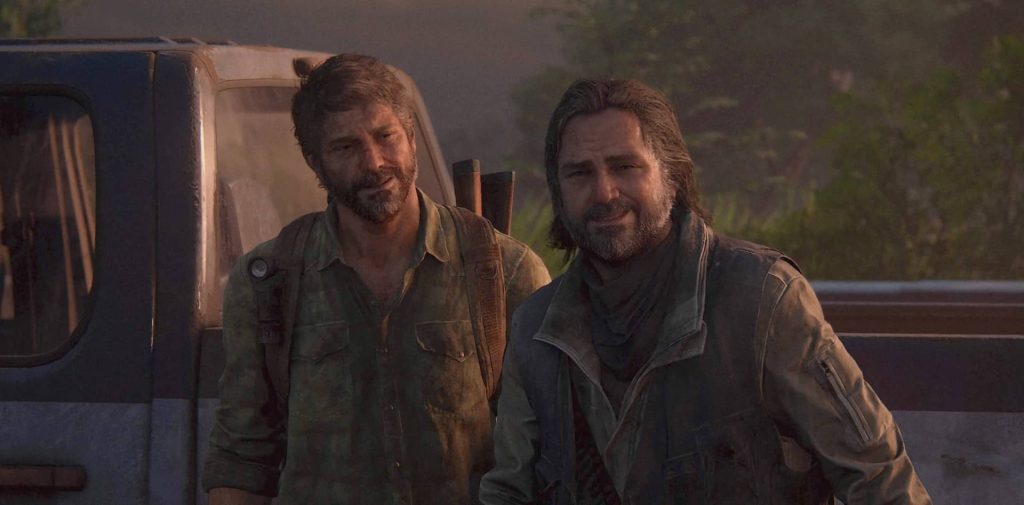
#3: From Old to New, But Really?
In “The Last of Us Part 1” remake for PS5, gameplay mechanics receive a treatment that’s a mix of reverence for the original and a nudge towards modern sensibilities. It’s a delicate balance, maintaining the essence that fans love while injecting elements that resonate with today’s gaming expectations.
The gameplay’s core remains unchanged, true to the strength of the original design. This consistency provides a familiar ground for fans of the original game. However, this fidelity to the original also means that certain aspects, like the platforming and puzzle-solving elements, retain their original simplicity and limitations.
But it’s in the details where the Remake really differentiates itself. Close combat feels more fluid and responsive, with more refined and brutal animations reflecting the harsh reality of the game’s world. The way characters move and interact with the environment has been subtly enhanced, lending a more natural feel to navigation and exploration.
What’s particularly commendable is the Remake’s approach to accessibility. By incorporating a range of options designed to make the game more accessible to players with different needs, the Remake broadens its appeal without diluting the core gameplay experience. These features are seamlessly integrated, ensuring that they enhance rather than distract from the gaming experience.
#4: Crafting a Post-Apocalyptic World Again
In the PS5 remake of “The Last of Us Part 1,” the environment plays a crucial role in storytelling. The post-apocalyptic world is not just a backdrop for the narrative; it’s a character in its own right, teeming with stories told through crumbling buildings, overgrown streets, and abandoned relics of a world that once was.
The graphical enhancements of the PS5 bring a new level of depth to these environments. The attention to detail is meticulous – from how light filters through broken windows to the realistic textures of rusted cars and weathered buildings. This heightened realism makes the world more immersive, inviting players to explore and discover the hidden stories.
The level design has been carefully crafted to guide players through the game. Each location is more than a setting for the subsequent encounter or puzzle; it’s a piece of the story, offering insights into the world’s downfall and the lives of those who inhabited it. This design choice enriches the gaming experience, turning exploration into a journey of discovery.
However, while the Remake excels in visual storytelling, it also inherits some of the original game’s limitations. The environments, though stunning, occasionally lack interactivity. This missed opportunity for more dynamic interactions limits the potential depth of immersion.
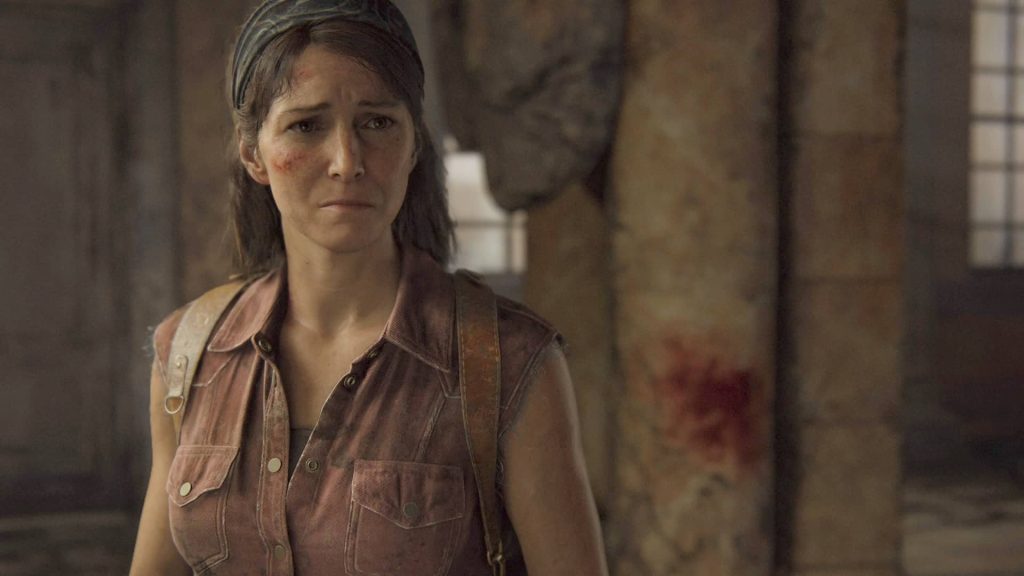
#5: Enemy Dynamics: A New Breed of Threat
The game introduces an evolved approach to enemy dynamics, significantly altering the player’s combat experience. This evolution is most evident in the behavior of the Clickers and Stalkers, two of the game’s most iconic adversaries.
Clickers, the game’s notorious blind infected, have undergone a transformation. In the original, their threat was formidable but predictable. In the Remake, they are faster, more aggressive, and use echolocation more effectively. This change makes encounters with Clickers a more intense experience. Their heightened aggression and speed force players to rethink their strategy, shifting from the original’s stealth-focused approach to a more dynamic and reactionary one.
Stalkers, another enemy type, also receive a notable update. In the original game, they were aggressive but straightforward in their attacks. The Remake enhances their AI, making them more cunning and unpredictable. They now observe from a distance, only engaging when the player is within reach, adding a new layer of tension to their encounters.
These changes in enemy AI do not just make for more brutal battles; they enrich the gameplay by requiring players to adapt and think independently. However, these improvements also highlight some inconsistencies. The new behaviors, designed with the fluid mechanics of the sequel in mind, occasionally clash with the more rigid framework of the original. This clash is particularly noticeable in higher-difficulty settings, where strategic planning is crucial.
#6: Arsenal Evolution: Reforging the Tools
The arsenal and weapon upgrade system receive significant enhancements, adding a new layer of depth to the combat experience. This chapter delves into these changes, examining how they impact gameplay and player strategy.
The Remake expands the weapon upgrade system, offering a more comprehensive range of options. Each weapon now boasts multiple upgrades, extending beyond the original’s capabilities. For instance, reload capacity and firing rate can be incrementally improved, allowing players to tailor weapons to their playstyle more precisely. This granularity in weapon customization adds to the gameplay depth and encourages players to engage more with the game’s resource management aspect.
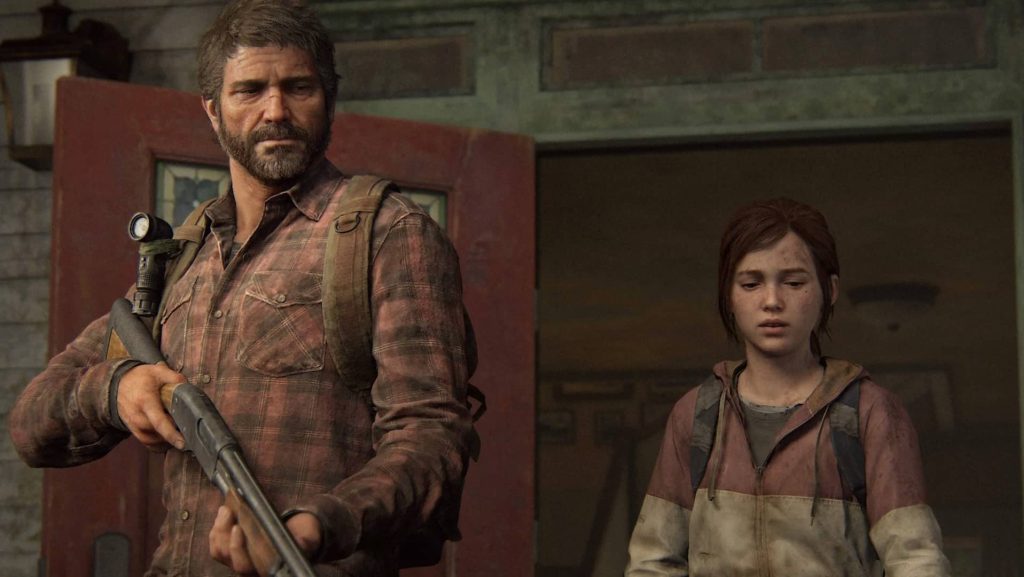
The process of upgrading weapons is a meticulous affair. The animations associated with weapon modifications are detailed and varied. When Joel is working on a gun, the player can see him disassembling and reassembling parts, adjusting components, and making tangible modifications. Some animations are quick and practical, while others are lengthier, reflecting the complexity of the upgrade. This attention to detail enhances the immersion, making upgrading weapons feel more tangible and rewarding.
However, it’s about more than just the visual and mechanical upgrades. The Remake’s arsenal changes also impact the combat dynamics. Players can adapt to the enhanced enemy AI more effectively with more versatile weapons. The expanded options allow for a broader range of combat strategies, catering to different playstyles, whether it’s a stealthy approach or a more confrontational one.
#7: Post-Apocalyptic Dynamics”
The environmental design plays a crucial role in creating an immersive post-apocalyptic world. This chapter delves into how the game’s settings are not just passive backdrops but active elements that contribute significantly to the gaming experience.
In the Remake, the environments are meticulously detailed, showcasing the power of the PS5. The enhanced graphics render every ruin, every overgrown street, and every dilapidated building with striking realism. This attention to detail is not just for visual appeal; it plays a vital role in storytelling. The environments convey the passage of time and the impact of the pandemic, telling silent stories of the world that were and the desolation that followed.
However, the game does more than visually enhance these environments; it integrates them into the gameplay mechanics. For instance, how light filters through broken windows or how water flows in a flooded street isn’t just aesthetically pleasing and affects how players navigate and strategize within the game. These elements can reveal hidden threats or provide cover, influencing the player’s approach to exploration and combat.
The Remake also introduces more interactive elements within the environments. While the core locations remain faithful to the original, added details like destructible barriers and interactive objects allow for a more dynamic experience. These additions encourage players to explore and interact with the world more deeply, discovering resources and secrets that add to extra to the gameplay.
Despite these enhancements, there are opportunities for further interaction that could be improved. While visually stunning, the environments often retain the original game’s corridor-like structure, limiting the player’s ability to fully engage with them. This constraint is a reminder of the game’s origins and adherence to the original framework.
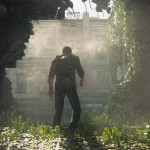
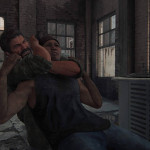
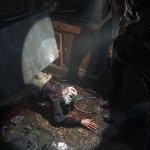
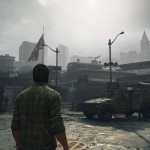
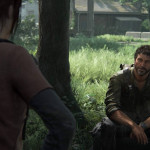
#8: AI Evolution of Enemy Encounters
In the “Remake,” the enemy AI and their behavior patterns present an intriguing aspect of the game’s evolution. This chapter explores how the enemy encounters have been enhanced, contributing to a more challenging and immersive experience.
It also brings noticeable improvements to enemy AI, making them more unpredictable and challenging. Clickers and Stalkers, the game’s iconic infected enemies, are faster and more aggressive. Their behavior is more dynamic, employing strategies like flanking and coordinated attacks, significantly heightening the game’s tension and difficulty. This change in AI behavior demands players to adopt more strategic approaches to combat rather than relying on the patterns familiar from the original game.
Particularly notable is the evolution of the Clickers. In the original game, they were formidable yet somewhat predictable foes. In the Remake, they use echolocation more frequently and effectively, making stealth a more challenging and essential aspect of gameplay. The Stalkers, too, have undergone a transformation. They now observe and stalk the player from a distance, only attacking when the player gets too close or provokes them. This change adds a layer of psychological suspense to the encounters, as players must be constantly aware of their surroundings.
However, these enhancements in AI behavior occasionally clash with the game’s original design elements. For instance, the more aggressive AI in the Remake sometimes feels constrained by the game’s linear level design, built around the original’s more straightforward enemy patterns. This discrepancy can lead to moments where the game’s challenge feels artificially inflated rather than organically integrated.

#9: A World Reborn
The environments are nothing of static backdrops; they are dynamic elements that contribute significantly to both the narrative and the gameplay experience. This chapter explores how the enhanced environmental design in the Remake adds depth and realism to the post-apocalyptic world.
The first striking aspect of the remade environments is their visual fidelity. The leap in graphical quality from the original game is immense. Textures are more detailed, lighting is more natural, and the overall atmosphere is more immersive. This visual enhancement is not just cosmetic; it actively contributes to the storytelling. Ruined cities, overgrown with nature, tell a story of a world that has moved on from humanity. Each location is filled with remnants of the past, from abandoned homes to deserted streets, evoking a sense of loss and nostalgia.
The level design has also seen improvements. While the core layout of the areas remains faithful to the original, subtle changes have been made to enhance exploration and interaction. The environments are more open, offering multiple paths and encouraging players to explore. This openness not only adds to the realism of the game world but also provides more strategic options in combat and survival scenarios.
Environmental interactivity has been enhanced as well. Players can now interact with more objects, from opening drawers to moving obstacles. These small interactions add to the world’s believability and provide a deeper level of immersion.
One area where the game could have pushed further is in environmental reactivity. While the world is beautifully rendered and offers more significant interaction, it still lacks a certain level of dynamism. The environment rarely reacts to the player’s actions, missing an opportunity to make the world feel truly alive.

#10: Emotions in Movement and Expression
In “The Last of Us Remake,” the animation is pivotal in bringing the characters and the world to life. This chapter delves into how advancements in animation have enriched the game’s overall experience.
The Remake has significantly upgraded the animations, making them more fluid and realistic. These improvements are most noticeable in the characters’ facial expressions and body movements. The facial animations are particularly striking, with each wrinkle, smile, or frown adding depth to the characters’ emotions. This level of detail in facial expressions allows for a more nuanced portrayal of characters, enhancing the storytelling by conveying unspoken feelings and thoughts.
Body movements are also more natural and responsive. The way characters interact with the environment, such as climbing over obstacles or sneaking through tight spaces, feels more believable. Combat animations have received a notable upgrade, with more varied and realistic movements. This makes the combat more visually engaging and impacts gameplay, as players need to adapt to the more dynamic movements of both allies and enemies.
However, the animations have their shortcomings. Some legacy issues from the original game persist, like specific repetitive motion patterns that can break the immersion. While these moments are few, they are noticeable in contrast to the otherwise high standard of animation.
In combat, the improved animations add a new layer of strategy. Enemies react more realistically to being hit, and the enhanced animations provide more evident cues for players to respond to. This makes combat encounters more intense and rewarding, as players need to be more observant and reactive.
#11: Enriching the Core Story
The gritty story of “The Last of Us” has always been its strongest suit, and the Remake takes this to a new level. The story remains unchanged, but the way it is presented benefits significantly from the technological advancements of the PS5. Enhanced graphics and animations bring a new depth to the characters and settings, making the story more immersive and emotionally impactful.
The script has been carefully revised to suit the enhanced visuals and audio capabilities. Dialogue delivery is more natural, thanks to the improved voice acting and facial animations. This improves the emotional depth of the characters, making their struggles and relationships more relatable and impactful.
Environmental storytelling is another aspect where the Remake excels. The game’s world is rich in details that tell their own stories. Every element adds to the narrative, from the remnants of life in abandoned buildings to how nature reclaimed the cities, creating a believable post-apocalyptic world.
One of the most significant improvements in the Remake is how the story addresses the original game’s themes. Issues like survival, moral ambiguity, and the human cost of a decimated world are presented with greater depth and nuance. The game challenges players to think about their decisions and consequences, adding a layer of moral complexity to the gameplay.
#12: Orchestral: The Sound of the End
In the Remake, the sound design takes a significant leap forward. 3D audio on the PS5 platform creates an immersive soundscape that significantly enhances the player’s sense of place and urgency. Sounds play a crucial role in gameplay, with the direction and distance of noises helping players navigate the dangerous world and detect threats.
The music in “The Last of Us Remake” remains excellent, but the same. The compositions are masterfully crafted, balancing haunting melodies and tense rhythms reflecting the game’s emotional journey. The soundtrack complements the visual upgrades, adding depth and amplifying critical moments in the story.
The game employs music strategically to underscore pivotal scenes and enhance the mood during exploration and combat. This careful use of music helps to create a more emotionally engaging experience, drawing players deeper into the game’s world.
Moreover, the Remake leverages the PS5’s capabilities to deliver more transparent and dynamic audio. This enhances the realism of the game world, from the rustle of leaves in an abandoned city to the distant growls of infection; each sound adds to the game’s tense atmosphere.
However, while the audio enhancements are notable, they don’t fundamentally change the game’s original score. The familiar tracks are reinvigorated but remain faithful to the original composition, providing a sense of continuity for those who have played the original game.
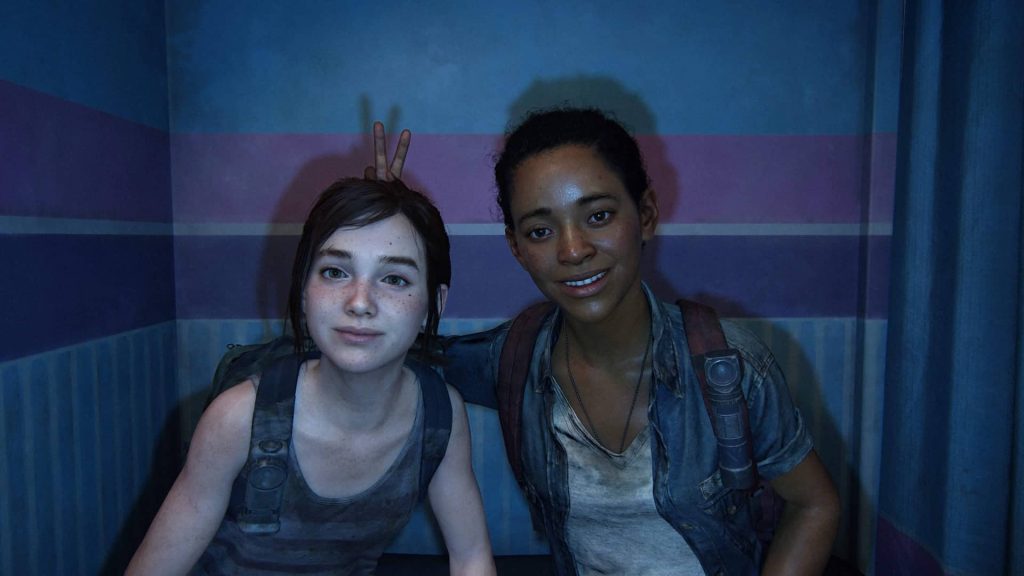
#13: Accessible Apocalypse: Gaming for Everyone
One of the most commendable aspects of the Remake is its extensive array of accessibility features. These features accommodate players with different needs, including visual, auditory, and motor disabilities. The game offers customizable controls, subtitles with adjustable sizes and colors, and audio descriptions, among other options. This level of customization ensures that more players can enjoy the game without barriers.
The Remake also includes a variety of difficulty settings, allowing players to tailor the gameplay experience to their preferences and skill levels. This isn’t just about making the game more accessible for those who want a more casual experience; it’s about making it accessible to those who might find the standard difficulty settings prohibitive.
Another notable feature is the attention to auditory cues and haptic feedback. For players with visual impairments, the game provides enhanced sound cues that help navigate the game world and detect threats. The haptic feedback on the PS5 controller adds another layer of sensory input, aiding players in understanding their environment and the game’s context.
Despite these advancements, some players have noted areas where the Remake could improve regarding accessibility. For instance, more detailed customization options for specific types of color blindness could enhance the experience for affected players.
…And a Little Break Now
Guys, this is it for now with Ellie and Joel. Next time, we will tell you something funny we found. What will be our verdict on the Remake, you think?
Jump on the second part of the Last of Us Part 1 Remake Review, or read our other recent review of another fantastic but different survival horrors – The Quarry or Callisto Protocol.
The post The Last of Us Remake for PlayStation 5: Review Part 1 appeared first on WePlayGames.net: Home of Top Gamers.
Check out the new Alone in the Dark teaser, plus PC specs revealed
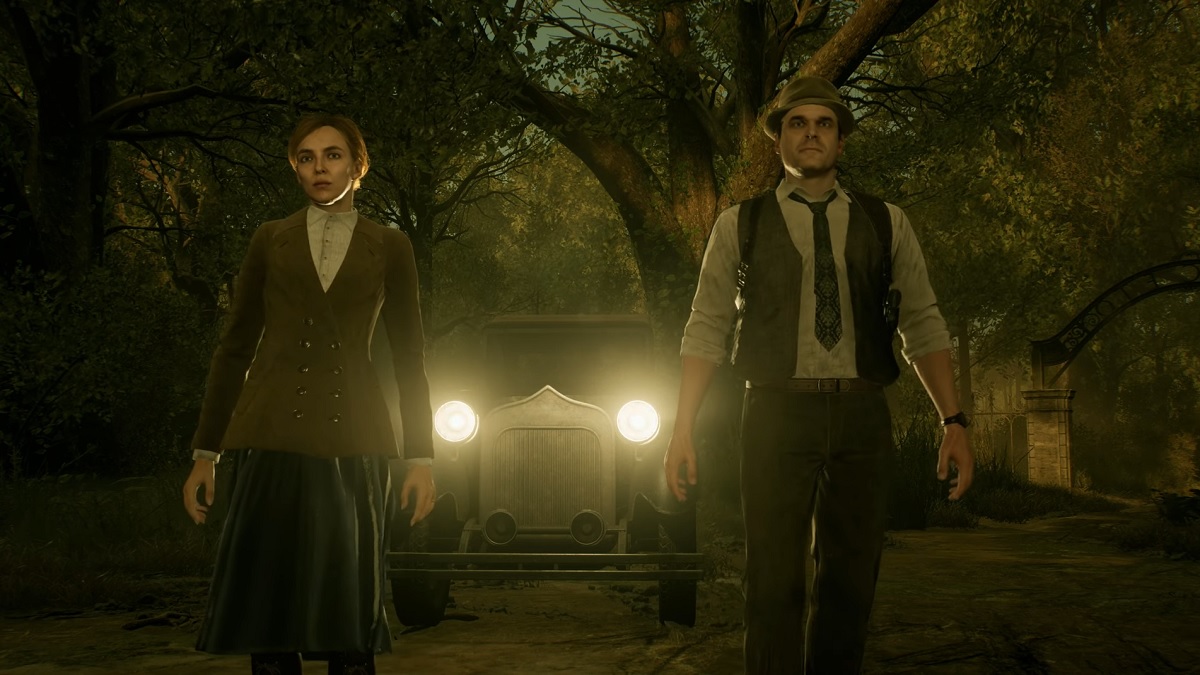
Derceto Manor is where we return for our scene, in the upcoming reboot (again) of Alone in the Dark. In the latest teaser shown by publisher THQ Nordic, we get some hints of plot, some talking points from Emily and Edward's respective voice actors, and we now have the hardware specs for PC.
The new trailer once again leave survival horror fanatics hungry for more, as we take a quick peek at the reimagining of this classic. Actor David Harbour – who voices Edward – talks about his love of games that let you "choose your own adventure," while Jodie Comer – AKA Emily Hartwood – is impressed by how "fully fleshed out" the characters are.
We also get to hear from Mikael Hedberg, Alone in the Dark's writer and director, who some of you will know through his work on Amnesia and SOMA (this is honestly one of the reasons I'm so excited for the game). Hedberg likens the new reimagining to a classic "haunted mansion" story, so it was imperative the team were able to recreate the atmosphere Derceto Manor is known for.
Hardware? I hardly knew her
You can also see the requirements for the PC version over on Steam. A lot of mid-range systems should be okay with running it at minimum specs. You definitely won't need a current-gen Nvidia or AMD graphics card, that's for sure.
Alone in the Dark is scheduled to release on March 20, after a delay last year pushed it beyond its originally intended release last October. It was then delayed a second time in order to avoid any Christmas crunch for the team before finally landing on this now-definitely-for-realsies launch date.
For those who want a little bit of nostalgia with their rebooted survival horror, there's going to be a 1992 filter that brings back the low-poly models of the 1992 original. Because nothing says blood-curdling mystery like pointy shoulders.
Alone in the Dark full PC specs
Minimum
- Requires a 64-bit processor and operating system
- OS: Windows 10, 64 Bit
- Processor: Ryzen 3 3100 / Core i3-8300
- Memory: 8 GB RAM
- Graphics: GeForce GTX 1050 Ti / Radeon RX 570
- DirectX: Version 12
- Storage: 50 GB available space
- Additional Notes: SSD recommended
Recommended
- Requires a 64-bit processor and operating system
- OS: Windows 10, 64 Bit
- Processor: Ryzen 7 3700X / Core i5-12400
- Memory: 16 GB RAM
- Graphics: GeForce RTX 2060 / Radeon RX 5700 XT
- DirectX: Version 12
- Storage: 50 GB available space
- Additional Notes: SSD recommended
The post Check out the new Alone in the Dark teaser, plus PC specs revealed appeared first on Destructoid.
Alone in the Dark release date, trailers, story, and gameplay
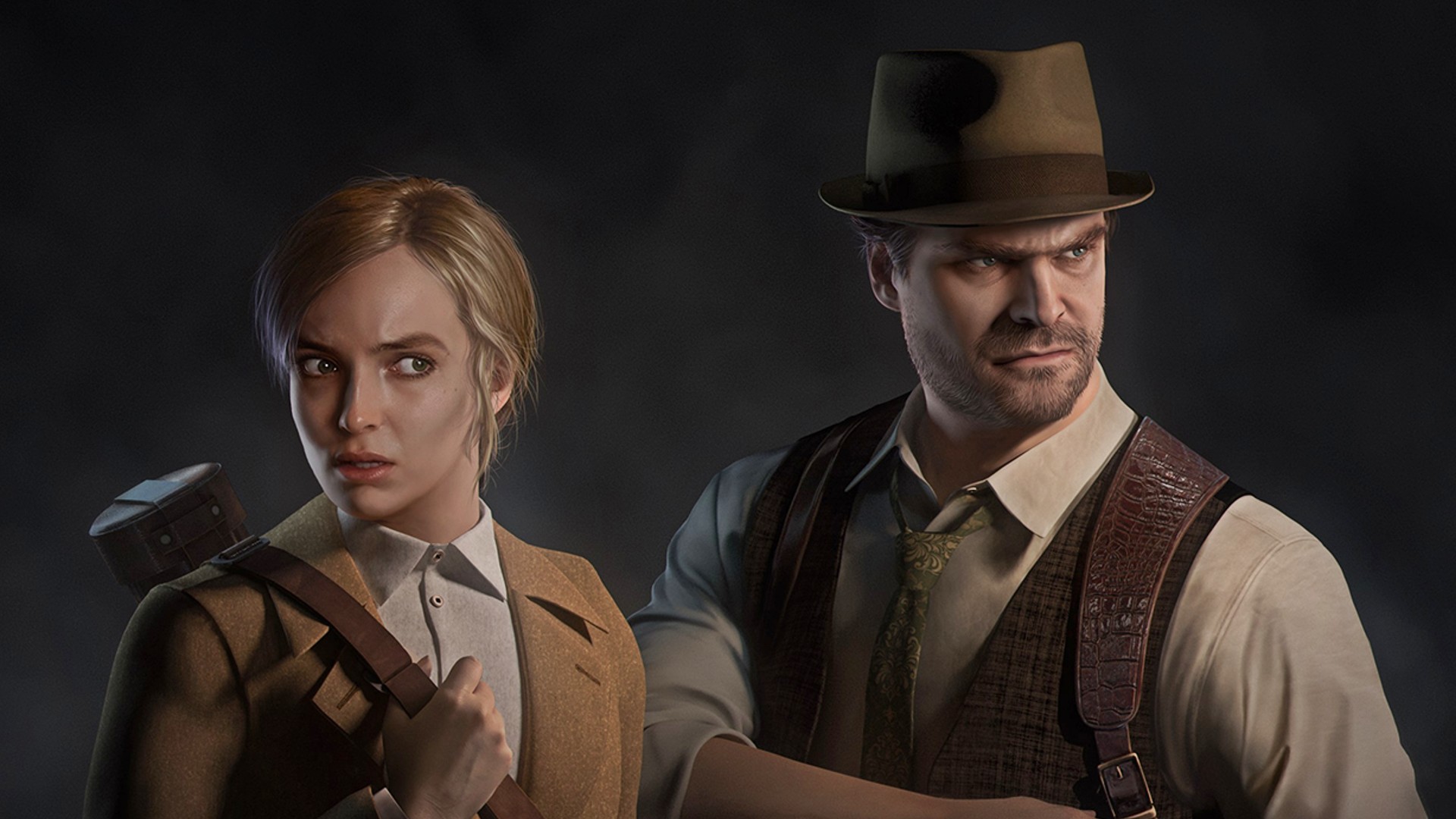
When is the Alone in the Dark release date? Survival horror has been going through a bit of a renaissance in recent years, so it’s high time that we bring back the one that started it all. After a 16-year hiatus (no, we’re not counting Illumination), Alone in the Dark has emerged from the shadows in the form of a rebooted reimagining, and we’ve got all the details on the release date, news, and story to get you up to speed.
2024’s Alone in the Dark is a love letter to Frédérick Raynal’s original game of the same name, which rose to critical acclaim following its release back in 1992. It’s often hailed as the grandfather of survival horror, having inspired the development of Resident Evil – and, by proxy, all the survival horror games thereafter. However, the days of MS-DOS are long gone, and developer Pieces Interactive has breathed new life into this classic experience with modern-day graphical fidelity and Hollywood A-listers. Here’s everything we know ahead of the Alone in the Dark release date.












